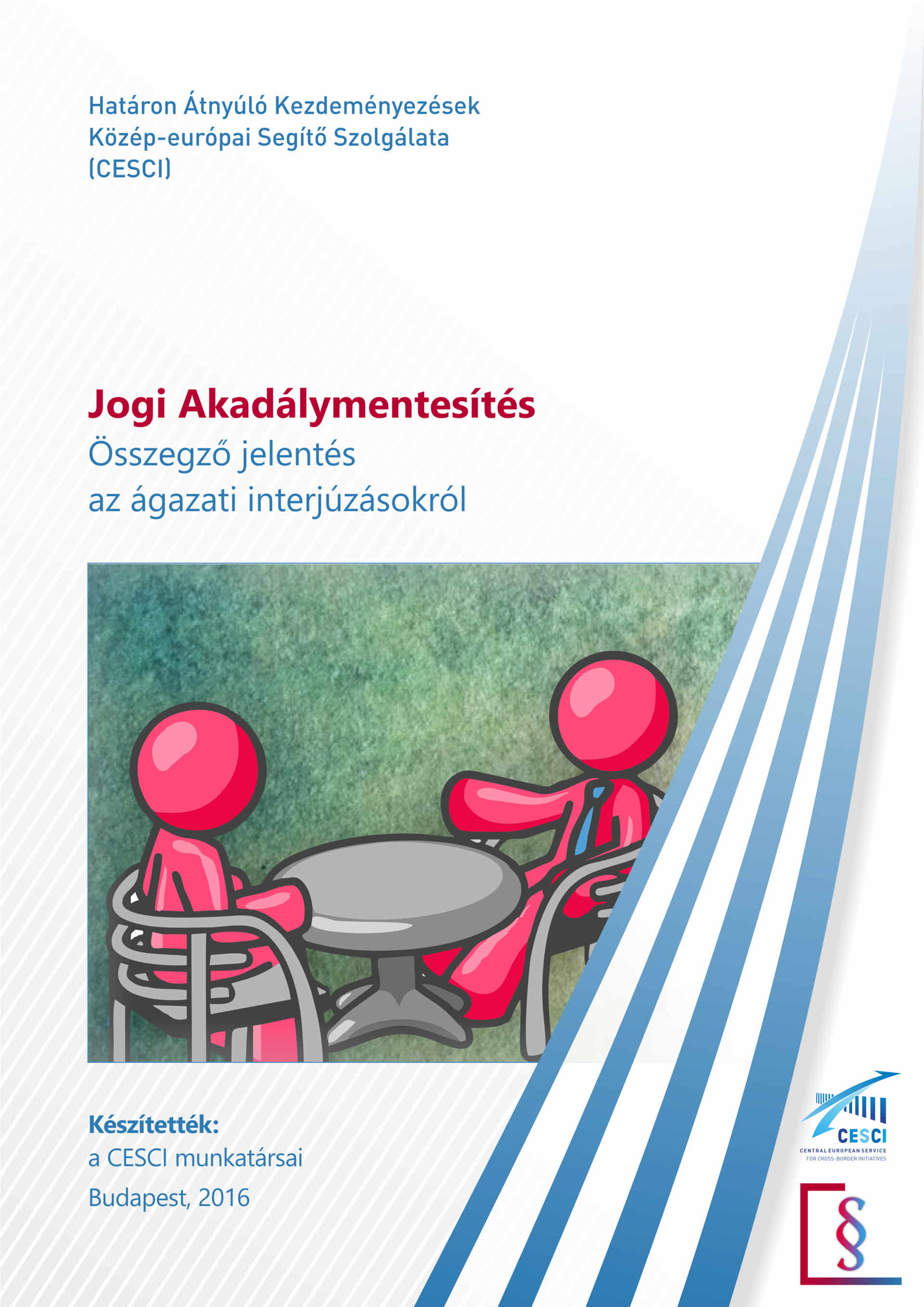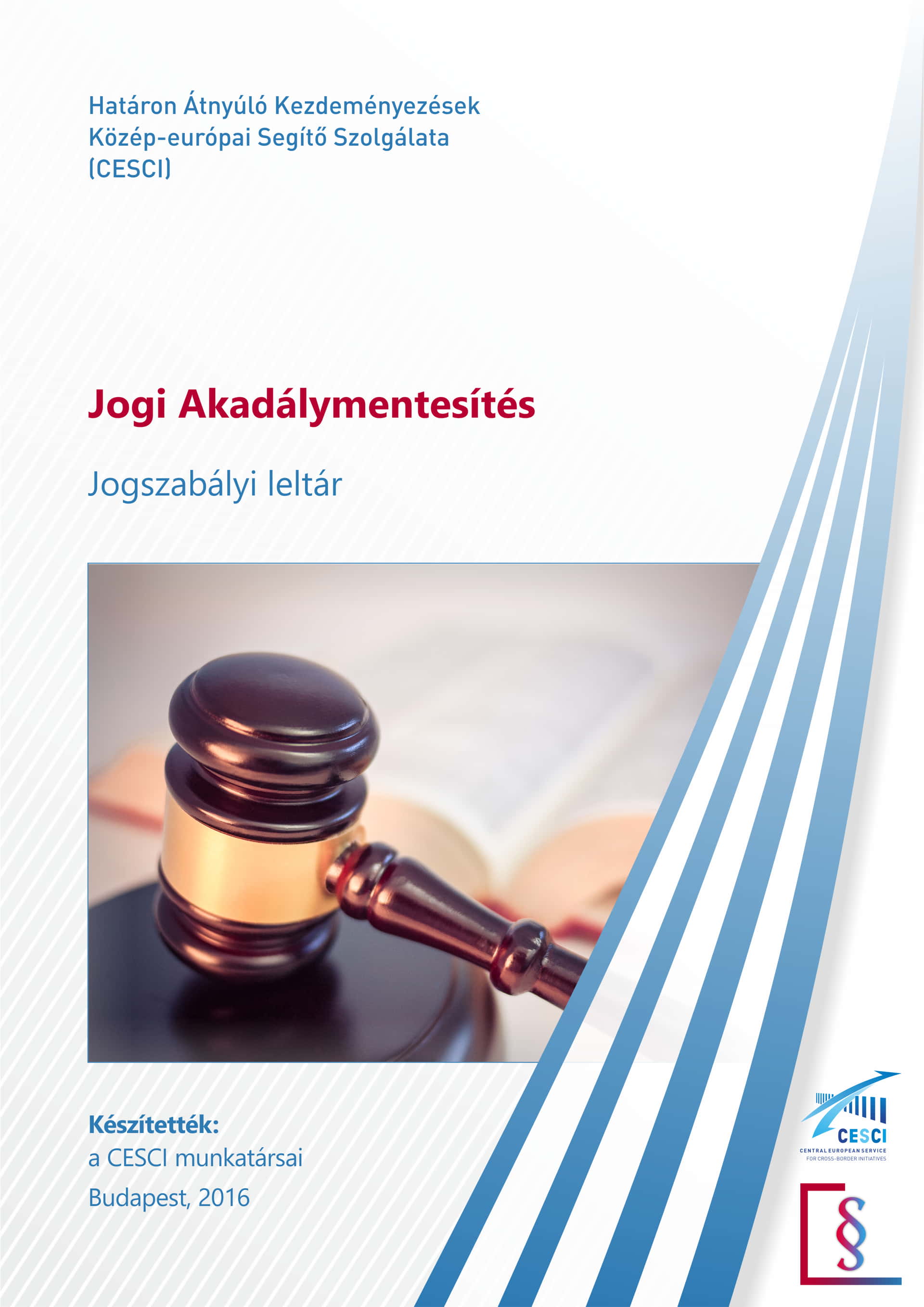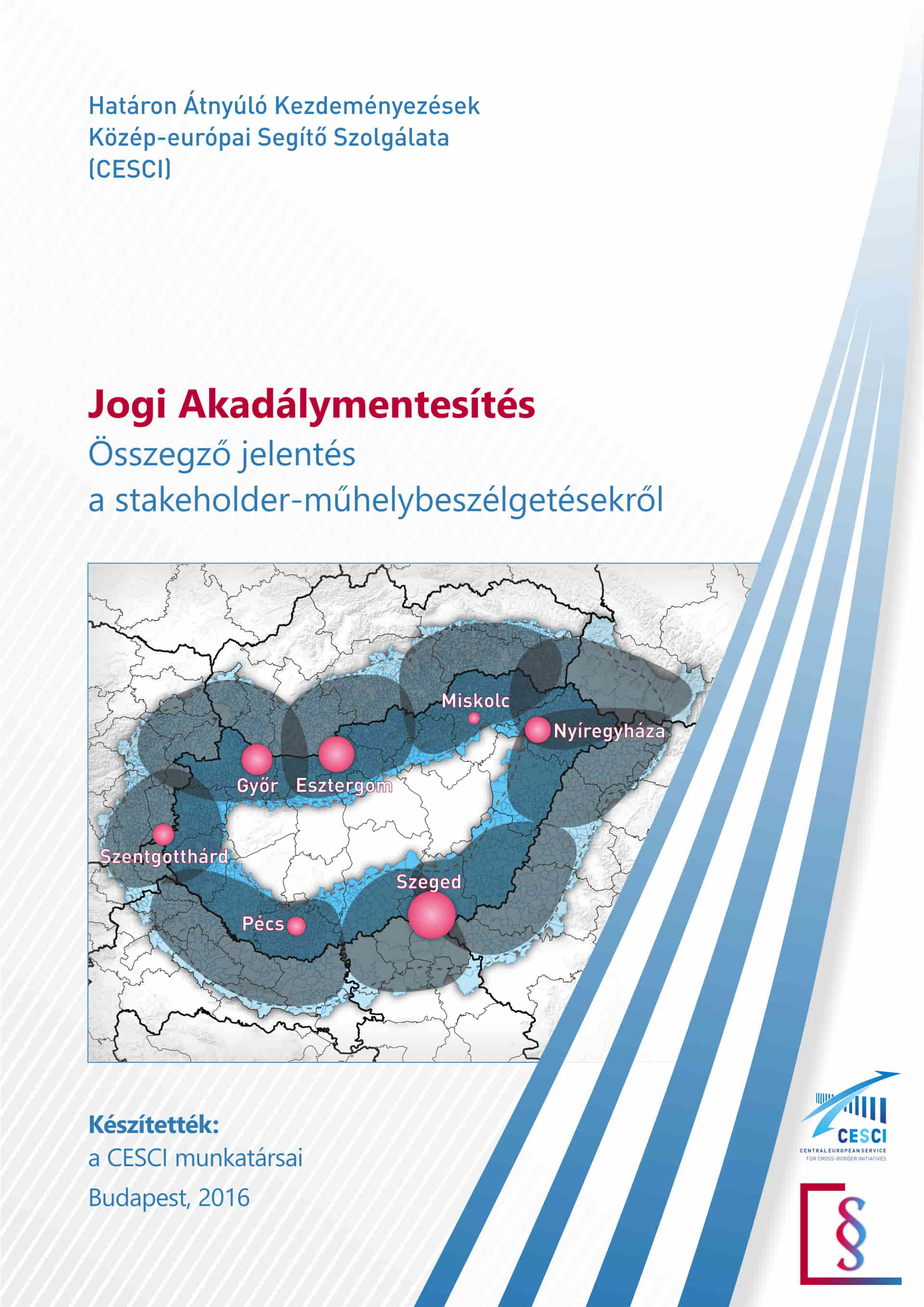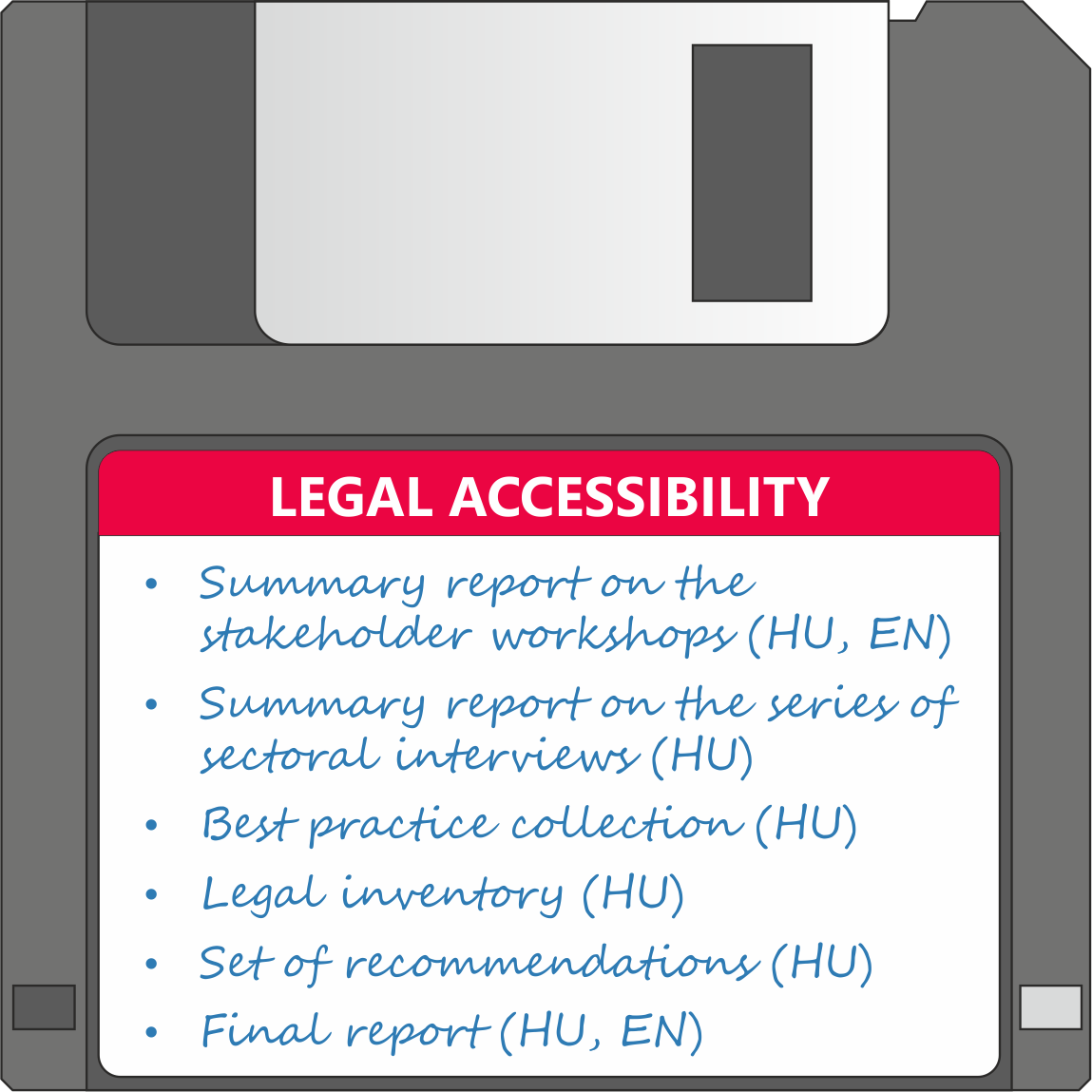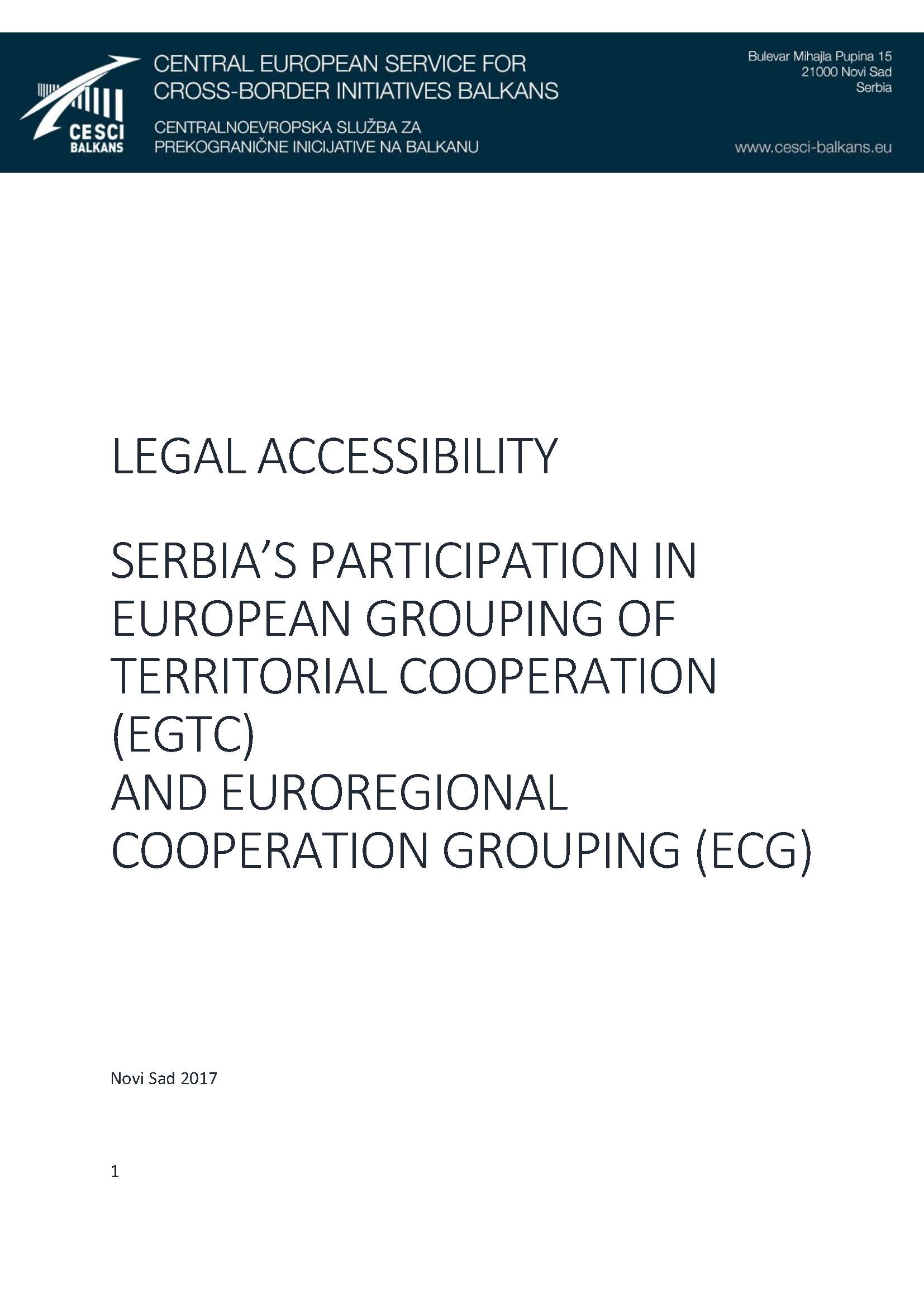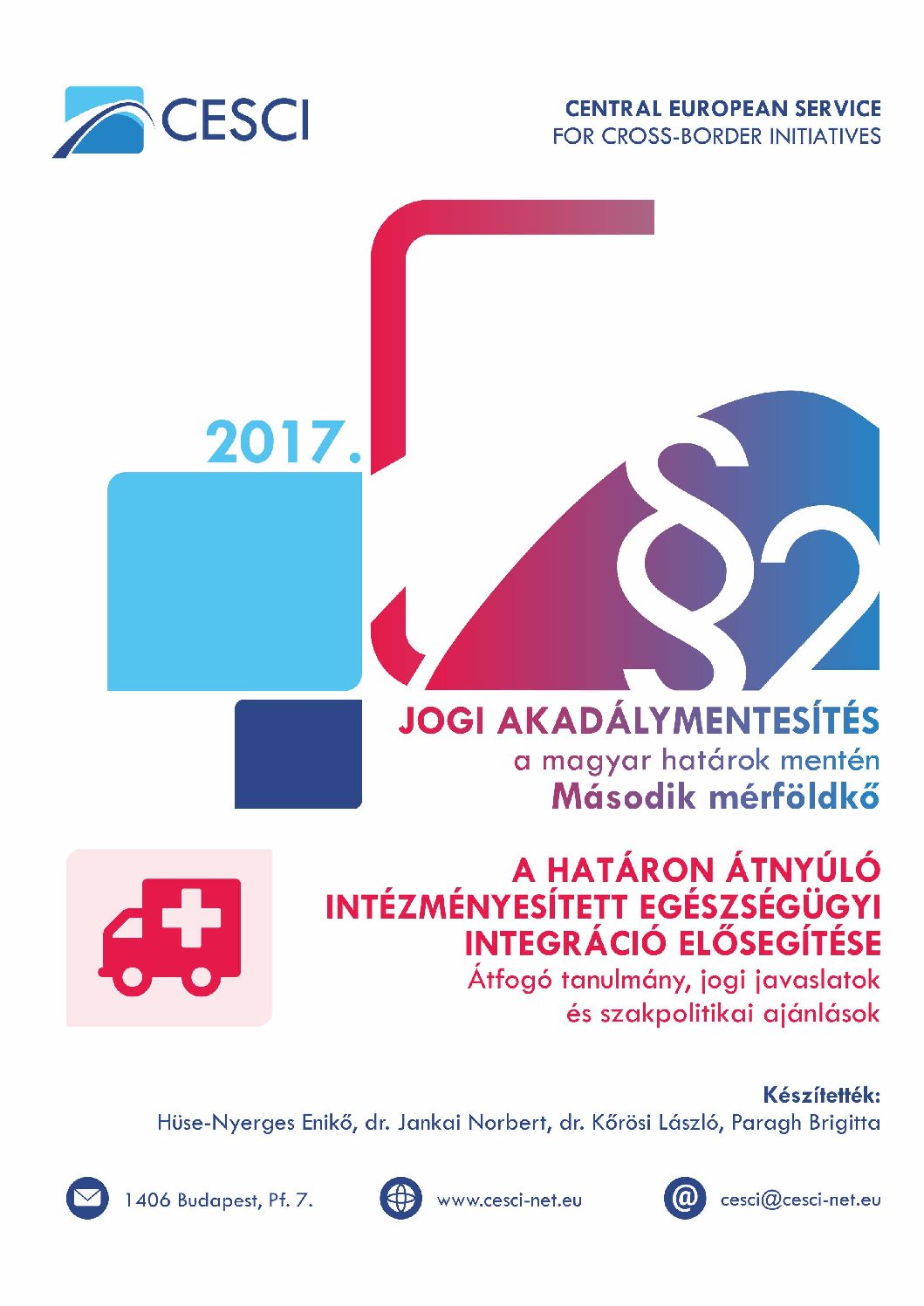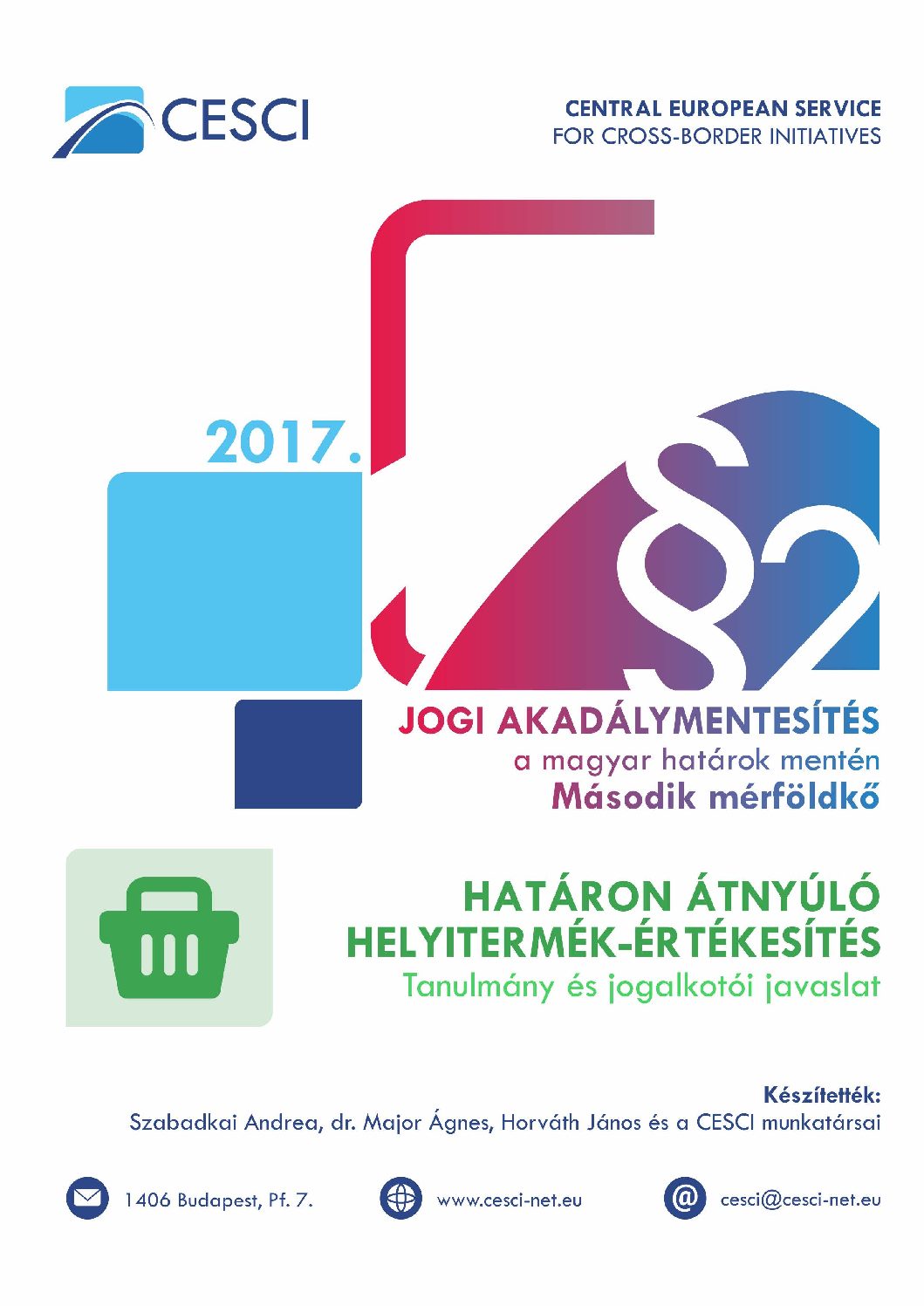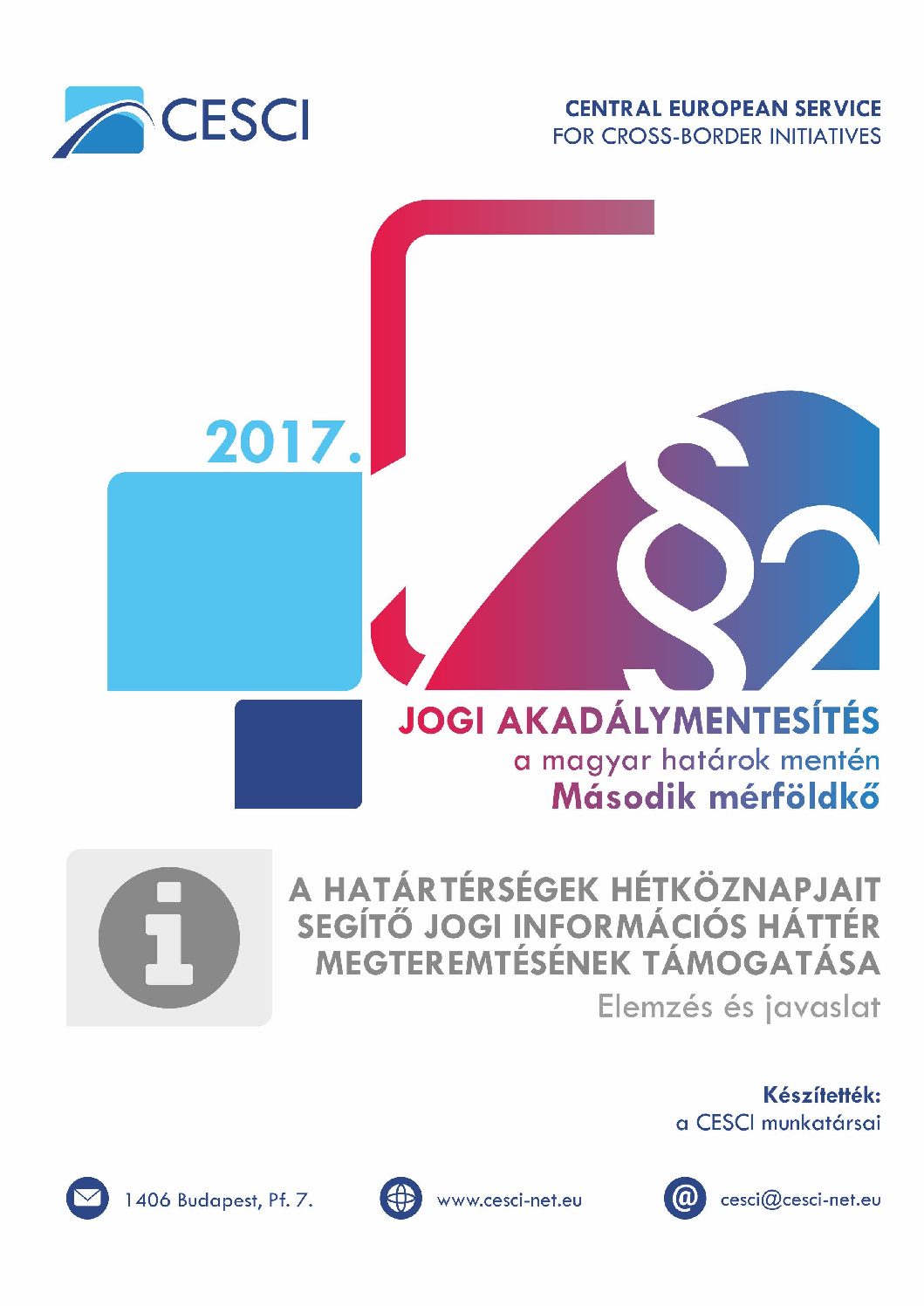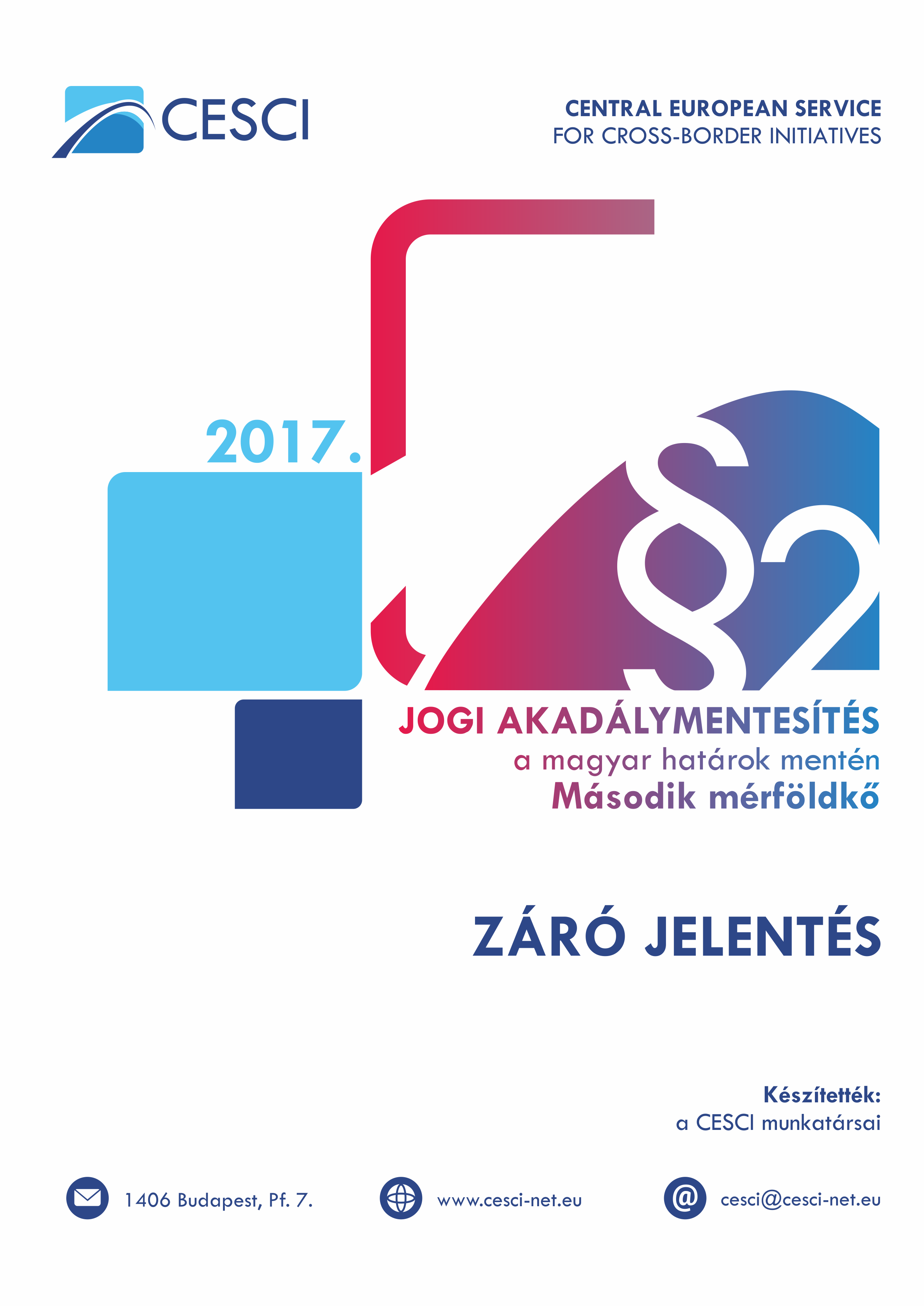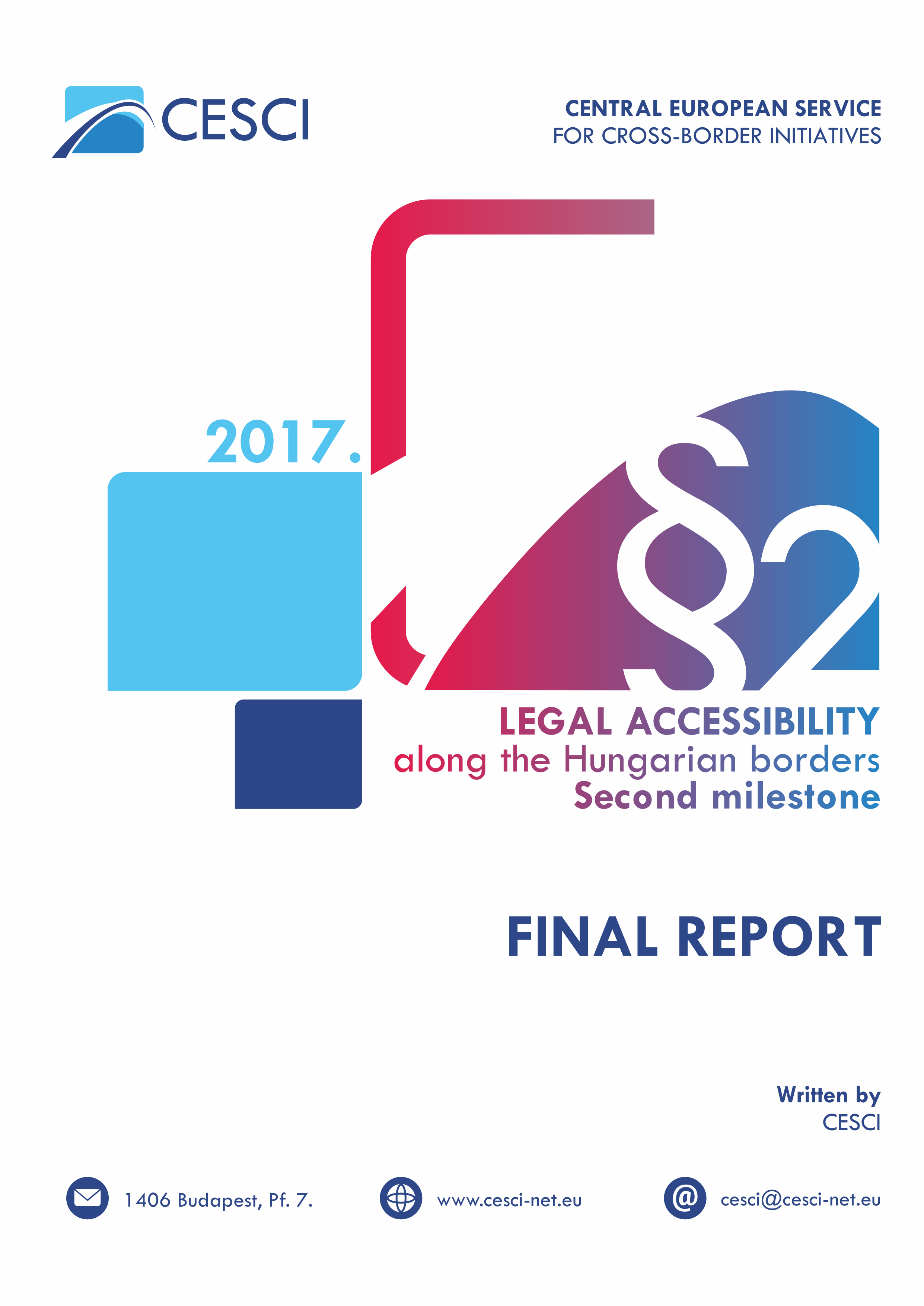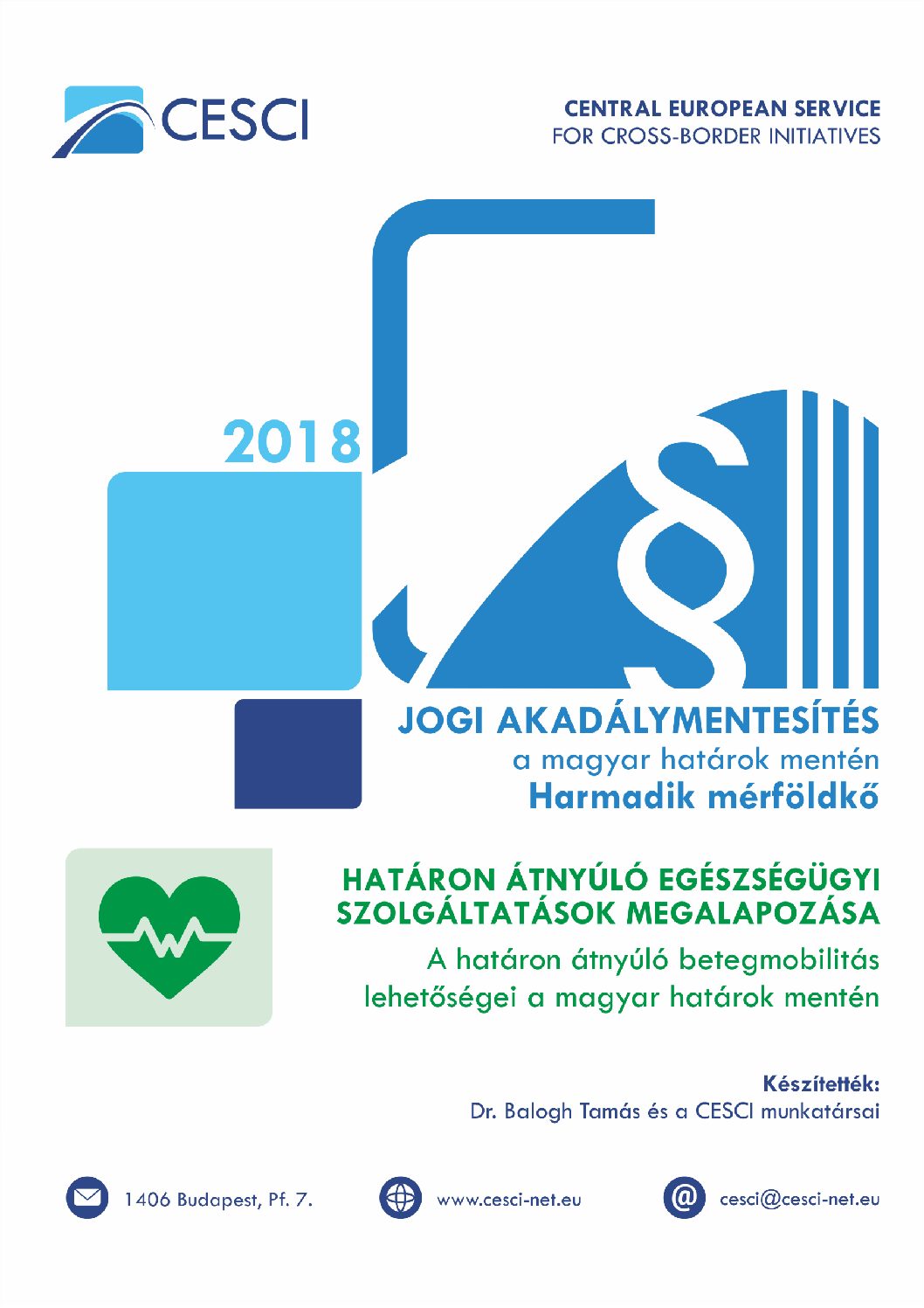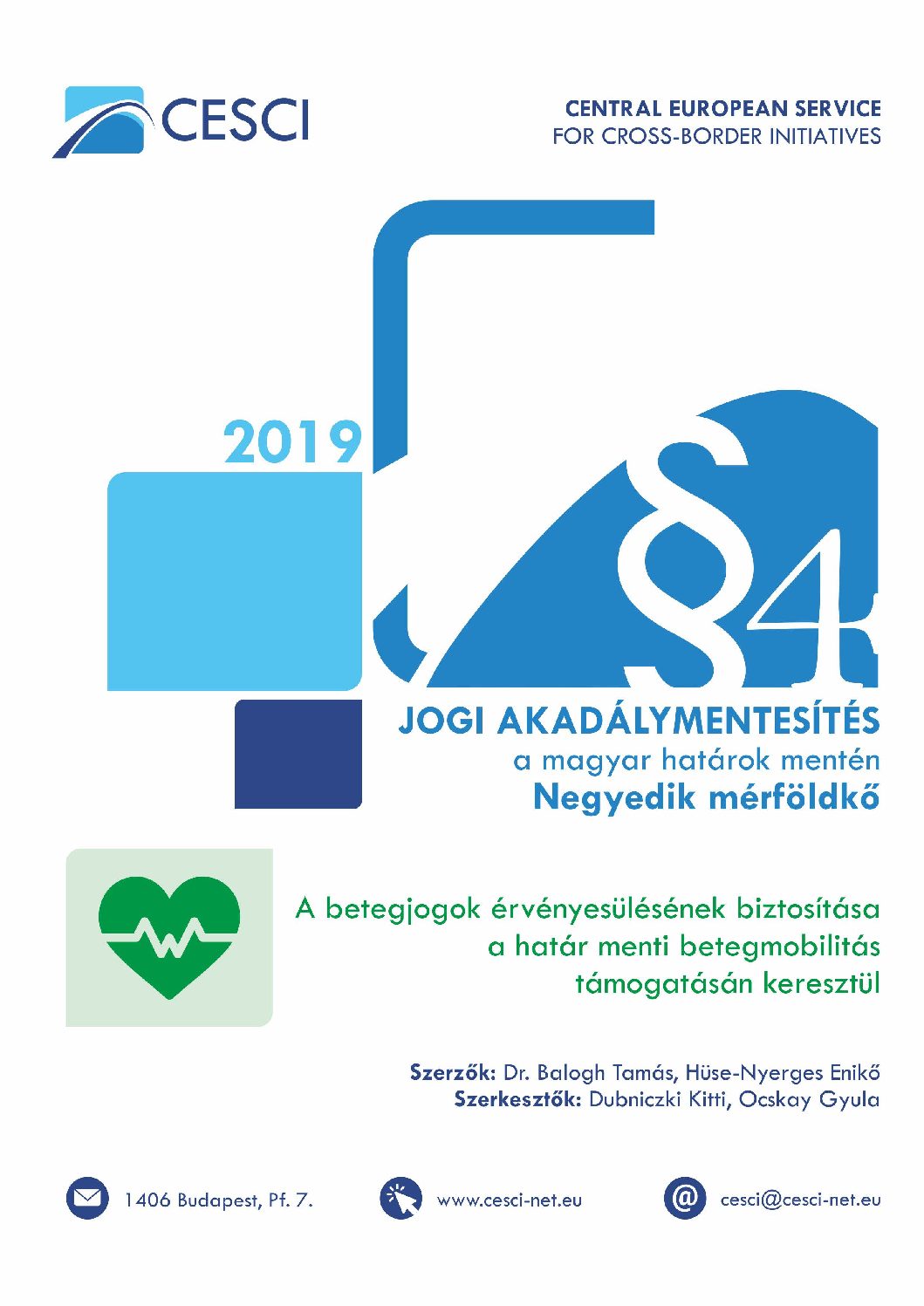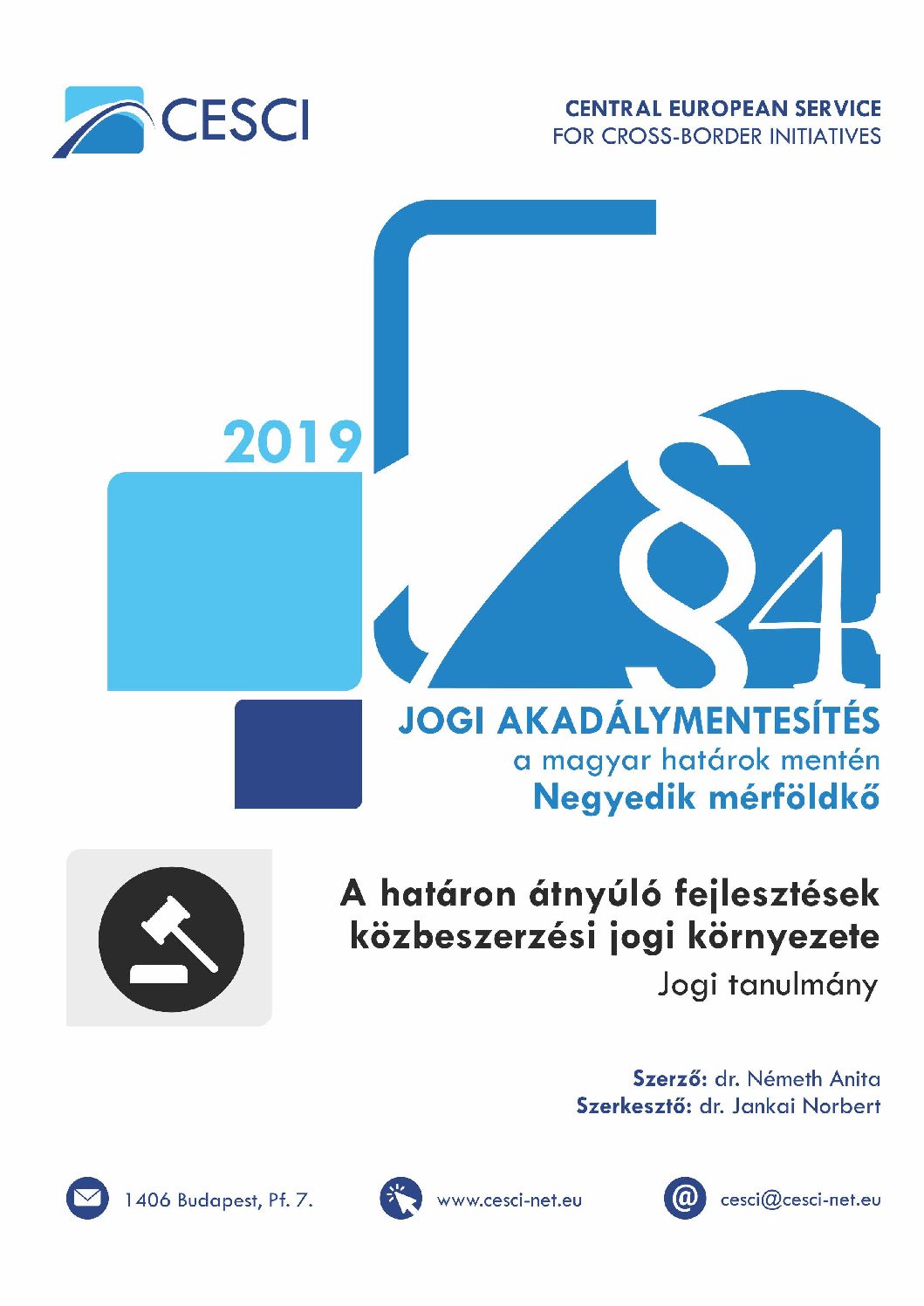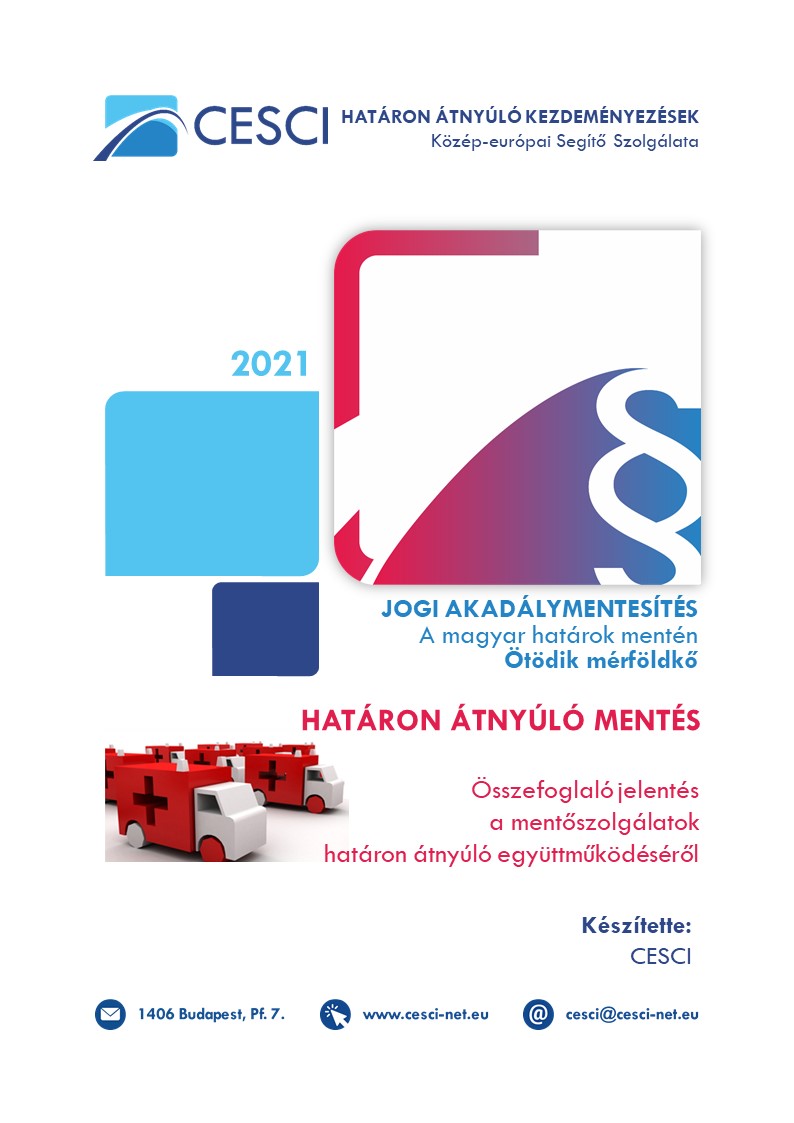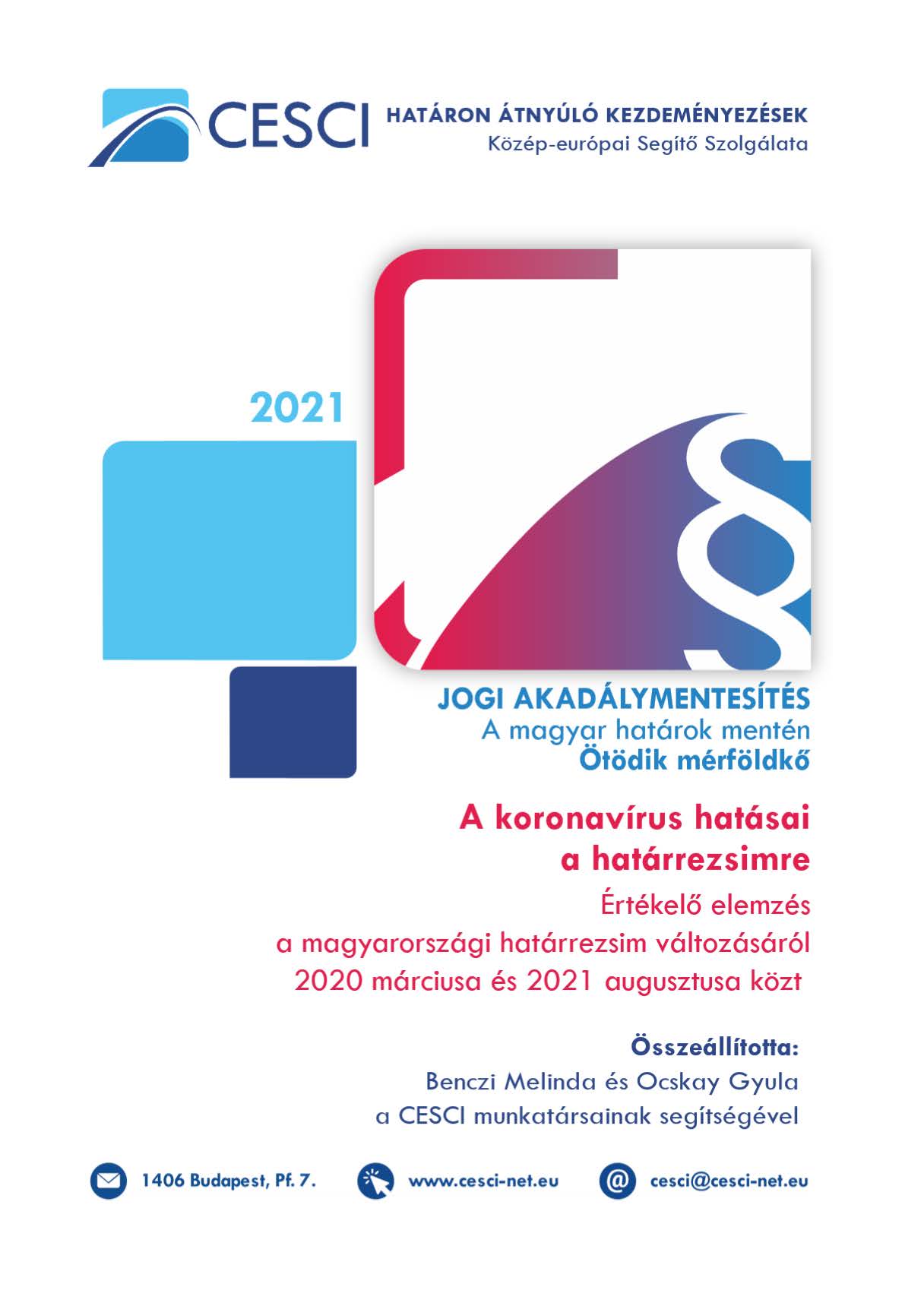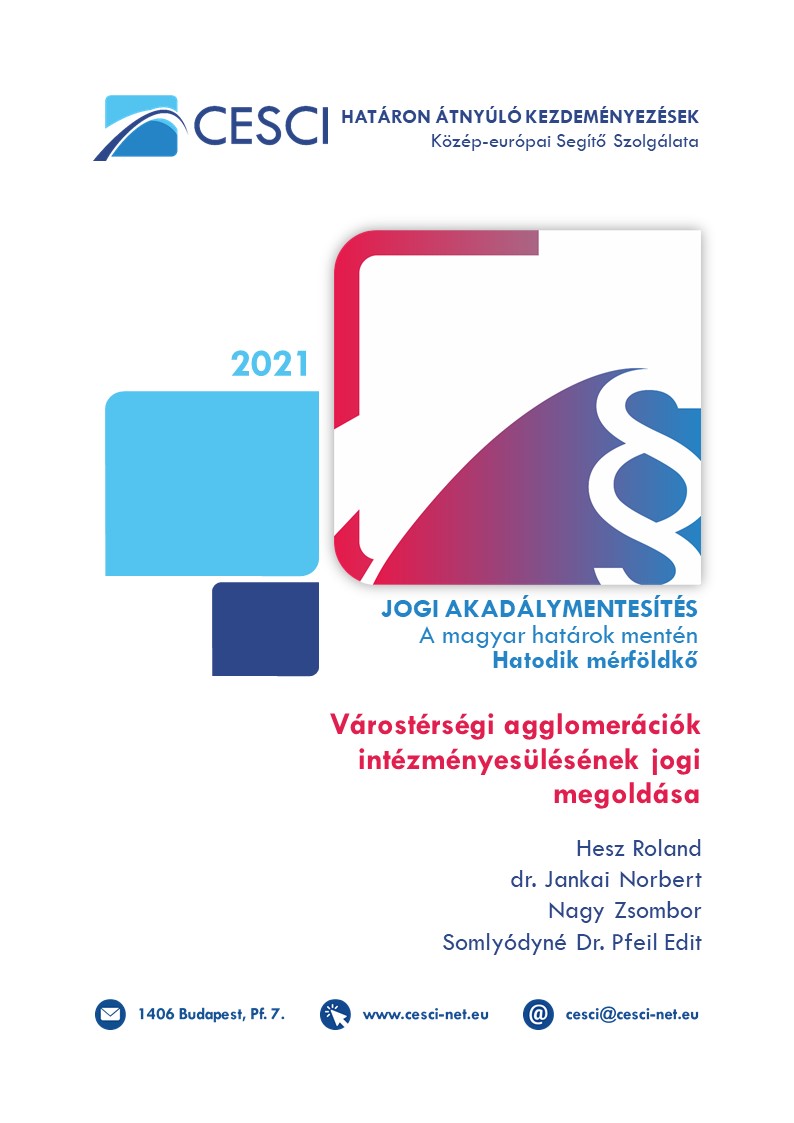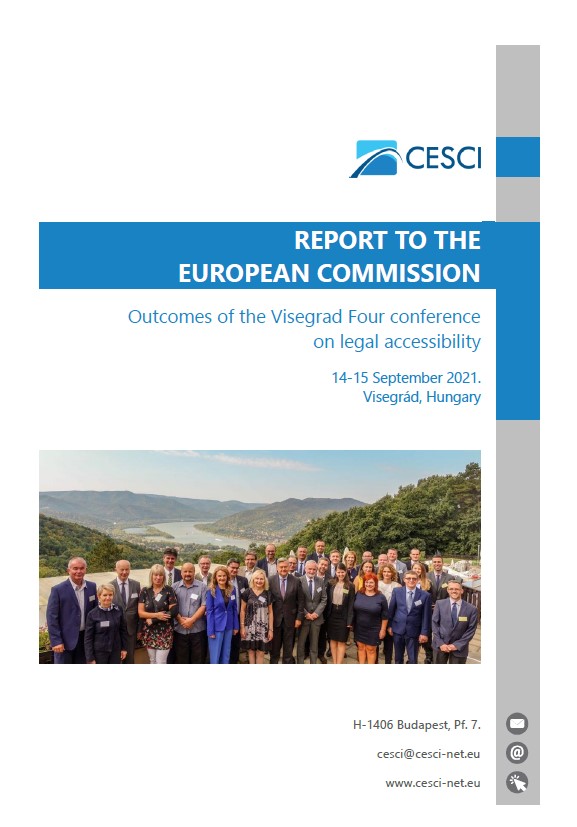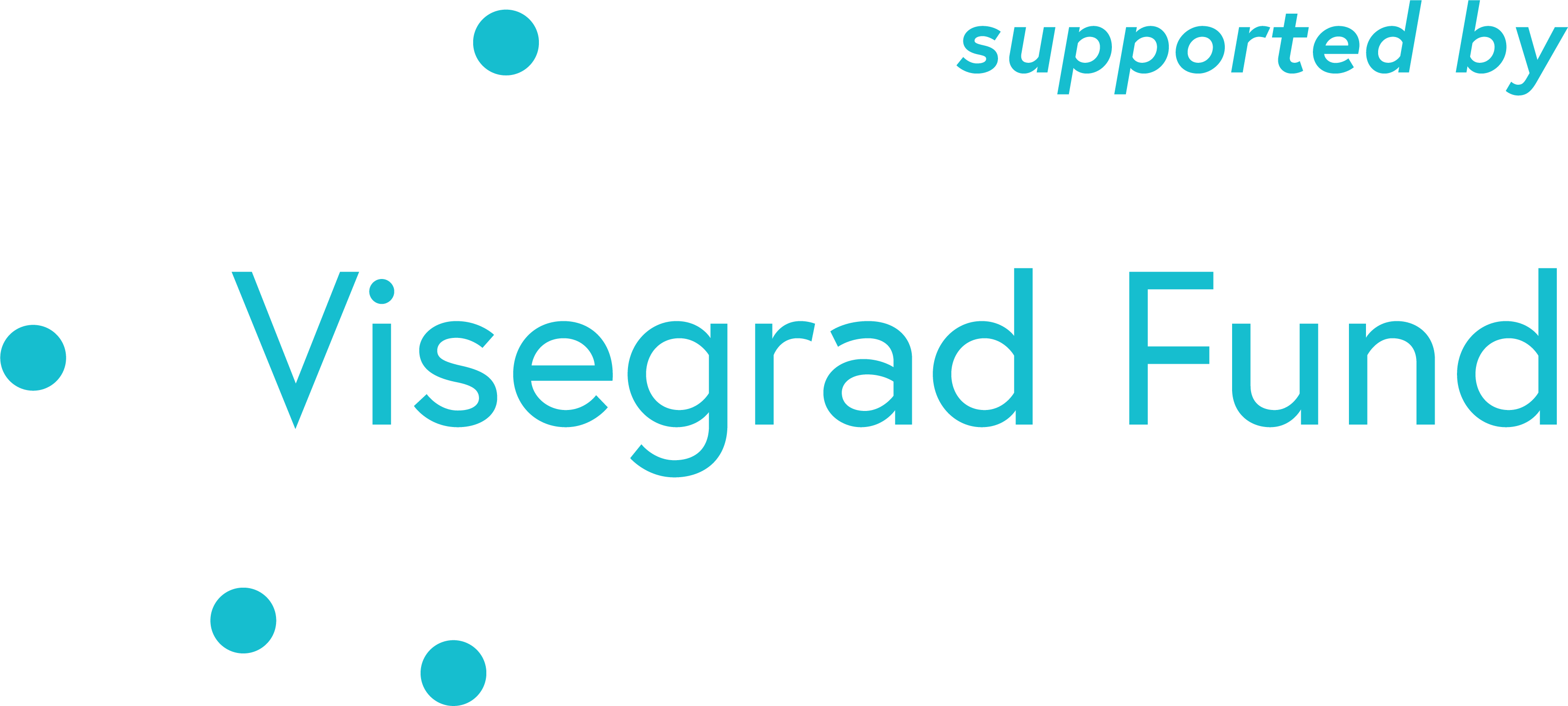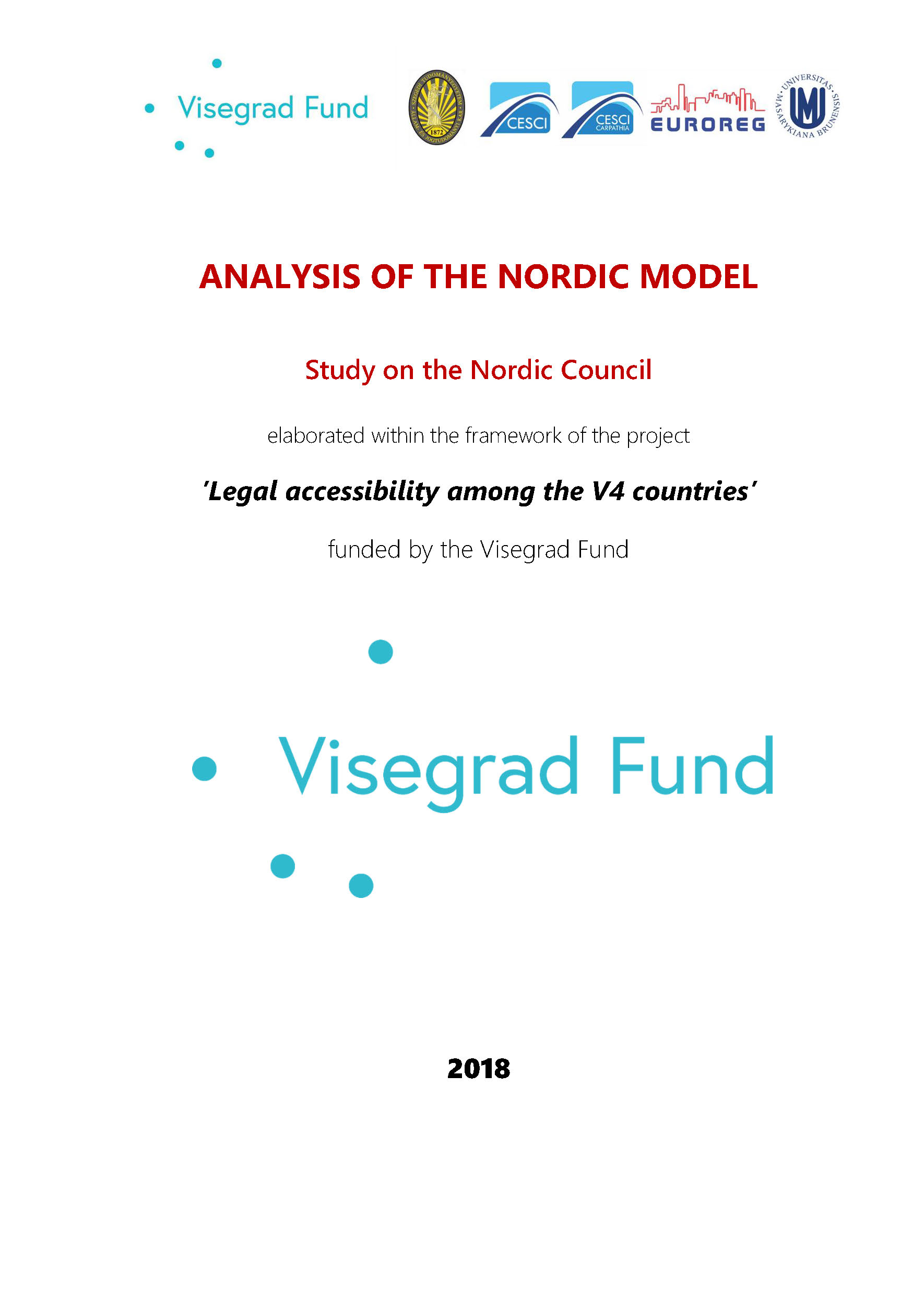Legal accessibility
Legal accessibility was launched in 2016 as a project of the Central European Service for Cross-Border Initiatives (CESCI). The project supported by the Hungarian Ministry of Justice aimed at identifying the pertaining legal and administrative obstacles along the Hungarian borders and drafting recommendations on the potential solutions thereof – based on the experiences of European best practices. The individual project has gradually became an overall initiative. This process was supported by the Cross-Border Reviewproject launched in parallel by the European Commission in 2015.
Within the framework of the first project, the experts of CESCI pointed out the ways of continuation and they carried out their work along these points. The major fields of the initiative are:
- identification of concrete obstacles making cross-border cooperation or daily life difficult in border regions, and elaboration of recommendations to overcome them;
- drafting of comprehensive policy and legal documents;
- support for the development of a permanent institutional structure of legal accessibility;
- working out of solutions for the problems of lack of information.
By the initiative, CESCI intends to contribute both the better permeability of Central European borders and the amelioration of living conditions of the people living in border areas.
Mechanisms of legal accessibility
One of the main conclusions of the Legal accessibility project implemented in 2016 was that instead of random identification of existing obstacles, it is more rational to create permanent mechanisms facilitating the work of the decision-makers and able to reflect on problems occurred.
CESCI has drafted a concrete proposal on a three-level legal accessibility mechanism the first level of which would be represented by an interministerial working group with the involvement of the Hungarian ministries affected.
Since in the overwhelming majority of the cases it is not enough to amend the relevant Hungarian law, the system of Joint Committees operated together with the neighbouring countries could be used for cross-border legal harmonisation.
Finally, third level would be represented by a platform (similar to that of the Nordic Council) to be set at the level of Visegrad countries, working for ensuring the conditions easing the free movement of the citizens of the four countries.
European outlook
The European Union is going through its most serious crisis which is in addition fundamentally connected to the issue of free cross-border movement. It is not the same whether this crisis will result in solutions hampering or facilitating free movement.
In parallel with the crisis, several policy debates at EU level are in progress which strongly belong to the topic of the Legal accessibility initiative. In February, 2015 CESCI submitted its first application for funding to the call of the DG Justice. The project aimed at carrying out a comprehensive research in the Central European region on the persisting legal and administrative obstacles and drafting recommendations on solutions – based on Western European best practices. The partnership included research institutes from the neighbouring countries, the ISIG from Gorizia, Italy and the Paris-based MOT. Due to the failure of the project proposal we addressed the Hungarian Ministry of Justice with a similar proposal taking into account that the topic of the removal of legal obstacles became (perhaps not out of the blue) one of the core topics of European discourse.
On the one hand, the project Cross-border Review launched by the Commissioner Ms Corina Creţu focussed the attention to the necessity of tackling legal and administrative problems. The project started in the summer of 2015. In the first round, the experts carried out an on-line survey by which their requested the opinion of local stakeholders on the obstacles. More than 600 answers arrived in total from across Europe (from Hungary, 12). The compilation of the study (including several case studies) started based on these answers, the inputs of 11 councillors’ seminars and the feedback of the participants of the expert group set also in that summer. Our association delegated an expert to the expert group and we drafted a contribution paper on the topic of territorial data processing.
In addition to the Cross-Border Review project coordinated by DG Regio it is worth mentioning the developments related to the new legal solution launched by the Luxemburg presidency in 2015. The proposal of the Luxemburg presidency targets the voluntary introduction of a legal tool (European Cross-Border Convention: ECBC) which would create an (extra-)territorial exception for the resolution of a problem in a given border region. In order to guaranteeing the cross-border availability of a service in a border area, the tool would make possible to apply the legislations of the neighbouring country – with a temporal and territorial limitation. Cerdanya Hospital is considered as such exceptional example but also in the case of a cross-border tramway line there are numerous technical, financial and administrative rules to be taken into consideration preventing the initiators from the opening of the tramway line. Regardless of the intention and the need, as well as the financial stability for the operation, the legal background of the two neighbouring countries must be amended in so many points (at national level) that the project will not be implemented. ECBC would allow the introduction of exceptional legal solutions providing answer to the concrete problem in a particular border region. Our association has been taking part in the work of the expert group facilitating the elaboration of the proposal on the ECBC from the beginning.
During the recent years, the French Mission Opérationnelle Transfrontalière (MOT) has drawn the attention at several professional events on the shortages of territorial statistics making cross-border cooperation and developments difficult. Eurostat gathers data at NUTS III (sometimes at NUTS II) level only which are irrelevant in terms of direct cross-border interventions involving mainly local and sub-regional actors. Our association has joined this consultation process with the organisation of a seminar in September, 2014. In 2016, European Commission initiated the cooperation of national statistical offices in order to tackle the problem. Within the framework of the PILOT project, institutions of 11 member countries took part and worked together on a methodology on how to measure cross-border labour mobility.
The European Union is not the only actor dealing with the problem of obstacles. In 2014, Council of Europe contracted the Institute of International Sociology of Gorizia (ISIG) to unfold the most frequent cross-border legal and administrative obstacles in Europe, to compile best practices giving solutions thereto and to make the information available by a portal. The portal was launched in 2015 with a permanently growing data base – thanks to its users.
In 2014, the governments of the Nordic Council established the Freedom of Movemenet Council which (with the support of experts and the Secretariat operating in Copenhagen) identifies every year 5 obstacles hindering free movement among the countries the elimination of which is targeted by the governments with a deadline of 3 years. The Secretariat is permanently surveying and evaluating the steps already taken and the results of the harmonisation process.
In France, the MOT started to tackle the existing obstacles in 2011 when supporting the work of a parliamentary ad-hoc committee. Later on, the experts of the association has developed a permanently growing base of information and in 2017 they initiated the establishment of an interministerial working group and a nation-wide stakeholder platform facilitating the share of information on obstacles and solutions. (Besides, MOT played a desicive role in the elaboration of the proposal of the Luxemburg presidency.)
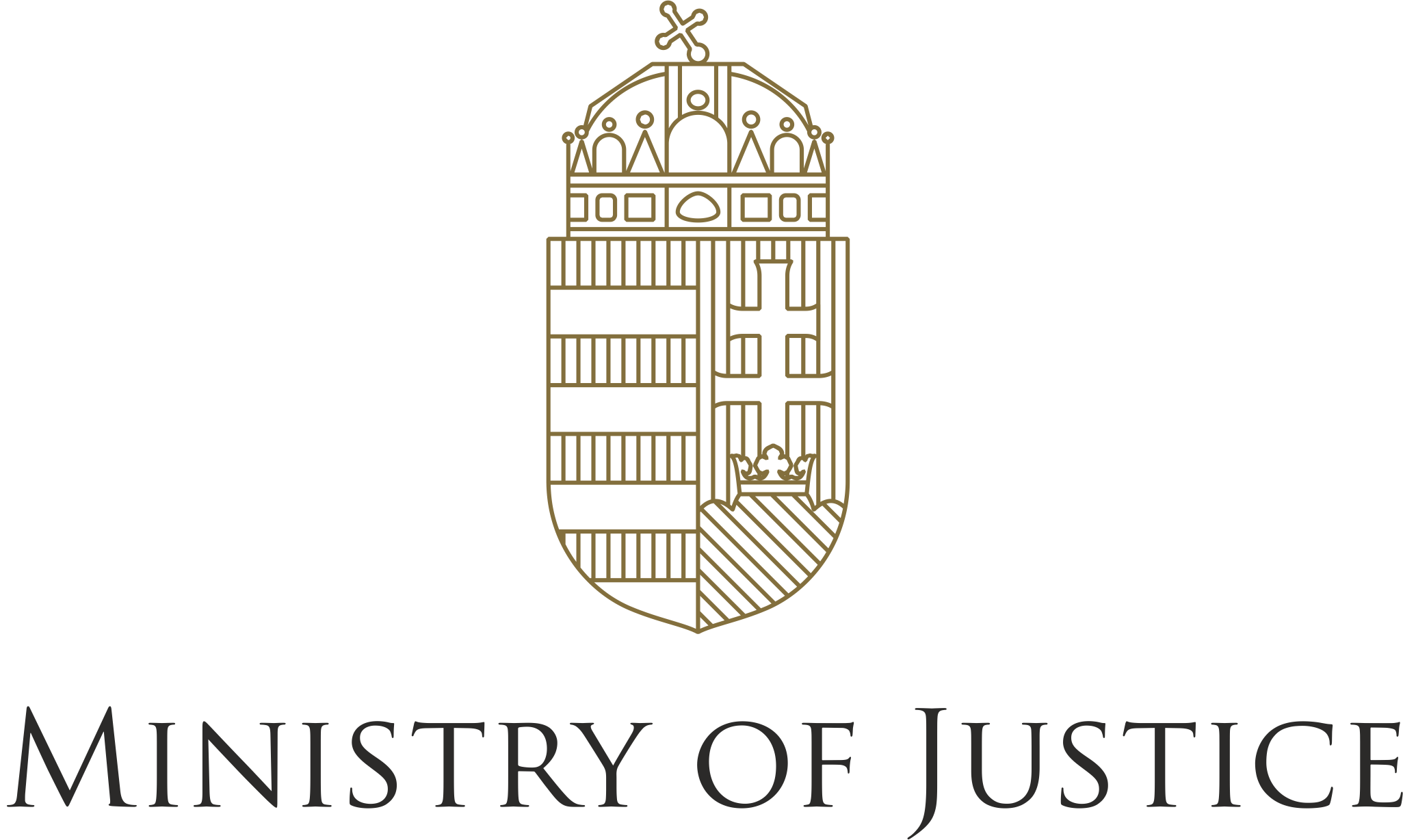
The project was funded by the Ministry of Justice.
The project documents and the conclusions and recommendations contained therein do not necessarily reflect the official position of the Promoter.
The consultation process of the Cross-Border Review project launched by the Commissioner of Regional Policy of the European Commission, Ms Corina Creţu lasted from September 2015 until the end of 2016. The main goal of the consultation process was to get as comprehensive picture as possible on the legal and administrative obstacles still existing along the internal borders of the EU Member States.
Central European Service for Cross-Border Initiatives submitted an application to the call of DG Justice half a year before the starting date of the EU level project with a view to identifying the obstacles existing in Central Europe. After the proposal had been refused by the DG, CESCI addressed the Hungarian Ministry of Justice with the project idea. The experts of CESCI implemented the project called Legal accessibility between February and September of 2016 with the support of the Ministry of Justice, in parallel and using the synergies common with the EU level project but applying different methodology. The objective of the project was to identify the legal and administrative obstacles making cross-border cooperation and daily life in border areas difficult. At the same time, the CESCI’s project went further than the EU project when drafting concrete, sometimes textual recommendations in order to eliminate these obstacles.
The first Legal accessibility project ended with succes in the second half of 2016: the experts of CESCI unfolded the background of 39 legal or administrative obstacles in total and drafted the recommendations for solutions – based on European best practices. The documentation running to some 600 pages treated four thematic areas (cross-border mobility, health-care, labour mobility and short supply chains – local products) with special emphasis and it tackled also two horizontal issues facilitating the systematic (non ad-hoc) treatment of the problems: the first targeted the potential institutional background of legal accessibility; the second envisaged the elimination of the shortages in access to information.
Due partly to the Cross-Border Review, the Hungarian project received a positive feedback at European level and at professional circles. This good resonance means that the topic is relevant and it is worth dealing with it in the future. At the same time, it is important also from the point of view of the future of the population and the local municipalities of the border areas to find solution to the unfolded problems.
Project activites
The following activities were implemented in the framework of the project:
- Stakeholder workshops
- Sectoral interviews
- Research
- European outlook
- Legislation review
- Set of recommendations
- Final report
The workflow and logic of the project are presented by the following figure.

The first activity of the project “Legal Accessibility” was the series of so called stakeholder workshops organized in the Hungarian border areas (altogether 9+1 workshops). All the local participants involved in cross-border cooperation were invited to these stakeholder workshops. Roundtable discussion was used at the workshops to collect information about those obstacles that were experienced by the invited local participants. The primary purpose of the roundtable discussion was to identify problems on a territorial basis. Subsequently, an inventory of the problems articulated by the local actors was compiled. In the next phase of the project, sectoral interviews were performed with experts. During these sectoral interviews, we revealed the legal and administrative dimensions of the articulated problems.
At the same time, a research in the field of European best practices on cross-border cooperation and identified obstacles was started. The legal inventory of the identified obstacles was further developed and specified through valuable information received during the sectoral interviews and through profound desk research. We have articulated legal and policy recommendations with the intention to dissolve the identified obstacles by using the sectoral interviews, the European outlook and results of the legislative research.
Summary report on the stakeholder workshops (1st milestone – 2016)
In order to download our summary report on the stakeholder workshops in English, please click on the image below:
Within the framework of the legal accessibility project, several stakeholder workshops were organised between 27 January and 18 February 2016, to which stakeholders active in cross-border projects of the relevant border region were invited.
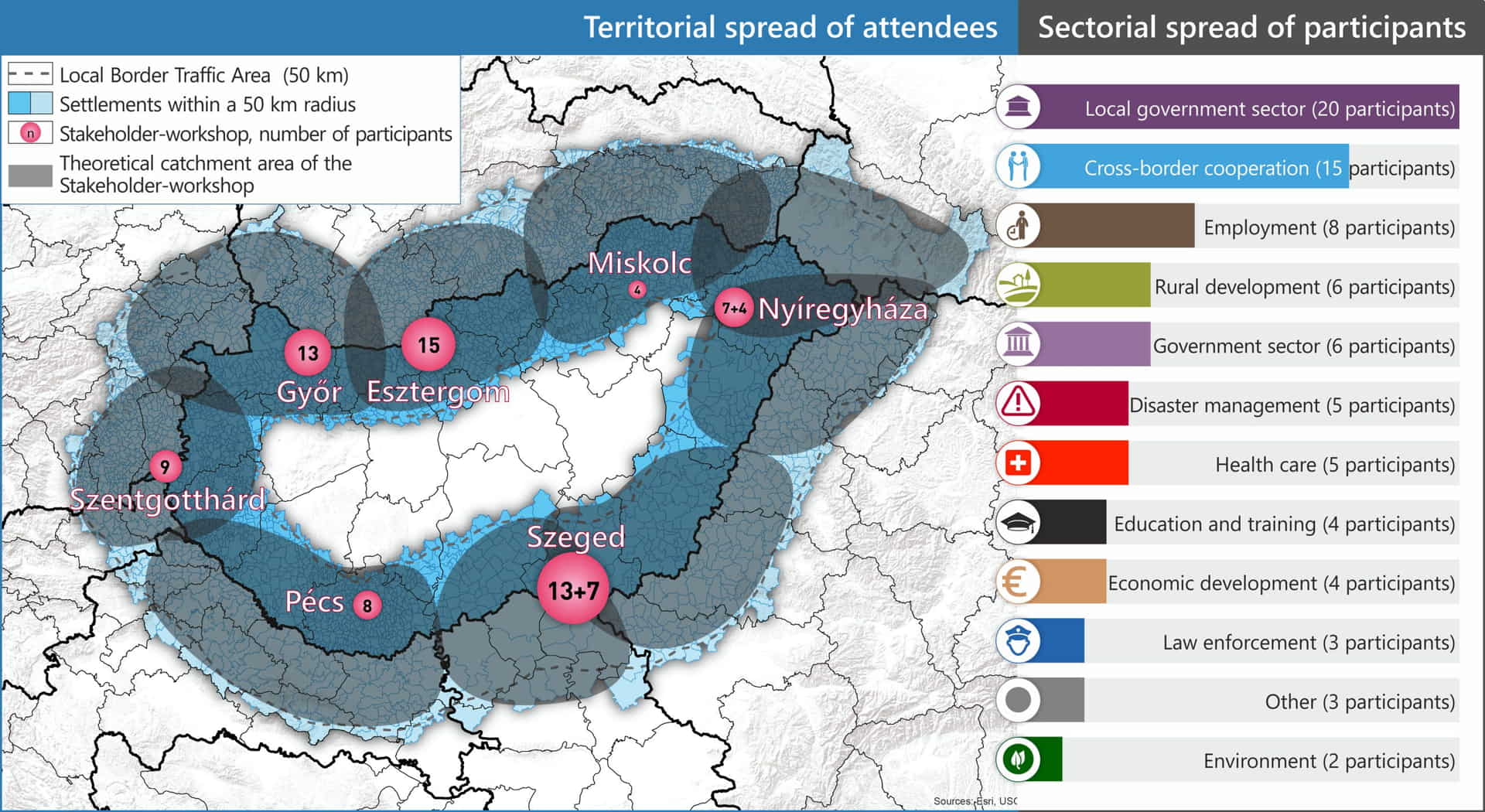
During the course of the workshop, in the form of a round table discussion, we gather information on obstacles experienced by local participants. Following the workshops, a summary report was composed.
The report briefly presents Hungary’s border sections, primarily focusing on their status in the EU integration process, as this fundamentally determines the scale and nature of cross-border interactions.
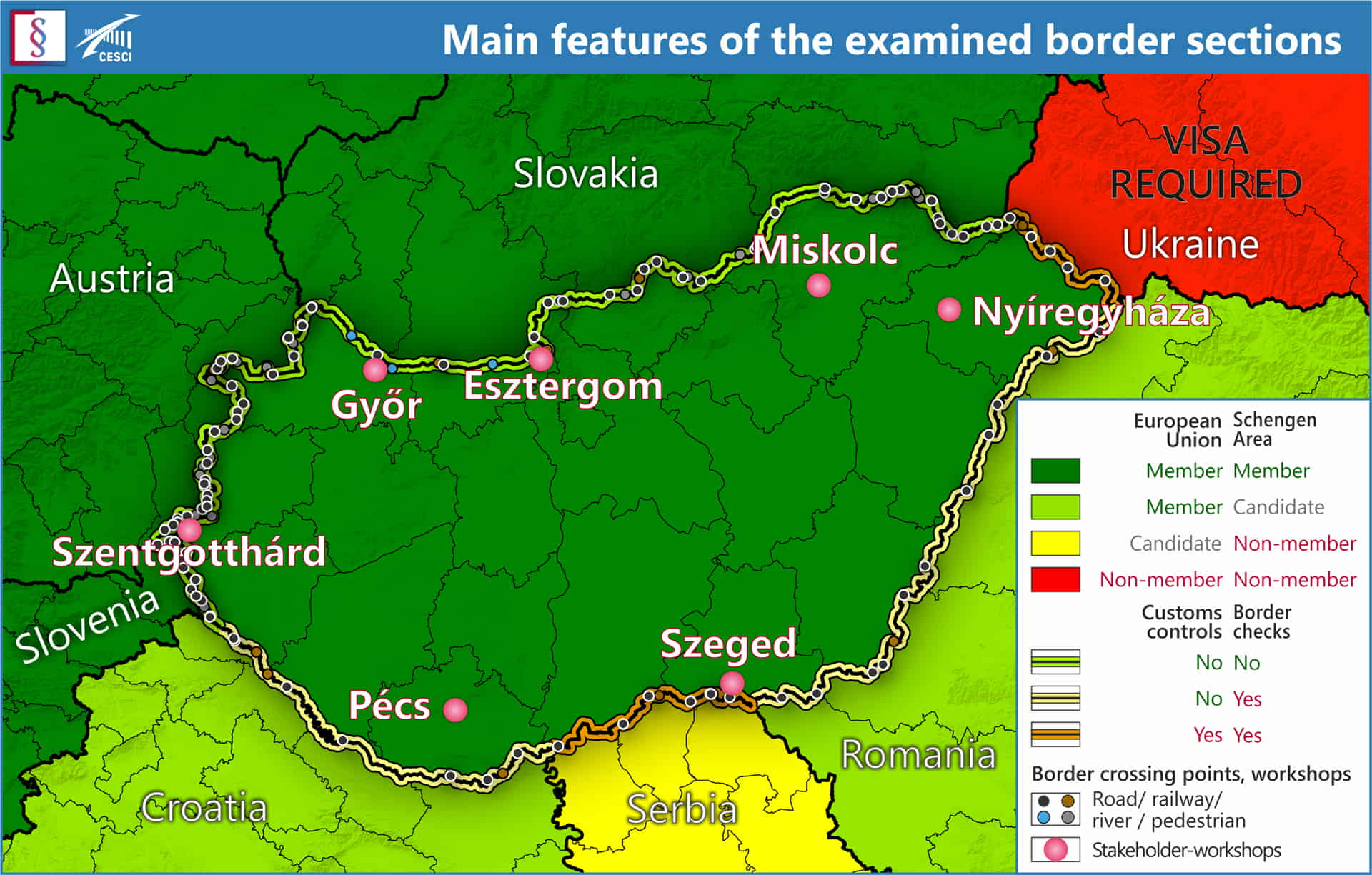
Following the border sections description, all information that came up during the course of the workshops (legal obstacles, best practices, other obstacles of non-legal nature, further comments) were presented by geographical breakdown.
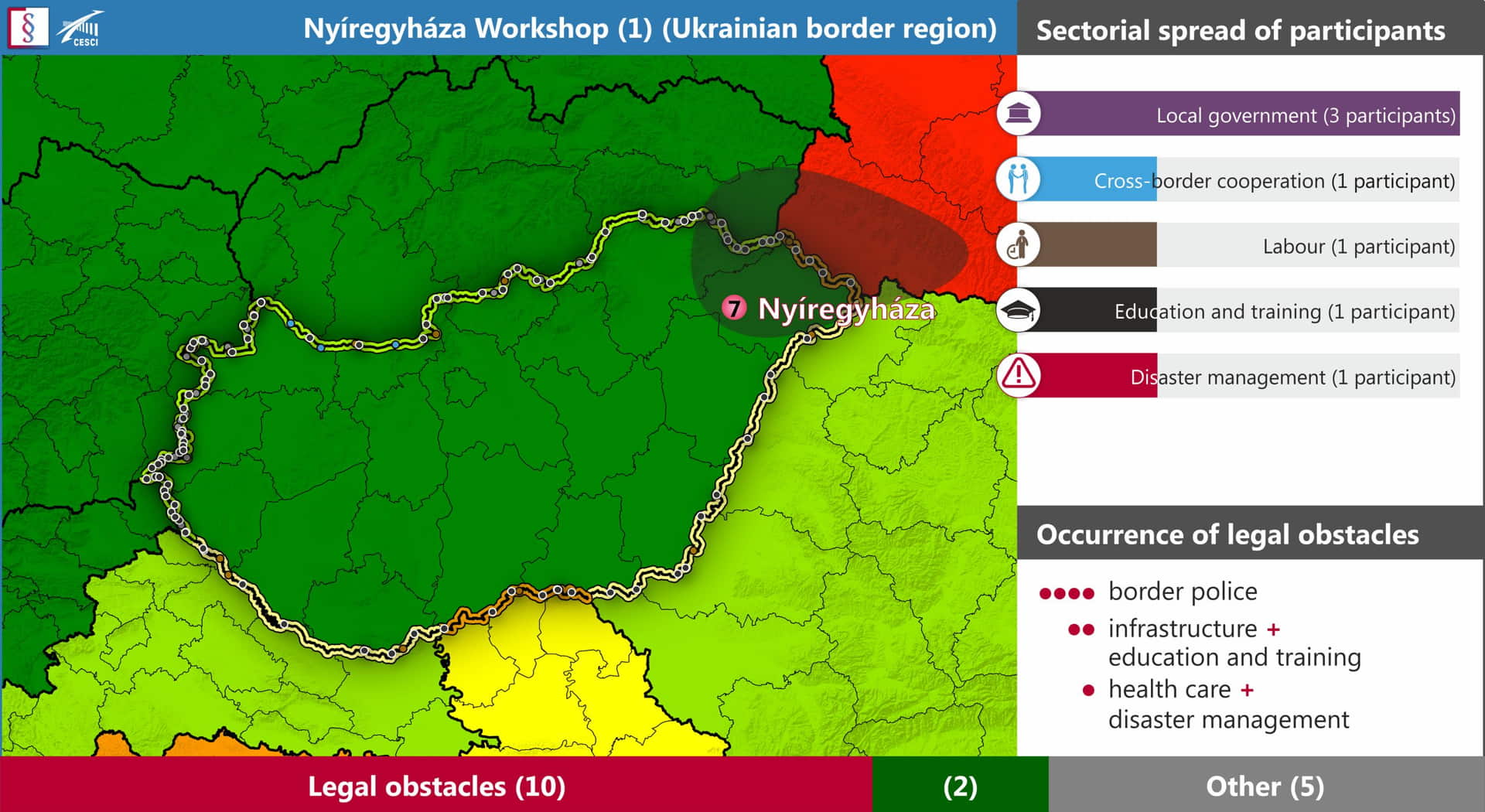 |
 |
| Nyíregyháza (1) | Nyíregyháza (2) |
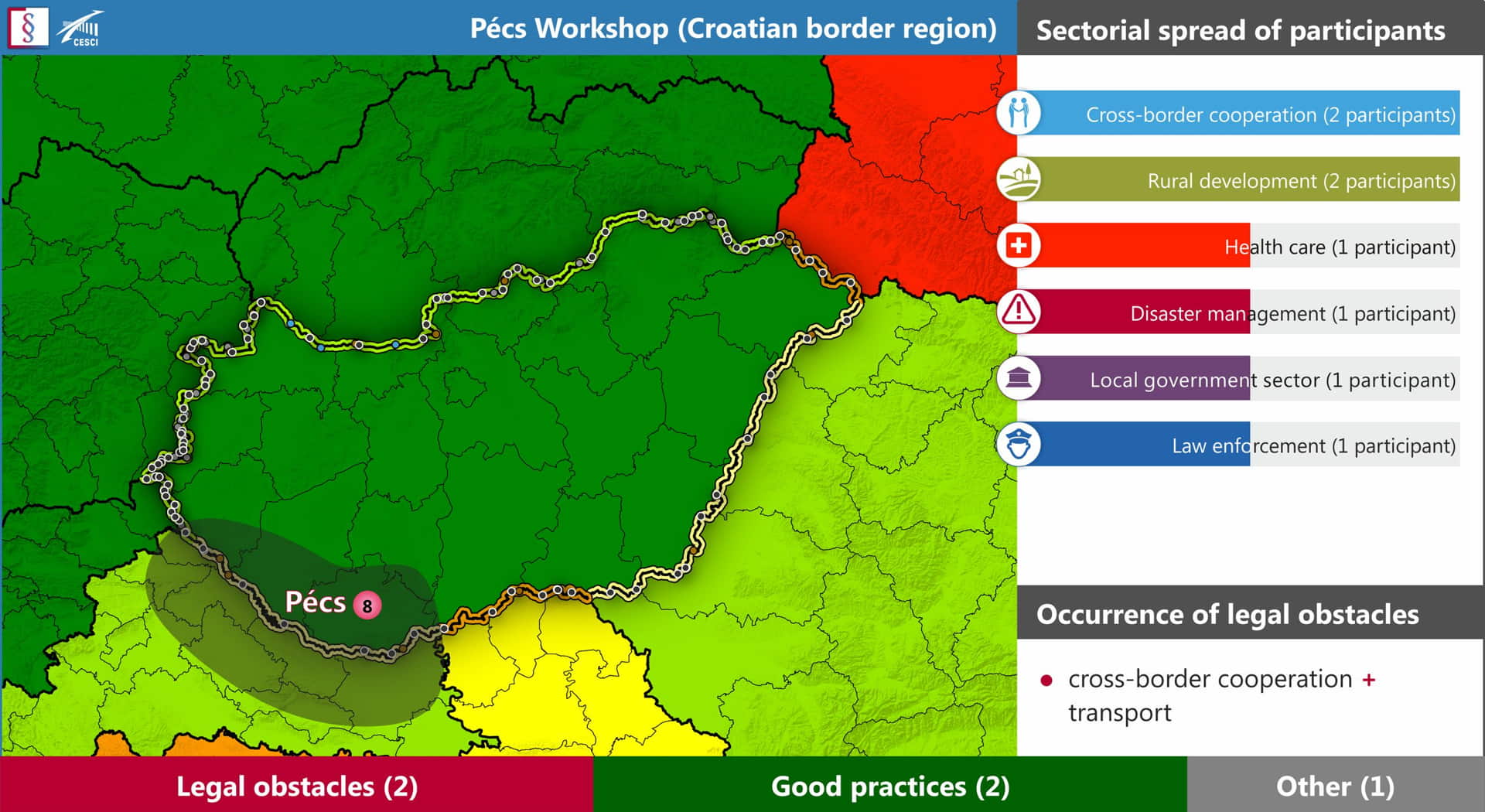 |
 |
| Pécs | Miskolc |
After having presented the workshops themselves, a sectorial inventory was set up about everything that has been said during the events. The figure below shows how many independent legal obstacles could be identified after grouping the issues based on all bits of raw information.
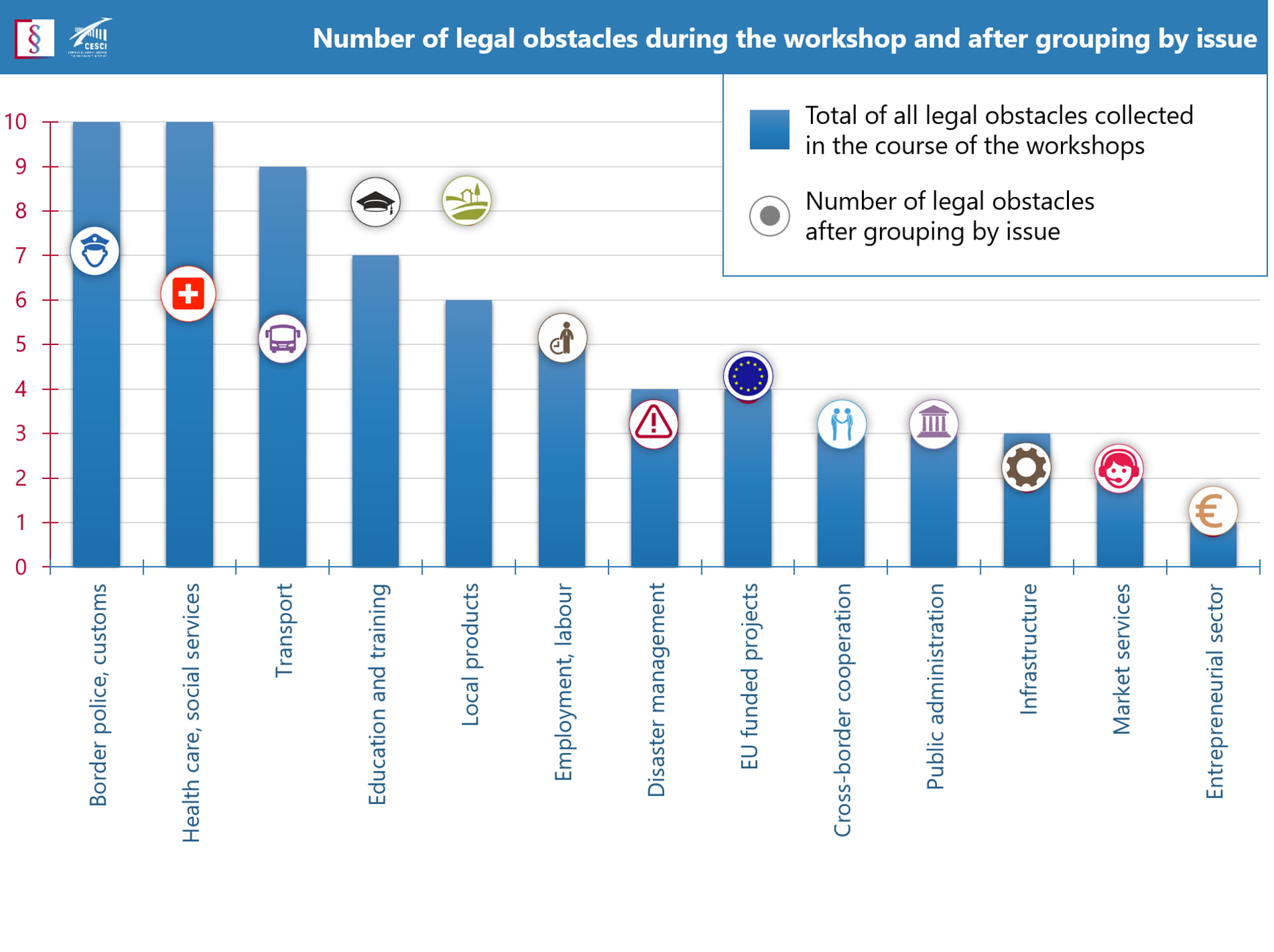
Most of the legal obstacles in the inventory call for a change in the national legislative environment. However, in some cases it is the legislations of the neighbouring country that causes hindrance, and in some cases, EU level legislation would be needed. Determining the latter will be down to the following part of the project (Investigating regulations).
It is possible that the explored legal obstacles already do partially dispose of the appropriate legal environment, but stakeholders do not know of these due to lack of information-flow. This is why we have collected all mentioned legal obstacles in our inventory, to be able to clear their background for the benefit of all participants in the following sections of the project (Sectoral interviews, Investigating regulations).
At the end of the report, we have published further useful information mentioned during the workshops. Firstly the non-legal obstacles and issues, then all further comments that help us understand the situation of some topics deemed problematic, or even best practices.
Summary report on the series of sectoral interviews (1st milestone – 2016)
The summary report on the interviews with sectoral experts in Hungarian can be downloaded by clicking on the image below:
Interviews with sectoral experts were conducted between April and June in 2016 within the frameworks of the project, ‘Legal Accessibility’. The principal aim of these interviews was to thoroughly explore the obstacles experienced by local participants. The obstacles were initially gathered at the stakeholder workshops and roundtable discussions.
Approximately 100 interview requests were made, of which 24 in-depth personal interviews were actually held and 14 written answers were processed. Background research was frequently helped by telephone interviews. A total of 30 telephone interviews were conducted with different sectoral representatives.
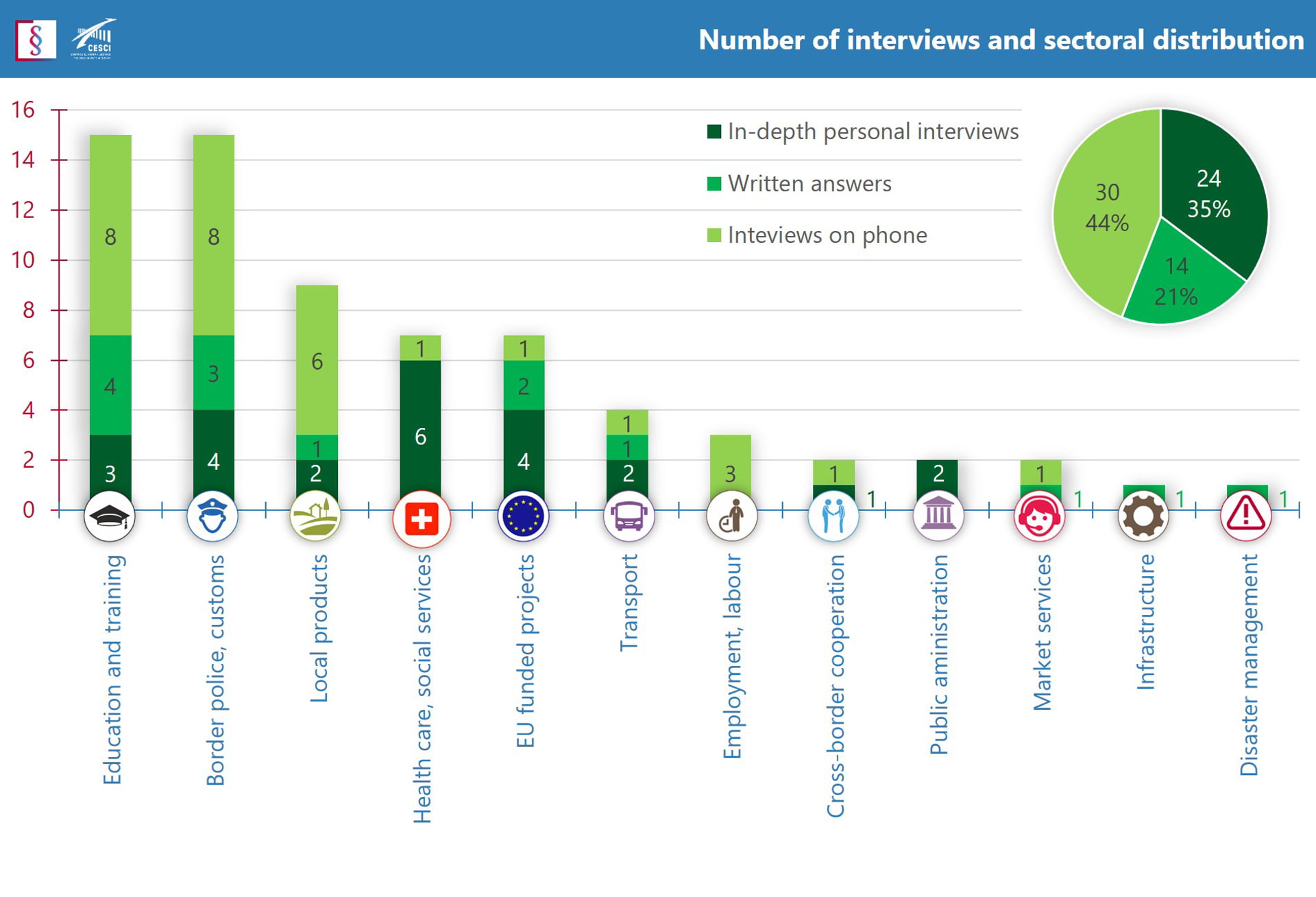
During the series of interviews, we asked for the help of experts who actively participate in shaping, or enforcing the rules, operating the system, or resolving the emerged problems. We aimed to understand the existing and determining legal and regulatory environment.
Legislative competence and acquired professional experience were considered as the most important characteristics for the selection of interviewees. Special considerations had to be included in those cases, where we had to uncover the legal background of relevant regulatory issues which were valid only on specified border sections (e.g. the Serbian – Hungarian border).
Concerning the interviews’ content structure, we considered the understanding of the complexity and completeness of the regulatory systems as important as the cases and problems we explored during earlier stakeholder workshops. Thus, the specific answers to problems that arose during our interviews also provide important general information about the given area.
We attempted to personally visit the interviewees; at the same time, however, some potential interviewees could not undertake a personal meeting due to administrative reasons, therefore we asked for written answers that they successfully provided to us. In addition, the examination of legislative regulations – which was performed in parallel with the interviews – made it necessary to perform further searches by telephone or by written form.
Within the frames of the summary report, interviews and sectoral reactions – received either in written or oral form – are elucidated on the basis of sectors and within them on the basis of obstacles. Some obstacles – which were originally identified as separate legal obstructions –have common roots, thus the given answers and solutions are also similar; subsequently, we merged them and we treat them together.
The concrete purpose of the interviews– and of the whole project – is to recommend legislative amendments; nevertheless, the prepared interview report itself represents a valuable achievement that contributes to a deeper understanding of the complex nature of political borders.
European outlook / Collection of best practices (1st milestone – 2016)
You can download the Collection of best practices prepared in the framework of the project by clicking on the following picture:
In the framework of the Legal Accessibility project, we examined the problems and obstacles that arise during the interactions of border regions; furthermore, we explored the handling, management and solution of these obstacles in other parts of Europe. We mainly concentrated on those European regions that have accumulated enough experience in the field of cross-border cooperation.
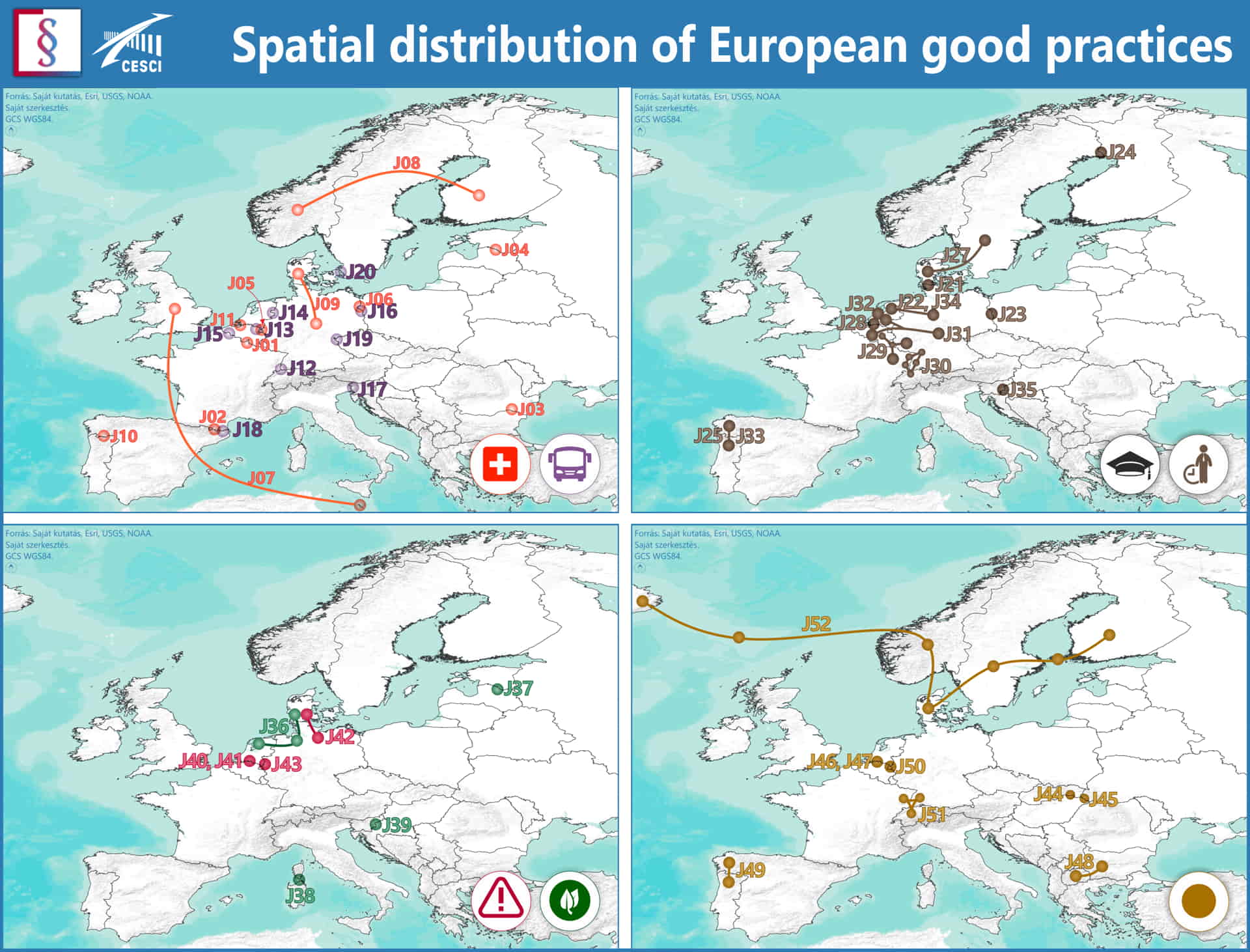
We used qualitative methodology during the preparation of the research study and during the actual research activity, too. That means our research was built on the so called ‘desk research’ methodology, thus we made a systematic gathering of good examples, their research, categorization, identification and evaluation of obstacles, and we explored the possible and implemented solutions as well.
Cross-border database and toolkit of the EDEN portal, developed by ISIG, commissioned by the Council of Europe, was a valuable help in the process of identifying relevant information on institutionalised cooperation. Furthermore, a useful source of information was the extensive information database that is accessible on the webpage of the French Mission Opérationnelle Transfrontalière (MOT), too.
During our research, we contacted some foreign cross-border cooperating parties and management organisations that coordinate cross-border cooperation, with the aim to receive updated and actual information, thus forming a clear picture about their obstacles and about their proposed solutions.
The document contains a detailed research of 52 good examples, and numerous additional models were mentioned. These good examples and models can be a useful source of information that can be effectively used in the process of abolishing the Hungarian obstacles.
| Topic of good examples | Number of good examples with detailed exploration | |
 |
Cross-border health care and social cooperation | 11 |
 |
Cross-border mobility and community transport cooperation | 9 |
 |
Cross-border educational and labour market cooperation | 15 |
 |
Cross-border environmental cooperation | 4 |
 |
Cross-border crisis management cooperation | 4 |
 |
Other non-specified forms of cross-border cooperation | 9 |
In the last group of the study, we described several institutional models for state-level coordination that offered solution to certain cross-border problems and which might be useful and instructive for continuing the project.
Moreover, the prepared collection of good practices contains a rich bibliography. Specifically, it involves more than 140 bibliographic items. This huge bibliography might be very useful for those professionals who are interested in this specific field of research.
Legislative inventory (1st milestone – 2016)
You can download the Legislative inventory prepared in the framework of the project by clicking on the following picture:
During the legal analytical phase, we reviewed the legal environment of the obstacles identified at the workshops. When presenting the legal framework, we concentrated mainly on the legislation in Hungary but in the cases when it was necessary, we also touched upon the legal resources created by the European Union.
In the framework of the legal inventory, with respect to the 39 obstacles or groups of obstacles discussed in detail earlier we reviewed in total nearly 250 provisions. Among these, there were both EU and Hungarian provisions. In some cases, we analysed the legislations of the neighbouring countries, as well. Beside the desk research, in some cases, it became necessary to negotiate with the relevant authorities with a view to clarifying the legislators’ or the law enforcement officials’ interpretation.
During the compilation process of the legal inventory, we used the National Inventory of Legislations in case of the Hungarian law, the EUR-Lex database for the EU provisions and the N-Lex database for those of the neighbouring countries.
The legal framework of the obstacles identified at the workshops shows a mixed picture after the analysis of the legislations.
In the case of several specified obstacles, it cannot be set out that we clearly face a legal barrier. Their sectoral field is ruled according to long-term policy principles and interests, which apparently do not allow room for manoeuvering to modify the relevant legislations (e.g. public security, animal health issues).
In the respect of certain barriers, real progress can be envisaged only if the policy attitude of the relevant states moves toward cooperation. It is the case with local products. Territorial delineation of the particular provisions and the limitation of the territorial jurisdiction of the authorities currently prevent the citizens living in border areas to have access to local products with as wide a range as e.g. their counterparts living in more central regions of the country.
In some cases, the current legislation is comprehensible and well-justified along policy principles but it hinders cross-border cooperation in a hardly acceptable way. It is the case with the duty-free goods transported to third countries where regardless of that duties are not applied for these products and materials; the customs procedures are not avoidable.
In the respect of several cases, during the analysis of the legal environment it became clear that no legal obstacle backs the issue but the stakeholders have false or inaccurate information on that.
As a result of the legal analysis, we had the opportunity to identify several cases where the design of the legislation facilitating cross-border interactions already started or it has been under way for a longer time. A few of them already have tangible outputs and eases the daily life of the people affected by cross-border interactions. However, these initiatives typically need further improvements and completion.
As a result of our examinations, we found 2 obstacles requiring international legal harmonisation, 12 ones which make both legal and policy interventions necessary. Further, we identified one practical and one policy problem, as well as 3 barriers which, apart from legislation, contain also other factors.
Set of recommendations (1st milestone – 2016)
You can download the Set of recommendations prepared in the framework of the project by clicking on the following picture:
Based on the research activities carried out during the previous phases of the Legal accessibility project, in the subsequent stage we drafted recommendations regarding the obstacles identified at the stakeholder workshops. While doing so, we made a priority for four sectors: cross-border mobility and public transport, cross-border labour market cooperation, health care services and local products. These topics were treated in a comprehensive and integrated way (i.e. several obstacles have been merged into one larger subject) and this way we formulated concrete policy and legal recommendations.
The figure below demonstrates the share of types of recommendations in a comprehensive way. The four prioritised areas concern altogether 14 previously identified obstacles and for each of them we drafted, applying the method mentioned before, complex recommendations including both legal and policy recommendations and proposals addressed to the European Union. As it is indicated on the figure, the horizontal recommendations formulated based on the experience of the research conducted after the identification of the barriers are relevant in relation to the resolution of all obstacles affecting border areas.
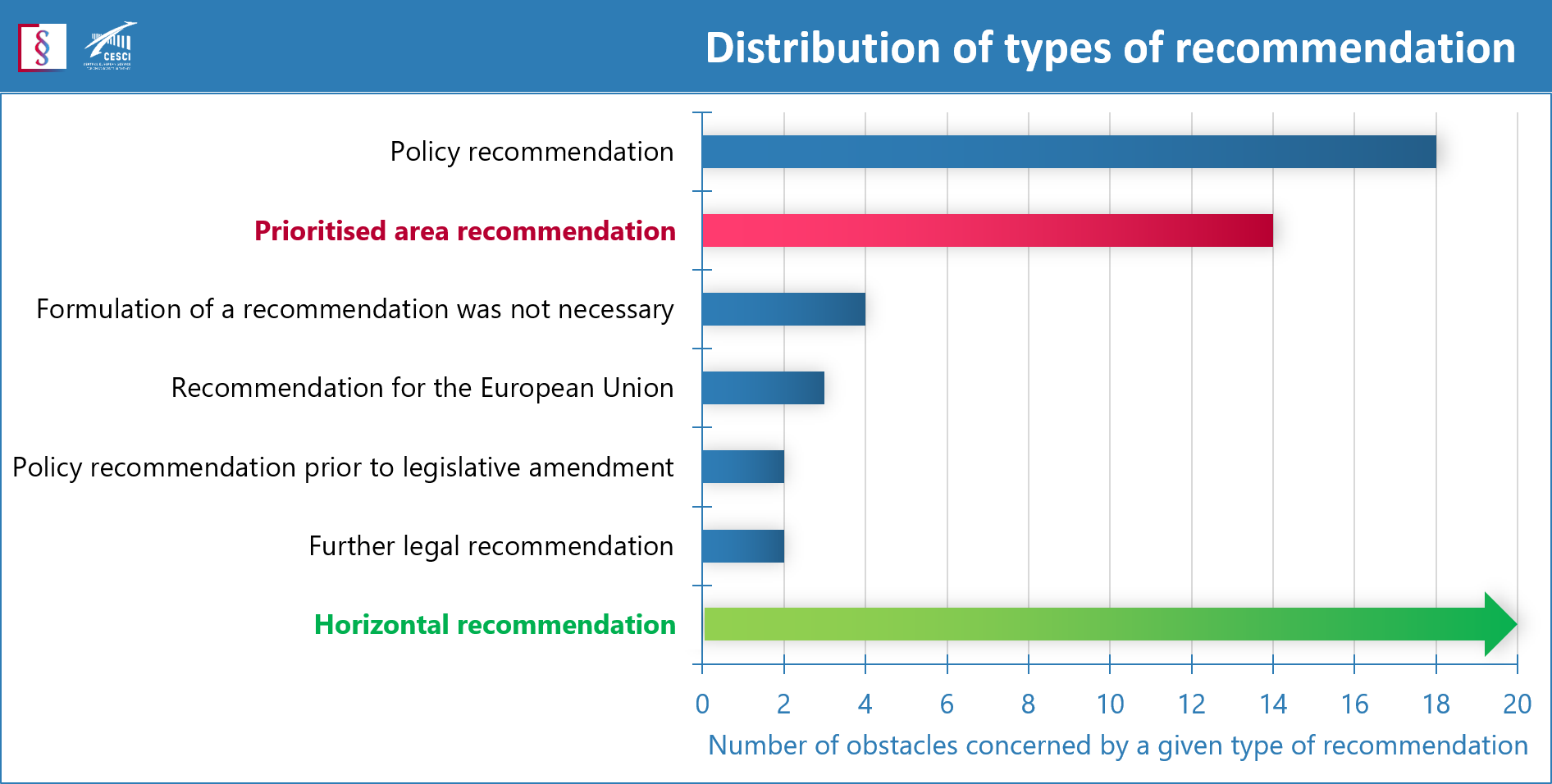
We made three types of recommendations for the removal of the barriers: if it was possible, we drafted a legal text proposal; in other cases, we made a proposal to policy interventions; and if we considered the room for manoeuvring too narrow for national level interventions, we initiated an EU level solution.
The legal recommendations can be classified again into three groups:
- proposals of bilateral agreements, the wording of the agreement included;
- proposals for modification of particular legal text;
- guidelines for the necessary modification of the legal environment.
The study also contains a horizontal or, in other words, a „meta-level” chapter which, reaching beyond the sectoral based approach makes proposals on the one hand to apply EU and national level solutions for the information of the citizens; and, on the other hand, based on the example of the Nordic Council, to launch institutionalised mechanisms, by also involving neighbouring countries, which, make the problems caused by the borders erected by the nation states manageable.
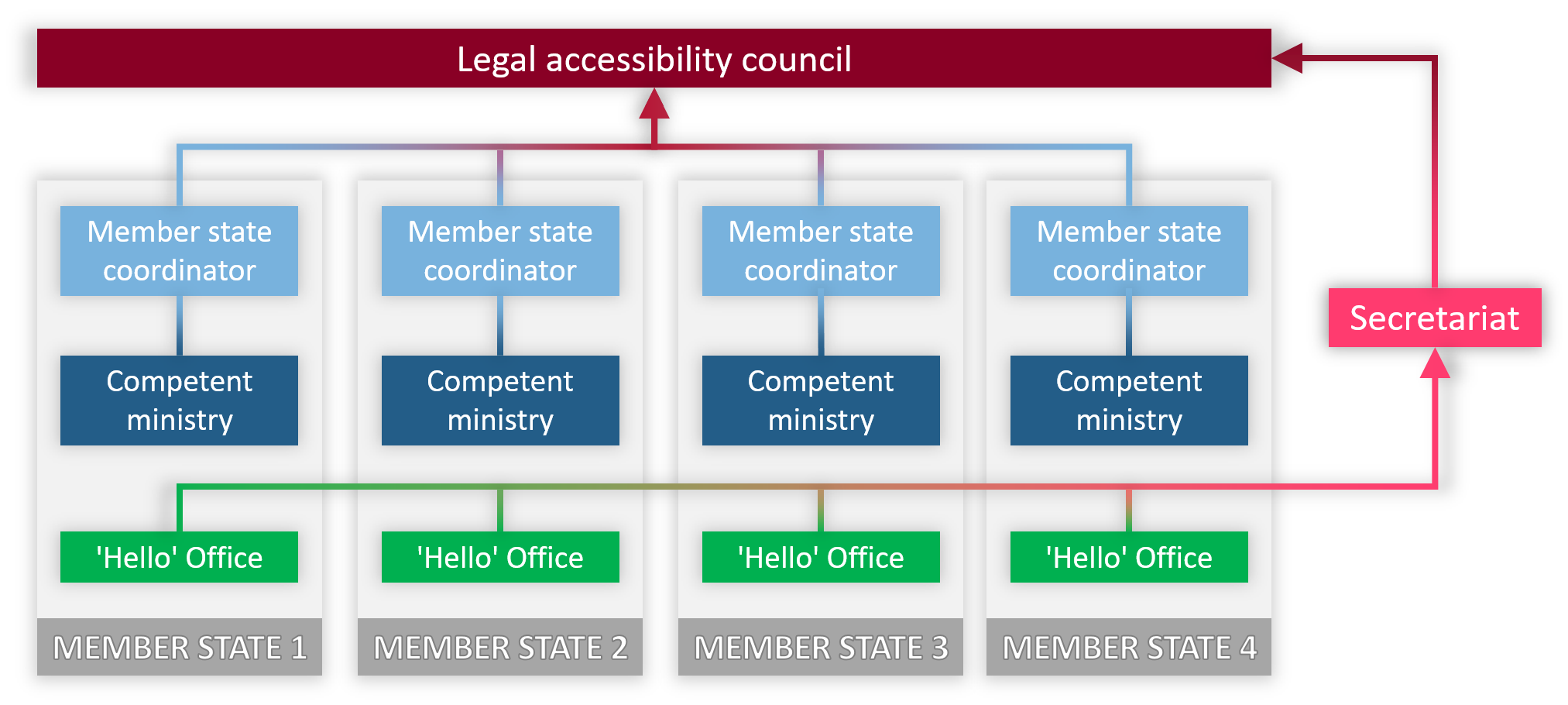
Final report (1st milestone – 2016)
You can download the final reports on the project results by clicking on the following pictures:
 |
 |
| Final report on the project | Contribution paper of CESCI to the public consultation on cross-border obstacles: 2. Report on Legal Accessibility project (2017) |
The final report intends to inform the readers about the main stages of the research project, which lasted eight months, as well as about the results of professional value that were achieved through carefully structured work. The final report means represents the official termination of the project; nevertheless, we carried out our work in a spirit that articulated new tasks and possibilities. This logic is directly mirrored in the structure of our final report, too.
After the first chapter giving a brief description of the introduction and methodology, the second chapter is set to identify the obstacles and its workflow. We describe in detail the stakeholder workshops offering an appropriate space to reveal the regulatory background that hinders interactions, as well as to identify obstacles, together with their territorial and sectoral aspects. Information collected during this stage marks the thematic ground of our research.
The third chapter describes the research revealing the background of obstacles and the compilation of recommendations. The unfolding of the background of the obstacles was in parallel with a composition of a European outlook, aiming to understand best examples and practices in relevant topics; revealing the existing regulatory environment and policy structure through sectoral interviews with the addressed experts; as well as making a detailed analysis of domestic and European legal frameworks. The compilation of the obstacles has been drafted based on this research work.
In the fourth chapter the results of the project related to each of the obstacles identified at the stakeholder workshops are presented. In each case, we specify the brief overview of the given obstacle, the best practices from Europe (if any) which can be used as models, the list of interviewees and relevant legal texts. Subsequently, we summarise, in a few sentences, our recommendations regarding the possible removal of each of these obstacles. At the end of the chapter, we give a short overview on our horizontal recommendations.
In the fifth chapter, we offer a summary of the main experiences of the project, by evaluating the fulfilment of the objectives set out within the indicators, as well as through a summary table. Finally, we compare the results of the project with contemporary trends in the European Union.
The results in European context
The European Union undergoes, at present, perhaps one of the most serious crises of its history which is fundamentally linked to the question of free cross-border mobility. It is of paramount importance what solutions will be worked out by the end of this crisis and whether these solutions hinder or facilitate free movement.
In parallel with the crisis, several EU policy debates are under way which are also in close relationship with the subject of our project. Our association submitted the application which can be considered as an antecedent of this project to the call of the DG Justice in February 2015. The objective of the proposal was to work out a comprehensive analysis within the central European region containing the unfolding of legal-administrative barriers and formulating recommendations based on West European good practices. The partnership involved several research institutes from the neighbouring countries, as well as, the ISIG from Gorizia and the MOT from Paris. Since our application was not successful, we approached the Ministry of Justice of Hungary with a similar proposal because the legal accessibility issue became (maybe not unexpectedly) a hot topic of the European discourse.
On the one hand, a project called Cross-border Review launched by Commissioner Corina Creţu attracted the attention to the significance of tackling legal and administrative problems. The project was started in the autumn of 2015. Initially, contracted experts conducted an on-line survey by which they requested the local stakeholders’ opinion on the obstacles. More than 600 responses were received from all over Europe (12 from Hungary). Based on these responses and the inputs gained at the 11 counsellors’ seminars as well as from the reactions of the participants of the expert group set-up also in the autumn, the experts started to compile the comprehensive study built on case study experiences. Our association delegated an expert to the expert group and we drafted a contributing document focusing on the analysis of territorial data. Our intention is to share also the results of the Legal accessibility project with the EU experts. At the same time, during the implementation of the Cross-border Review project, we also obtained and accumulated knowledge on certain issues which supported the realisation of the Hungarian Legal accessibility project.
When comparing the two projects, it is worth mentioning that in the case of the EU project eight sectors have been identified at the very beginning in the respect of which the analysis of the obstacles can be relevant: industry, labour market, health, transport, ICT, environment, climate change and spatial planning. At the second expert workshop held in January, 2016, the experts selected five of these eight topics that the contracted consultants would concentrate on.
At the starting phase of our project we did not follow similar preconceptions: we were interested in everything what can be a problem or obstacle for local actors. On the one hand, this approach led to the realisation of the fact that we faced numerous obstacles which were irrelevant for other countries; and, on the other, the barriers did not occur in line with a clear systematic principle or an internal logic but in an ad hoc way. It may be the reason why several „reports of obstacle” proved to be irrelevant after the interviews and the legal analysis. Regardless of this, a few problems can attract the attention also at EU level: in some of these cases we even made a proposal for their solution.
These problems are the following:
- to launch an EU student card,
- to create an EU level documentation platform of illnesses,
- to issue EU level permissions for ambulance cars,
- to create EU rules on cross-border short supply chains,
- to draft a provision supporting cross-border horse riding tourism,
- to develop an EU level solution for the abolishment of duties of duty-free products imported from third countries,
- to further develop the KEEP database to obtain real-time data.
Apart from the Cross-border Review coordinated by the DG Regio, it is worth mentioning the progress of the new legal solution initiated by the Luxemburg presidency, in 2015. The proposal of the Luxemburg presidency aims at the voluntary based introduction of a new legal tool (European Cross-Border Convention: ECBC) which would create a territorial exception with a view to resolving a sectoral problem of a given border region. For the sake of ensuring cross-border service provision, the tool would establish a legal framework independent from the legislations of the two countries with a territorial limitation in a provisional way; which would make it possible to give life to models exceeding the obstacles generated by the national provisions. The Cerdanya hospital is considered as a such exceptional example but also in the case of a cross-border tramway, numerous technical, financial and administrative rules should be taken into account which prevent the initiators from the construction of the tramway line. Although both the intention and the need are given and the economic operation of the tramway could be guaranteed, the different legal environment of the two neighbouring countries should be modified at so many points and furthermore at general, national level that finally the project will not be put in operation. The ECBC would make it possible to launch such exceptional legal solutions which would reflect to nothing but the particular problem within the given border region. Our association has, right from the beginning, taken part in the activities of the working group preparing the ECBC.
In recent years, the French Mission Opérationnelle Transfrontalière (MOT) has been drawing the attention, at numerous professional events, to the shortcomings of territorial statistics hindering cross-border cooperation and developments. Eurostat gathers data at NUTS III. (in some cases at NUTS II.) level only which are irrelevant from the point of view of direct cross-border interventions (affecting mainly local and regional stakeholders). Our association has joined this consultative process by organising a seminar in September, 2014. It is expected that the European Commission will initiate the cooperation of the national statistical institutions (NSIs) with a view to resolve this problem.
The European Union is not exclusively working with the problem of barriers. In 2014, the European Council contracted an NGO called Institute of International Sociology of Gorizia (ISIG) to unfold the most frequent cross-border legal-administrative obstacles in Europe. Its intention was to find the best practices delivering solution to these obstacles and to make all this information available through a portal updated permanently.
The portal was opened in 2015 and its database is permanently expanding, thanks to the increasing number of its end-users. The EDEN portal of ISIG meant a generous help during the realisation of the current project. Apart from this, the professional documents of the MOT and the AEBR (Association of European Border Regions) offered help to us too. AEBR supported the implementation also with professional consultancy as a project partner.
Regarding the responses on the obstacles, the way of overcoming them can be different case by case. The legal harmonisation process of the European Union yields sometimes surprising results; at the same time, the Community has achieved remarkable success from the point of view of the mitigation of the obstacles against the free movement of persons, goods, services and capital. One of the main lessons learnt from this project was that in several cases, the community acquis are already in place but there are problems with their application.
At the same time, sometimes the application of a regional solution implying bilateral agreements is more rational. It can give life even to bilateral institutionalised cooperation structures. The Legal accessibility project offers examples for both models.
Our aim was to launch the process within which the state administration limiting its focus on nation state frames by nature recognises cross-border reality as an issue to handle and its problems to tackle and approaches it with due openness. Since, as a matter of fact, when we seek for either EU level or bilateral solutions, we can be successful only with the positive attitude of the state level authorities.
Media appearance
Gotthárd TV report on the Szentgotthárd Workshop
The eight workshop within the Legal Accessibility project was held in Szentgotthárd, at the Refectory of the Common Municipality Offices, to which stakeholders active in cross-border cooperation in the Austro-Slovenian-Hungarian border region were invited. In the form of a round table discussion, two associates of CESCI were collecting information on the legal obstacles, deficiencies and best practices experienced by local actors.
Based in Szentgotthárd, Gotthárd TV broadcast a 10 minute report on the workshop on the very same day of the event in its News – a programme that after 10 years is still its fastest and most efficient forum for information and communication. The report was repeatedly broadcast over the following week: each day at 6:30 a. m. and 11 p. m., and additionally at 7 p. m. on Wednesday and Friday and at 12:00 on Sunday. The first few moments of the video feature CESCI’s planner-analyst associate presenting the elements of the project, followed by representatives of the ambulance service, the Hungarian National Rural Network (MNVH) and the police, who give their opinion about obstacles and good practices experienced during their daily work.
Thanks to Gotthard TV, you can get a glimpse of the workshop through the video below:
All rights for this video are reserved by Gotthard TV.
A written report of the workshop is also available on our website.
Completion of indicators (First milestone)
Stakeholder workshops:
- Workshops organised: 9 pc / 10 pc
- Number of attendees: 90 ps / 104 ps
- Summary reports: 1 pc / 1 pc
Sectoral interviews:
- Interviews conducted: 24 pc / 24 + 30 + 14 pc
- Sectors covered by the interviews: 8 pc / 8 + 4 pc
- Summary reports: 1 pc / 1 pc
European outlook:
- Best practice gyűjtemény: 1 pc / 1 pc
Legislation review:
- Legal inventory: 1 pc / 1 pc
Set of recommendations:
- Collection of recommendations: 1 pc / 1 pc
Final report:
- Final reports: 1 pc / 1 pc
- Final reports in English: 1 pc / 1 pc
From a formal point of view, the project achieved maximum success: we fulfilled all the indicators undertaken in our contract. At the same time, it must be admitted that in terms of substance we expected more from the project at the beginning. We thought that the local stakeholders would confront us with a host of border obstacles and we would even find solutions for the major part of them, based on the existing western European good examples. Finally, much fewer barriers were mentioned at the workshops than we had expected and it turned out later that a significant part of these were not real obstacles. In other cases, the modification of the principles of the total policy background would be necessary in order to bring about essential changes. Thus, during its realisation, the focus of the project has been slightly modified.
While at the beginning we envisaged to draft a kind of compilation of legal recommendations, at the end of the day this document has gained a strong policy accent.
Nevertheless, the current compilation of obstacles should not be considered as irrelevant, since we managed to draw the attention and (we hope) to find solution to numerous problems which make the lives of the people living in border areas difficult. We are convinced that the project was implemented successfully with results to be communicated even at EU level which opens the possibility for the continuation together with the neighbouring countries.
As far as the professional results of the project are concerned, one can state that the documents drafted indicate the starting point of a procedure; they create the opportunity for the systematic monitoring and analysis of the obstacles as well as to the institutionalised development of solutions.
Hereby, we would like to thank the Ministry of Justice of Hungary for the support making possible the implementation of this project.
Recent documents (First milestone)
The following summaries, reports and other documents were prepared in the framework of the project. You can find more information about the documents in the separate entries. You can also download each of them here.
Summary report on the stakeholder workshops (in English)
Summary report on the series of sectoral interviews (in Hungarian)
Collection of best practices (in Hungarian)
Legislative inventory (in Hungarian)
Set of recommendations (in Hungarian)
Final report (in English) (2016)
You can download all the documents (28.8 MB)
that were prepared in the framework of the project by

The project was funded by the Ministry of Justice.
The project documents and the conclusions and recommendations contained therein do not necessarily reflect the official position of the Promoter.
Aim of the second legal accessibility project is to continue the results that were achieved during the Legal Accessibility 1, as well as to continue the previous initiative that are relevant to the process of accessibility on the basis of the EU affairs experience. In the second project, we concentrate on supporting cross-border institutionalized cooperation, we want to contribute to the process of creating the necessary legal framework of this issue.
Implementation of the organizational solutions, included in the horizontal recommendations, belong to the competence of the Ministry, therefore this project proposal does not involve any of these activities for this purpose. At the same time – completely independently from the project – our association assures all the professional help in order to set up and operate the proposed organizational framework.
Objectives of the present project:
- managing the professional policy issues, obstacles identified in the first project;
- establishing of professional partnerships that help the elimination of obstacles;
- promotion of practical solutions for the identified problems in the first project.
Within the second milestone, on the one hand we implement activities that help to eliminate the legal and the policy barriers of cross-border institutional co-operation, on the other hand we articulate a proposal for a web information platform that helps the process that the Hungarian and foreign citizens are informed uniformly. Subsequently, our work does not concentrate to deeply return to the identified obstacles which discovered during the first project, but we focus only on the issue of institutional co-operation and we make a proposal on the management of shortage of information.
1. Harmonization of EGTC-legislation
Hungary is a leading student in the EU’s EGTC policy. From the 64 groupings that were registered until the end of 2016, 23 groupings have Hungarian membership and the headquarters of 19 groupings are located in our country. Although, we cannot consider that all the EGTCs do high quality work, but they totally implemented a development of 24 million euros in the border regions between 2008, when the first EGTC was established, and 2015, partly due to the government’s supportive policy. In many cases, they effectively contribute to alleviate the separating effects of nation-state borders.
Hungary was the first country that helped to establish the first association within the Union that has a non-EU member country, namely the Tisza EGTC (established by the Szabolcs-Szatmár-Bereg County Council, city of Kisvárda and the Zakarpattia Oblast). That means there is only Serbia, from the neighbouring seven countries, where the necessary legal background is not available to establish this kind of association. Serbia ratified the Framework Convention of Madrid in the early 2016 (among the last members of the Council of Europe); however, framing up of the implementation rules are delayed.
Hungarian experiences, the Hungarian model could significantly help to our southern neighbour in order to make the missing steps, thus allowing to build Serbian relationships of the already established Banat-Triplex Confinium and the EGTCs that will be established in the future.
Therefore, in the framework of the project we will initiate the development of the necessary legislative background and its delivery to the Serbian authorities. Implementation is helped that CESCI Balkans, as the initiative of our Association, was established in 2015 with headquarter in Novi Sad. CESCI Balkans performs its activities in professional relationship with the ministries in Belgrade.
Planned activities of the project element:
- exploring and analysing the Serbian legal environment and legislation that ratified the Framework Convention of Madrid;
- consultation about the legislation on implementation with the competent Serbian authorities;
- organization of an international conference about the EGTC regulation and its Hungarian applications in Belgrade;
- to elaborate a legislative proposal in order to implement the EGTC regulation in Serbia.
Results / Harmonization of EGTC-legislation (2nd milestone)
The study (Harmonization of EGTC-legislation) prepared in the frames of this subproject can be downloaded by clicking on the picture below.
Results of the subproject were summarized in the following points. Click on the text for details.
Objective of the subproject
The subproject contains the following objectives:
- exploratory study about the Serbian legislation ratifying the Madrid Convention;
- organization of an international conference on the EGTC in Serbia;
- elaboration of a legislative proposal for applicability of the EGTC Regulation in Serbia;
- consultation with the competent Serbian authorities on the implementing legislation.
Presentation of the activities that were implemented within the frame of the subproject
1. Study on exploring and analysing the Serbian legislation and its environment ratifying the Madrid Convention
The Balkan office of the Central European Service for Cross-Border Initiatives elaborated a study about Legal Accessibility. The title of the study, Legal Accessibility. Serbia’s Participation in European Grouping of Territorial Cooperation (EGTC) and Euroregional Cooperation Grouping (ECG). During the preparation of the study, experts of the CESCI Balkans made coordination with the Serbian government institutions, with the Ministry of Public Administration and Local Self-Government, and with the Ministry of European Integration.
The study analysed those possibilities that are offered by the Madrid Convention for Serbia, the territorial policy of the European Union, cross-border structures located in the Balkans, or the authors gave recommendations, solutions for applying EGTC and ECG.
Goal of the Madrid Convention is to encourage and facilitate cross-border agreements between local and regional authorities within their spheres of competences. The three protocols, supplementing the Convention, help to develop new cooperation, including also the transnational level, and to define the legal status, creation and operation of Euroregional Cooperation Groups (ECGs).
The study mentions the European Union’s regional policy, with particular reference to European territorial cooperation and cross-border cooperation programs. In a separate chapter, the study deals with cross-border structures and cooperation in the Balkans, and at the same times it maps their most important activities and projects. Unfortunately, only 7 of the 26 Euroregions in the Balkans can be considered as active on the basis of the methodology of the study (based on the activities of the last 12 months).

Currently, the entities of the Republic of Serbia cannot participate in EGTC and ECG as full members. Serbia ratified the Madrid Convention in the beginning of 2016; subsequently, there is no formal obstacle, on the basis of the EU regulation, that the entities of the EU Member States establish EGTC with the Serbian entities. Two possible solutions are described in the relevant chapter of this study:
- the Serbian Government creates and accepts an implementing legislation that regulates the licensing process of membership and the conditions of governmental institutions and local / regional authorities for participating in such associations;
- or Serbia and the concerned Government of the Member State sign a bilateral agreement about the issues described above.
Finally, the study proposes the establishment of ECGs with Serbian participation, and it specifies the details of the founding process.
2. Legislative proposal for the applicability of the EGTC Regulation in Serbia
Within the frames of the project, a proposal was developed for the EGTC legal harmonization process in Serbia. The proposal includes all the elements that may be relevant for the licensing process of the membership, or the rules regulating the conditions of participation of actors; provisions on establishment and organs, financial and economic activities, supervision and control of EGTC, or rules relating to the conditions of termination.
The legislative proposal defines the Serbian name of the European Grouping of Territorial Cooperation, its possible membership and the competent state authority, the Ministry which is responsible for registration.
The proposal was intended to get before to the Serbian Government after coordination with the competent ministries (Ministry of Public Administration and Local Self-Government, as well as Ministry of European Integration).
3. Organization of an international conference on the EGTC Regulation
An international conference was organised with title, New opportunities of cross-border cooperation in the Balkans, on 20th of November, 2017. The conference was organised by the Balkans office of the Central European Service for Cross-Border Initiatives in Novi Sad, in the Parliament of the Autonomous Province of Vojvodina.
The aim of the international conference was to promote cross-border cooperation in Serbia that has been preparing for the EU accession, to call the attention of the Serbian decision-makers to the potentials of institutional cooperation and to encourage these decision-makers to adopt the necessary legislation.
The first panel was about those legal instruments that were established by the Council of Europe and by the institutions of the European Union. The Madrid Convention and its offered possibilities were mentioned. Then, good examples were presented by the concerned representatives and experts within the second panel. The final panel included the possibilities of Serbia relating to the development of border regions, which can be implemented through proven legal instruments.
It was expressed at the conference that it is important to pay attention to the fact that regions, municipalities and settlements can participate in cross-border regional cooperation.
Almost 150 people participated at the conference, especially the leaders and the representatives of municipalities, the representatives of the institutions in the neighbouring countries and different organizations were present. The conference was opened by István Pásztor, President of the Assembly of the Autonomous Province of Vojvodina. The speakers of the conference were the following ones: Hajnalka Juhász, Head of the Ministerial Cabinet, Ministry of Justice, Hungary; Slobodan Vukčević, Ambassador of the Ministry of Foreign Affairs of the Republic of Serbia; Tim Cartwright, Head of the Council of Europe Office in Belgrade; Martín Guillermo Ramírez, General Secretary of the Association of European Border Regions; Slaven Klobučar, EGTC Platform Coordinator of the Committee of the Regions; Patrícia Abaffy, Deputy Head of the Ministry of Foreign Affairs and Trade of Hungary; Yolanda Puiggrós Jiménez de Anta, Legal expert of Roca Junyent; Zoltán Bara, Director of the Slovakian Pons Danubii EGTC; Ana Nikolov, Directress of the AEBR Balkans and Director of Planning, CESCI Balkans; Sanda Šimić, Ministry of European Integration of the Republic of Serbia; Gyula Ocskay, Secretary General of the Central European Service for Cross-Border Initiatives (CESCI) and Ervin Erős, Director of the CESCI Balkans.
Summary of the subproject results
The objectives of the subproject were successfully achieved. The analytical study, exploring the Serbian legislation that ratified the Madrid Convention, was prepared, international conference was organized with 144 participants and the most relevant speakers, lecturers were present. A legislative proposal was elaborated for the adaptation of the EGTC Regulation in Serbia. The process of EGTC legal harmonization with the relevant Serbian authorities was launched.
Fulfilment of the identified indicators of the subproject
- Analysis of the Serbian EGTC legal environment: 1 analysis / 1 analysis
- International conference on EGTC (Serbia): 1 conference / 1 conference
- Number of participants at the EGTC conference: 60 persons / 144 persons
- Legislative proposal: 1 proposal / 1 proposal
Possibilities for continuing the subproject
The first cross-border association with a member entity from third country was established in the EU, namely Tisza EGTC, and the seat of this association is in Hungary. Out of the seven neighbouring countries, only Serbia is the only one, where the necessary legal background is not available in order to establish such associations. Although, Serbia ratified the Madrid Convention (as one of the last Member State of the Council of Europe) in early 2016, but drafting of the implementation rules are delayed.
Primarily, the subproject was intended to launch the development of the necessary legislative background in Serbia. Given that the legislative proposal was completed, the CESCI Balkans office will continue the coordination with the relevant ministries, namely with the Ministry of Public Administration and Local Self-Government, with the Ministry of European Integration and with the Ministry of Foreign Affairs in order to get the legislative proposal to the Serbian Government after final consultations. This process has been supported since the beginning by the Council of Europe and by the Department of Economic Development of Border Aras of the Hungarian Ministry of Foreign Affairs and Trade which is responsible for EGTCs. During 2018, the CESCI Balkans intends to put special emphasis on further steps of legislative harmonization in Serbia, as well as to promote the benefits of the EGTC. Subsequently, it launches a new initiative together with the Council of Europe in 2018, namely Leadership Academy for CBC.
Hungary was the first country that helped to establish the first association within the Union that has a non-EU member country, namely the Tisza EGTC (established by the Szabolcs-Szatmár-Bereg County Council, city of Kisvárda and the Zakarpattia Oblast). That means there is only Serbia, from the neighbouring seven countries, where the necessary legal background is not available to establish this kind of association. Serbia ratified the Framework Convention of Madrid in the early 2016 (among the last members of the Council of Europe); however, framing up of the implementation rules are delayed.
Hungarian experiences, the Hungarian model could significantly help to our southern neighbour in order to make the missing steps, thus allowing to build Serbian relationships of the already established Banat-Triplex Confinium and the EGTCs that will be established in the future.
Therefore, in the framework of the project we will initiate the development of the necessary legislative background and its delivery to the Serbian authorities. Implementation is helped that CESCI Balkans, as the initiative of our Association, was established in 2015 with headquarter in Novi Sad. CESCI Balkans performs its activities in professional relationship with the ministries in Belgrade.
Planned activities of the project element:
- exploring and analysing the Serbian legal environment and legislation that ratified the Framework Convention of Madrid;
- consultation about the legislation on implementation with the competent Serbian authorities;
- organization of an international conference about the EGTC regulation and its Hungarian applications in Belgrade;
- to elaborate a legislative proposal in order to implement the EGTC regulation in Serbia.
2. Healthcare integration
In the frames of the first legal accessibility project we managed to find numerous examples from Western Europe, where cross-border healthcare is provided – even without EU regulations. In all cases, the aim was to improve the quality of life of those living in the border regions. The quality of life of Hungarian citizens as well as those (often Hungarian-speaking) living on the other side of the border is greatly influenced by the often remote national level healthcare institution, instead of which there can be available service in the immediate vicinity, on the other side of the border. Moreover, this proximity can mean life in many cases. In the course of our research we explored how these services can be financed based on the relevant EU provisions, and it also became clear, what major legal and administrative obstacles are hindering the cross-border movement of emergency care vechicles. In the framework of this project we would like to carry forward the results of the first project and to develop a specific action plan in order to provide the legal-administrative conditions of cross-border emergency ambulance services and to promote institutional cooperation.
Content of the project component:
- establishment of an ad-hoc working group involving authorities and experts concerned;
- a detailed overview of the current system;
- drafting a specific regulatory and policy document on proposals from the members of the working group, with regard to emergency services within our internal EU borders.
Results / Healthcare integration (2nd milestone)
The study (Healthcare integration) prepared in the frames of this subproject can be downloaded by clocking on the picture below (in Hungarian).
Results of the subproject were summarized in the following points. Click on the text for details.
Objective of the subproject
During the Legal Accessibility project, implemented in 2016, cross-border integration of health care services was identified as a priority topic, because numerous different questions emerged in the domain of this topic at the stakeholder workshops, and whose legal background is very complex and fair-reaching. The identified legal and administrative obstacles principally gathered around two topics, namely cross-border movement of patients and cross-border emergency activity. During the planning of the project in 2017, cross-border rescue activity received bigger attention. This happened because the professional agencies, which were addressed during the first project, were committed to the initiative. On the other side, the chosen topic seemed to be more manageable as the issue of cross-border movement of patients.
Aim of the subproject was to make a detailed analysis of the legal and administrative background of cross-border emergency activity with help of a professional working group, and we articulated proposals in order to terminate the existing obstacles. Hence, we wanted to achieve
- to improve the access of the citizens to emergency medical services in the border areas;
- thus, improving the quality of life of the citizens living in the border areas;
- and in the long run to contribute to more economical and more efficient operation of rescue, as well as emergency health care network through cross-border integration.
We think that the subproject was successful, since it effectively triggered a debate between the domestic competent authorities and professional bodies, as well as legislative proposals and policy recommendations were drafted in order to eliminate the existing domestic obstacles.
Presentation of the activities that were implemented within the frame of the subproject
Manager of the subproject was Enikő Hüse-Nyerges, a project manager. Working plan was prepared on 3rd of May.
Within the frame of the subproject, a study was prepared about the possibilities for organizing cross-border emergency rescue. The study included comprehensive, concrete legislative and policy proposals. The study was prepared between June and November, in 2017.
A working group with experts was set up in order to support the professional preparation of the study. The working group had 4 meetings during the duration of the project. Besides, taking into account the complex financing background of the issue, two experts were entrusted with the task to elaborate the related chapters. The relevant request was sent to the National Health Insurance Fund of Hungary on 13th of June, and we made a contract with two experts, recommended by Deputy Chief of Health, Zsolt Kiss. The two involved experts were Brigitta Paragh and Dr. László Kőrösi.
The following experts were involved within the work of the working group, except the CESCI members (Enikő Hüse-Nyerges, Dr. Norbert Jankai):
- Niertit Annamária Barbélyné, Head of Department, Department of Health Administration, Deputy Secretary of State for National Medical Tasks, Ministry of Human Capacities
- János Bathó, Head of Organization, National Ambulance Service
- Anett Blága, Administrative Adviser, Department of Health Administration, Deputy State Secretary for National Health Officers, Ministry of Human Capacities
- Pál Golopencza, Chief Medical Officer, National Ambulance Service
- Miklós Gresz, Professional Advisor, Health Care Planning Department, National Healthcare Services Center
- Anett Jova, Legal Advisor, Administrative and Legal Department, National Ambulance Service
- László Kőrösi, Deputy Head of Department, General Finance Department, National Health Insurance Fund of Hungary
- Mária Lórántfy, Regional Director, National Ambulance Service
- Brigitta Paragh, Deputy Head of Department, Department of International Relations and Legal Records, National Health Insurance Fund of Hungary.
We invited other experts to participate within the activities of the working group from the Ministry of Human Capacities, Department of EU and International Health and Social Affairs, and the experts from the Ministry of Foreign Affairs and Trade, but they did not want to participate in the joint work.
The working group had 4 meetings altogether: on 6th of July, on 13th of September, on 11th of October and on 23rd of November.
At the first meeting of the working group, critical questions of legal harmonization were identified by a narrow circle of participants (National Ambulance Service, National Health Insurance Fund of Hungary) with the help of CESCI staff. These critical issues go far beyond the health and professional fields, thus, they affect also other domains, like the issue of transport, information communications and the language competence of participants in rescue. Besides, the participants, with the representative of the National Health Insurance Fund of Hungary, thoroughly analysed the domestic and EU aspects of the funding background of health rescue activities. The participants began to identify the EU and national legislation which play relevant role in each topic, as well as they surveyed the possibilities to overcome obstacles. At the end of the meeting, they agreed on further tasks and about the scheduling.
At the second meeting, the number of participants of the working group was extended by the representative of the National Healthcare Services Center, who raised several important questions and issues in the field of cross-border rescue activity. Majority of the questions were either fully or partially answered at the meeting, but in several cases there was a need for further information gathering, legal analysis or involvement of an expert from the sector. During the second part of the meeting, the participants began to clarify the methodological questions relating to the theoretical designation of border area health care and to identify the data and information that were required by the given task.
At the beginning of the third meeting, CESCI reported on the progress of the project in the domain of clarifying professional issues and data collection. They expressed that since the previous meeting, they managed to contact with the experts of Pro-M Zrt., who assure radio services for the National Ambulance Service, as well as they contacted the company that assures ambulances and personnel staff and who answered the previously emerged questions. Subsequently, the participants with the help two experts from the Ministry of Human Capacities, National Health Office of Health Care Administration, reviewed the possibilities of extending the permits in order to carry out foreign rescue activity and they formulated their final proposal. During the second half of the meeting, the questions that were previously unanswered were clarified and the methodology for the theoretical designation of border area health care was finalised, too.
Before the fourth meeting of the working group, the comprehensive study, involving the main results of the subproject, and the draft of the bilateral agreement on cross-border emergency rescue operations were completed. Both materials were shared with the experts of the working group before the meeting. The experts sent their questions and suggestions to the prepared documents before the meeting. At the meeting, the suggestions were reviewed separately and they clarified the content of the disputed parts. On the basis of this, CESCI staff finalised the above mentioned documents.
Debated at the meetings of the working groups, legal and administrative obstacles, which hinder ambulance vehicles to cross the borders in emergency case, affect numerous areas besides health care. In order to clarify these issues, we contacted the following actors with the aim to gather information.
- We proposed to establish bilateral agreements about free crossing of non-Schengen borders. In order to clarify whether this bilateral regulation violates higher international, European regulations or not, we consulted it with the staff of the General Border Police Department of the National Police Directorate.
- We consulted about the possibilities of establishing a radio link between the ambulance and the control centre after crossing of the borders with the office of the Directorate-General for Law Enforcement of Hungarian National Police Headquarters, as well as with the employees of the Pro-M Zrt., functioning within the frames of the National Infocommunications Service Company.
- We asked the ERIX Biztosítási Alkusz és Tanácsadó Kft. about the CASCO and liability insurance of ambulance, as well as about the territorial scope and extent of liability insurance of the personnel.
- In order to formulate proposals for eliminating the identified obstacles, we contacted the Secretariat of the Nordic Council in Copenhagen, who provided assistance in order to understand the details of rescue cooperation that is implemented on the Swedish-Norwegian border, and they sent us the related basic documents for internal use.
For the spatial modelling of border areas, which was implemented within the framework of the study, an extensive data collection was needed. In order to obtain the data, we contacted the following organizations and institutions with the help of the working group members:
- Landessicherheitszentrale Burgenland GmbH (Burgenland Security Center) – Austria
- Rotes Kreuz Burgenland (Burgenland Red Cross) – Austria
- Internationale und Europäische Angelegenheiten der Sozialversicherung (Association of Austrian Social Insurance Institutions) – Austria
- Úrad pre dohľad nad zdravotnou starostlivosťou (Health Surveillance Authority) – Slovakia
- Zavod za zdravstveno zavarovanje Slovenije (Institute for Health Insurance of Slovenia) – Slovenia
- Ministrstvo za zdravje (Ministry of Health) – Slovenia
- Hrvatski zavod za hitnu medicinu (Croatian Emergency Agency) – Croatia
- Tisza ETT – in relation to Ukraine
- Transcarpathian Health Department – Ukraine
- CESCI Balkans – Serbia.
Summary of the subproject results
The starting point of the subproject
The starting point was the analysis that was implemented by CESCI in 2016, whose main findings were the followings.
- The current regulation of emergency rescue emphasizes strict territoriality. The EüM Decree no. 5/2006. (II.7.) clearly covers the territory of Hungary. On the other hand, the mentioned decree (obviously for quality assurance reasons) provides a very limited scope for the units outside the National Ambulance Service, including the ambulance services beyond the border. The EüM Decree no. 2/2004. (XI. 17.) on the register of authorization of healthcare providers, and the health professional list includes the material and personal conditions necessary for rescue operation. In order to take part in patient transport outside of the frames of the National Ambulance Service, there is need to obtain the relevant operating license from the relevant authority, but this is fully unrealistic in case of disaster situation, and it restricts the health care rights of the EU citizen who has suffered an accident.
- This is the reason that the neighbouring countries use a practice of signing bilateral agreements that relate to disaster situations. Hungary has valid agreements with all its neighbours, these agreements make details about the conditions for interventions across the border (based on commonly agreed definitions), about the scope of the competent bodies that can be involved into the assistance, about the responsibility for coordination, about the rules for the rescue teams and setting of the costs associated with the assistance.
- During the project in 2016, it became clear that regulations in the domain of traffic do not allow to use the distinctive sign by the ambulances beyond borders of a country, thus it significantly influences the manoeuvring options of these vehicles.
- Beyond the above mentioned legal obstacles, other viewpoints also have to be taken into account, like technological (radio communication), linguistic and other administrative and financial aspects, which currently appear as administrative obstacles.
- According to the surveyed experts, development of the system with cross-border rescue services is only imaginable through gradual, step by step establishment. First, it should be achieved that ambulances can freely cross the border and that the injured person can be delivered to the nearest hospital according to their citizenship. Subsequently, cross-border sharing of hospital emergency services could take place.
Contribution of the expert working group
Contribution of the working group to the final documents seemed to be very fruitful and useful, because the participating members had knowledge about the regulatory background of their own field of expertise and it significantly contributed to the exploration of the full range of existing problems and obstacles, and to the formulation of solution proposals, as well as to develop of the required methodology, to obtain the data that was needed for spatial modelling of border areas.
Besides, the preliminary concept of the CESCI was partly modified on the advice of the participating experts. According to the original idea, we wanted to take steps to enable sharing of cross-border hospital emergency services. This would mean in practice that in case of emergency rescue, the patient would not be necessarily transported to the nearest domestic hospital, but the patient would be transported to the nearest hospital, where he/she can receive appropriate health care service, even in the case when the hospital is located beyond the border. In the case of emergency care, there are no legal and funding barriers in this respect; however, equal opportunities of the injured would be violated. In order to avoid this, the experts advised that regardless of whether domestic or a health care rescue unit beyond the border provides a health care for the injured person, it should always be considered whether the patient would receive higher standard and/or faster patient care in the state of action or in a neighbouring state. However, opening of borders in this specific issue would generate capacity and financial risks because of the expected increase in emergency cases. The volume of the expected increase is not known, yet. Therefore, the problem goes far beyond the scope of this project and study; consequently, we only dealt tangentially with this specific topic.
The main findings and suggestions of the study
The expert study can be divided into three major parts:
In the first part of the document, we provide a brief overview about the justification of the cross-border movement of ambulances, as well as we introduce the related European Union processes. Then, we give a theoretical introduction into the basic elements of the emergency care services, and we describe the domestic emergency system and the emergency system of the neighbouring states, taking particular attention to factors that affect cross-border cooperation.
In the second, most prominent part of the document we analysed the conditions of implementing cross-border emergency rescue through thematic approach, then we formulated legal and policy recommendations. The following topics were processed in this chapter:
- the conditions for crossing the border: Schengen, non-Schengen internal borders and external borders
- operating licenses: material and personal criteria
- use of distinctive signs and their criteria
- administrative-technical issues: liability and vehicle insurance, fuelling, travel notes, etc.
- professional cross-border cooperation from rescue alert to patient hospitalization
- communication: radio contacts, linguistic obstacles
- financial questions: financial aspects of rescue activity and emergency hospital care.
The formulated legal proposals and policy recommendations in the document were separately summarized on European, bilateral and national level, we reviewed the priorities of the recommendations, time horizon for implementation and we formulated a series of actions that aimed practical implementation.
A) We made a proposal at the European level to define the concept of cross-border rescue, mutual acceptance of operational and distinguishing signs beyond the border (similar to the Directive No. 2011/24). The applicability of the Directive would be based on the condition that the involved member states voluntarily settle the terms and conditions of cross-border cooperation.
B) We recommend to regulate the following aspects of cross-border rescue through bilateral agreement:
- cross-border zones that might be included within cross-border rescue activity;
- free movement of rescue vehicles using distinctive sign within non-Schengen borders;
- the type, minimum conditions and competences of the rescue team that ca be sent across the borders;
- the sequence of alarm and command of the rescue unit beyond the borders;
- details of the cooperation between domestic competent units (ambulances, dispatch centre, etc.) and rescue units beyond the borders;
- the sequence of transferring the patient to the domestic rescue unit or transporting the patient into the hospital.
- protection and support for the rescue units beyond the border;
- setting up a translation service that helps the rescue.
C) Depending on the new provisions at European and bilateral level, in some cases it is necessary to implement amendments within the related domestic legislation. The new proposed legislations will affect the content of the following domestic provisions:
- content extension of the Decree No. 96/2003. (VII. 15.) on the general conditions for providing health care services and on provider licensing relating to the mutual acceptance of operating licenses;
- modification of the Decree No.5/2006. (II.7.) EüM on Emergency Rescue Services relating to personal and material conditions, alarm and command of rescue units beyond the borders, as well as transferring and transporting the patient to hospital;
- content extension of the Decree No 12/2007. (III.13.) IMR relating to distinguishing signs;
- modification of the Decree No. 41/2004. (IV. 7.) GKM relating to distinguishing signs.
D) Policy recommendations, priority of the recommendations, or the necessary action steps, their time horizon and costs for implementation
It became clear during the project that modification of the legal instruments alone is not enough in order to establish the conditions for cross-border emergency rescue activity, hence formulation of policy recommendations at European and/or bilateral level is necessary for each concerned topic.


In the third part of the study, we modelled and analysed the territorial aspects and potentials of cross-border rescue and emergency hospital care at the theoretical level.
- 50 km from the border crossing point, based on the methodology that is used in the Hungarian Emergency Rescue system, we have determined the area of 50 minutes availability, where it is worth to explore the possibility of allowing cross-border rescue activity. According to the participating experts within the project, this is the area, where the injured person can get access to appropriate on-site or hospital care by the rescue units of the neighbouring state.
- During the analysis of the territorial pattern of rescue services at the border, we took into account the location of the rescue stations and border crossing points, as well as time factor which is related to the arrival of the rescue unit to the given location (15 and 30 minute zones).
- Within the frame of the project, we had only limited scope to deal with legal and administrative aspects of cross-border emergency care and its possibilities, we wanted to point out the potentials of cross-border cooperation. This chart illustrates emergency hospitals within border area that are identified within the project; as well as it attempts to visualize the spectrum of benefits offered by the given institutions.
This and elimination of all the other obstacles clearly require not only the effective and high-level cross-border cooperation among wide range of professional organizations, but there is a need for co-operation and problem-solving intention at high political level between neighbouring member states; however, we currently experience shortcomings in this domain.
Fulfilment of the identified indicators of the subproject
- Ad-hoc health care working group : 1 working group / 1 working group
- Number of meetings of the health care working group: 4 meetings / 4 meetings
- Number of invited experts into the ad-hoc working group: 10 persons / 12 persons
- A regulatory and policy document on cross-border transport of patient: 1 regulatory and policy document / 1 regulatory and policy document
Possibilities for continuing the subproject
Based on the formulated proposals and the identified difficulties, the following continuation option is conceivable.
- In order to organize a cross-border emergency rescue, we recommend to address and involve the competent authorities of the neighbouring countries, hence exploring the opinions of the authorities on existing policy orientations and developments in the neighbouring countries. This could allow the formulation and finalization of bilateral proposals for legislative harmonization.
- The other segment of cross-border emergency cooperation is embodied by the emergency hospital care. Nevertheless, cross-border sharing of hospital health care services carries unknown degree of risk, which is unacceptable for the member states. In order to handle the situation, it would be necessary to make a detailed analysis of the issue and to quantify the volume and consequences of potential cross-border patient movement.
Working group meetings (Healthcare integration)
In the first phase of the project we identified the most important actors involved in the issue of cross-border emergency services and invited them to participate in the project as well as in the working group. Representatives were sent to the working group from The National Ambulance Service (NAS; Országos Mentőszolgálat or OMSZ in Hungarian), the National Institute of Health Insurance Fund Management (Hungarian acronym: NEAK), the National Healthcare Service Center (ÁEEK), and the Ministry of Human Capacities, Office of the Chief Medical Officer (EMMI).
1st working group meeting – Budapest, 6 July 2017
In the framework of the first working group meeting, a smaller group of the participants (OMSZ, NEAK) assisted by the employees of CESCI identified the issues that are critical in terms of legal harmonisation. These significantly go beyond the medical-professional sector, covering inter alia transport, communication and the language competence of those taking part in emergency services. In addition, with the representative of NEAK, they reviewed comprehensively the domestic and EU aspects of the emergency service’s funding. Those present began to identify EU and national laws relevant to specific subjects, and to review options with the aim of surmounting obstacles. At the end of the meeting they agreed on the further actions and their scheduling.
2nd working group meeting – Budapest, 13 September 2017
The second working group meeting took place with the former participants, together with the employee of the ÁEEK, who phrased several questions covering cross-border emergency services in detail, but important in terms of practical implementation: In the case of services performed abroad, how should the waybill be completed? What kind of protection are ambulance services provided with abroad? , etc. The majority of the questions was partly or fully answered in the course of the meeting, however there were cases that required further gathering of information, review of legislation or the involvement of sectoral experts. In the second half of the meeting, participants began to clarify methodological issues necessary to the designation of the health service zones along the borders and to identify the requirements for data and information, necessary for the fulfilment of the task.
3rd working group meeting – Budapest, 11 October 2017
The third working group meeting was opened by the employees of CESCI, who reported on the progress of the project as regards the clarification of technical matters and data collection. They said, that during the period since the previous meeting, they managed to contact the experts of Pro-M Zrt., the provider of radio communication for OMSZ, as well as companies providing ambulances and the staff with insurance, who answered the questions raised previously. Subsequently, together with two employees of the Ministry of Human Capacities, Office of the Chief Medical Officer (EMMI), they reviewed the possibilities of extending the authorisation and permission necessary for performing emergency services abroad, and outlined their final proposals to that effect. In the second half of the meeting, the questions that formerly remained unanswered were clarified and the methodology of designating health service zones along the borders was finalised.
4th working group meeting – Budapest, 23 November 2017
The draft version of the overall study and the proposal on the bilateral agreement, as the main outputs of the project were delivered and sent to the members of the working group in the middle of November. The experts reviewed the documents and shares their questions and comments before the forth working group meeting. During the meeting these questions and remarks were discussed and clarified one by one. Following the meeting, the experts of CESCI have modified the concerned documents accordingly.
Data collection (Healthcare integration)
Legal and administrative obstacles discussed at the meetings, that are hindering the border-crossing of ambulances in cases of emergency concern several fields beside healthcare, including transport, communication and other administrative matters. In order to clarify the related questions, we contacted the following actors:
- We have proposed to set-up bilateral agreements concerning the free movements of emergency care vehicles through the border with the neighbouring countries out of the Schengen zone. In order to clarify whether this proposal breaks any national or EU regulation, we addressed the employees of the Border Control Department of the National Police Headquarters.
- With the possibility of establishing radio communication between ambulances and the foreign dipatcher centre, we addressed the employees of the National Police Headquarters and the Pro-M Zrt. operating within the National Infrastructure Development Company (NIF Zrt).
- Concerning the territorial scope of the ambulances’ comprehensive insurance and liability insurance, as well as the liability insurance of the staff, and the possibility of its extension, we consulted the ERIX Biztosítási Alkusz és Tanácsadó Kft (insurance broker and consulting company).
- In order to outline proposals on removing the obstacles encountered, we contacted The Nordic Council of Ministers’ Secretariat in Copenhagen, who provide details about the healthcare cooperation on the Swedish-Norwegian border.
To obtain the necessary data for the designation of health service zones along the borders we contacted the following organizations and institutions:
- Landessicherheitszentrale Burgenland GmbH – Austria
- Rotes Kreuz Burgenland (Austrian Red Cross) – Austria
- Internationale und Europäische Angelegenheiten der Sozialversicherung (Associationof Austrian Social Insurance Institutions) – Austria
- Úrad pre dohľad nad zdravotnou starostlivosťou (The Health Care Surveillance Authority) – Slovakia
- Zavod za zdravstveno zavarovanje Slovenije (The Health Insurance Institute of Slovenia) – Slovenia
- Ministrstvo za zdravje (Ministry of Health) – Slovenia
- Hrvatski zavod za hitnu medicinu (The Croatian Institute of Emergency Medicine) – Croatia
- Tisza EGTC – Ukraine
- Transcarpathian Department of Health – Ukraine
- CESCI Balkans – Serbia
3. Local products, short supply chains
The issue of local products is strictly regulated throughout Europe and it is maintained in the competences of the member states. The association of Kislépték (Association of Interest Representatives of the Manufacturers and Service Providers) successfully prepared Hungarian legislation in the area of local producers and short supply chains in the last years.
People who live in the border regions are in a disadvantageous situation because of the current territorial restrictions, thus they can acquire healthy local products from a much smaller area than those people, who live in the inner parts of the country. Within the frame of the current project, we would like to put together a proposal that is able to manage this discrimination. Subsequently, we involve the experts from the Kislépték into the legislative preparatory work.
Content of the project element:
- establishing a working group with the involvement of experts, representatives of the Ministry and the Kislépték;
- proposing legal and policy proposal that address the competitive disadvantages and discrimination against the local producers of border regions.
Results / Local products (2nd milestone)
The study (Local products) prepared in the frames of this subproject can be downloaded by clicking on the picture below (in Hungarian).
Objective of the subproject
During the 2016 project, Legal Accessibility, the issue of cross-border trade of local products was identified as a priority topic, since this question, which has a complex legal background, appeared at numerous stakeholder-workshops. Subsequently, during the 2017 project design, the topic of local products and cross-border supply chains received special emphasis.
The aim of the subproject was to reveal the legal background of the specific issue in details and to formulate suggestions in order to remove the existing obstacles. Revealing of the legal background and formulation of suggestions took place with the help of external experts and with the help of a working group on the other hand. We wanted to achieve
- to alleviate the disadvantageous situation of people in border areas, caused by the territorial scope of the Hungarian legislation on local markets, through extension of the 40 km zone, which appears in the Hungarian market regulation, into the areas beyond the border;
- to contribute that people who live along the border are supplied by healthy food and to improve their quality of life;
- to start and to increase the interaction of the previously organically linked cultural landscapes, which are fragmented by borders, and to weaken the separating effect of the borders through creation of a unifying economic space;
- to widen the market opportunities for the small-scale producers through mutual opening of sale opportunities of the neighbouring states towards each other.
Although, the subproject did not bring the expected results, thus we had to leave the idea to harmonize legislation, and we formulated alternative suggestions in order to meet the original objectives.
Presentation of the activities that were implemented within the frame of the subproject
Leader of the subproject was the Secretary General, Gyula Ocskay, the working plan was completed on 10th of May.
In the framework of this subproject, a comprehensive study was written about the legal and policy context of local products in cross-border trade. The study was developed between July and December 2017.
In order to involve the appropriate experts, CESCI requested a tender from three legal experts on 20th of June 2017. The tender offers were received on 23rd of June. On 26th of June, the committee, set up by the Association, accepted the offer that was given by Dr. Ágnes Major. The chosen service provider involved two other experts into the study, namely Andrea Szabadkai, the Director of the Kislépték Egyesület (Kisléptékű Termékelőállítók és Szolgáltatók Országos Érdekképviseletének Egyesülete; in English: National Association of Interest Representations for Small-scale producers and service providers), as well as János Horváth, a tax expert, who is the board member of the Association. The three member team prepared the first version of the study by the end of September, then the study was finalised by the end of November on the basis of the expert group´s comments. Subsequently, CESCI did further amendments in the document, thus achieving the final form of the study by the end of the year.
An expert team was set up to support the preparation of the study. The first meeting of the team took place in the office of CESCI on 20th of June, 2017. At this meeting, Dr. Márta Torda, who is the Head of the General Department of International and the Carpathian Basin Relations at the Ministry of Agriculture, offered that she will announce the initiative within the Ministry and among the partner organizations, and she expressed that they provide space for further meetings of the working group. Since then, the meetings took place in the building of the Ministry of Agriculture, located on the Kossuth Square.
The following experts were involved within the work of the working group, except the appointed experts and the CESCI members (Dr. Norbert Jankai, Gyula Ocskay):
- Ágota Balázs, Referent, Ministry of Agriculture, General Department of Food Chain Management
- Ferenc Deák, Ministry of Agriculture, Deputy Head of General Department of Food Chain Management
- Szabolcs Hancsók, Referent, Ministry of Agriculture, General Department of International and the Carpathian Basin Relations
- Annamária Jakab, Referent, Ministry of Agriculture, General Department of International and the Carpathian Basin Relations
- Katalin Kujáni, Research Manager, Discovery Research and Development Center
- Gergely Lantos, Head of General Department: Ministry of Agriculture, General Department of Agricultural Development and Rural Strategy
- Matus László, Referent, Ministry of Agriculture, General Department of Agricultural Development and Rural Strategy
- Mihály Szalay, Rural Development and Advisory Directorate of the Hungarian Chamber of Agriculture
- Erika Székely, Director, Rural Development and Advisory Directorate of the Hungarian Chamber of Agriculture
- Edina Szomi, Referent, Rural Development and Advisory Directorate of the Hungarian Chamber of Agriculture
- Márta Torda, Head of General Department, Ministry of Agriculture, General Department of International and the Carpathian Basin Relations
- Orsolya Tószegi, REL-Referent, Prime Ministers’ Office, Strategic Department of European Agricultural Fund for Rural Development
The working group had four meetings altogether: on 20th of June, 4th of July, 2nd of October and 28th of November.
At the first meeting of the group, experts were identified who should be involved in the work. Beforehand, CESCI prepared a summary about the results of the project in the previous year in order to summarize the issue.
At the second meeting (the chosen expert prepared another preparatory material), various aspects of the necessary legislative and policy environment were investigated, and the theoretical framework of the study was accepted. Moreover, a decision was made at the meeting to launch a questionnaire, because the present members of the working group articulated their fears that changes in the contemporary regulatory regime might be disadvantageous for the producers in the border area. Thus, the experts thought that it is important to ask the opinion of the local producers about the draft, too. The questionnaire was compiled by the experts. Publication of the questionnaire, as well as processing of the results (including the digitalization of the hand-filled questionnaires) were undertaken by CESCI. The link of the questionnaire was disseminated by the working group experts through their own professional networks.
On 2nd of October, the first draft of the study was discussed. Members of the working group formulated minimal proposals for modification. Beside of the study, the results of the questionnaire were also discussed. The low number of filled questionnaires resulted in a decision that the questionnaires were extended with the help of the Hungarian Chamber of Agriculture and we started to accept answers in paper version, too.
On 28th of November, the finalised form of the study, the questionnaire results were presented and the outcomes were acknowledged by the members.
The questionnaire activity was implemented between 3rd of August and 20th of November. Two questionnaires were prepared: one questionnaire identified the consumers, while the second questionnaire identified the producers as the main objects of the questionnaire. The first deadline was the end of September. Until the end of September, 94 consumer questionnaires and 34 producer questionnaires were received. However, the number of filled questionnaires was significantly increased by the help of the Hungarian Chamber of Agriculture, and 452 consumer questionnaires and 341 producer questionnaires were processed until 20th of November. The analysis of the results were included in the final version of the study which was completed in December.
Summary of the subproject results
The starting point of the subproject
The starting point was represented by the study of CESCI from 2016. The main arguments were the followings:
(1) The constitutional rights of those people who live in border regions are violated because of the current Hungarian legislation. The Fundamental Law of Hungary declares that
“Article XX, paragraph (1) Everyone shall have the right to physical and mental health.
(2) Hungary shall promote the effective application of the right referred to in Paragraph (1) by an agriculture free of genetically modified organisms, by ensuring access to healthy food and drinking water, by organising safety at work and healthcare provision, by supporting sports and regular physical exercise, as well as by ensuring the protection of the environment.” (highlighted by us – the editor)
At the same time, the Government Decree 55/2009. (III. 13.) on fairs, markets and shopping centres identifies the local producer market in a way that only those Hungarian small producers can sell their own products who are from the given county, or in case that the local market is located in the peripheral part of the county, then the local producers may arrive from 40 km area. (Budapest is an exception, any Hungarian small-scale producer can sell his/her products here because of its easy accession). The territorial discrimination is embodied by the fact that in case of a market in the city of Szentes, small producers may arrive from Csongrád County and from a further 40 km radius area, thus small producers may arrive from Jász-Nagykun-Szolnok, Békés and Bács-Kiskun counties. Nevertheless, in case of Esztergom there is only a half circle area from where the producers may arrive, or the case of Sopron is even narrower. Argumentation of CESCI was built on the notion that if the citizens of the latter cities cannot access to healthy food from a similar area, their constitutional rights are violated.
(2) The above mentioned discrimination might be overcome if the 40 km territorial scope does not end at the border, but the local producers may arrive to the Hungarian markets from the areas beyond the borders. The European Union’s legal order which guarantees the free movement of persons, services and goods could be the basis for this. At the same time, the actual legal background assures that the domain of local products and the regulation of local producers’ sales, including food safety and tax issues, are situated within the level of national power. Subsequently, if the local producers want to sell their products in Hungary the contemporary legal constellation creates a particularly disadvantageous situation for the small producers in the neighbouring EU countries. Because of administrative and logistical burden, they can offer and sell their products with a much higher price in comparison with the Hungarian producers and this generates that their appearance is irrational from economic point of view on the Hungarian side.

Subsequently, CESCI proposed legislative changes within the text of the existing regulations, as well as it made a proposal for a bilateral agreement that might enable the Hungarian Government and the governments of the neighbouring countries to agree on mutual recognition of cross-border sales of local producers.
Consumers’ and producers’ views – the results of the questionnaire
On the basis of the initiative of the expert group, we asked the opinions of the Hungarian consumers and the small producers of the counties, located near to the borders, about their opinion that local producers beyond the border could sell their products on the domestic markets which are located near to the borders.
The consumers’ questionnaire was filled in by 464 people, while we could not include 12 filled questionnaires since those questionnaires were filled either by a private person beyond the border or by a person who does not live in a county that is located near to the border (e.g. Tolna). Most respondents arrived from the counties of Békés and Komárom-Esztergom. The respondents of these two counties accounted for three quarter of all the respondents.
The distribution of the answers to each question is visible in the following table below.
Results of the consumers’ questionnaire research
| Question | Supporter[1] | Against | Refrained, without answer | |
| How would you be affected if the foreign local producers, from a range of 40 km, could arrive to Hungary with the aim to sell their own produced products on the market near to the borders, events? | I would be happy because more products enrich the assortment of products and it attracts more consumers. | 68% | 32% | 0% |
| If the seller is a registered producer, I would be happy. | 74% | 26% | 0% | |
| I would be happy if there could be a label, description about the product in Hungarian language (or the seller speaks Hungarian language). | 80% | 19% | 1% | |
| I trust the market organizer that he allows to sell only those producers, who do not pose any risk to the consumers. | 76% | 23% | 1% | |
| I am not happy, I am afraid of food safety risks. | 59% | 40% | 1% | |
| I am not happy, it generates a concurrency for the domestic producers. | 45% | 54% | 1% | |
| I could accept it in the case if the Hungarian producers could sell in neighbouring countries, too. | 73% | 26% | 1% | |
The results of the questionnaire show that the consumers do not want to experience that the producers beyond the border could generate a market concurrency for the Hungarian producers. At the same time, they could accept their appearance with certain conditions – for example on the basis of mutuality.
The producers’ questionnaire was filled in by 355 people, but we could not include 14 filled questionnaires because of the above mentioned reasons. Most of the respondents arrived from the counties of Békés and Komárom-Esztergom, too.
Results of the producers’ questionnaire research
| Question | Supporter | Against | Refrained, without answer | |
| How would you be affected if the foreign local producers, from a range of 40 km, could arrive to Hungary with the aim to sell their own produced products on the market near to the borders, events? | I would be happy because more products enrich the range of products and it attracts more consumers. | 47% | 50% | 3% |
| It does not disturb me, I do not feel it as a concurrency. | 47% | 50% | 3% | |
| I trust the market organizer that he allows to sell only those producers whose products do not mean concurrency. | 54% | 44% | 2% | |
| I accept it, if the seller complies the quantity for the small producers. | 66% | 31% | 3% | |
| I accept it, if the products are taxed with the same measures as my products. | 66% | 30% | 4% | |
| I accept it, if I can enter (on the basis of reciprocity) to their market/event. | 68% | 29% | 3% | |
| It is a concurrency, producers beyond the border should not come to the markets, events located near to the border. | 44% | 53% | 3% | |
The fear of competition is stronger among the producers than among the consumers, but it is fully understandable. This is the reason that most of the questions proved to be significantly divisive: the supporters and the opponents of the relief appeared in half and half proportions. However, the producers might accept the proposal easier if these changes do not generate any competitive advantage for the sellers beyond the borders. It is especially true if the liberalisation are based on mutuality with the neighbouring countries.
The results of the questionnaire show that the consumers and the producers are more likely to support liberalization than to reject it – mainly, if the liberalisation is based on reciprocity.
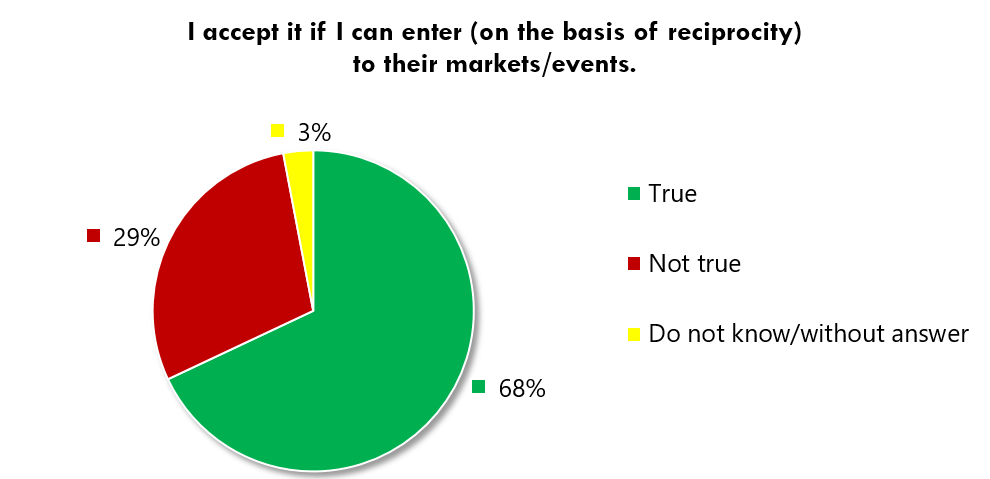
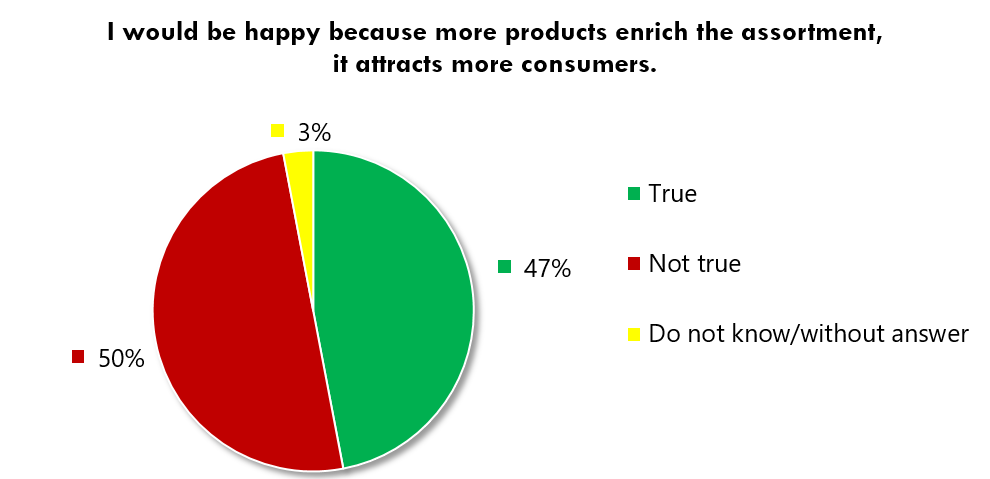
Contribution of the expert working group
The contribution of the expert working group to the final document proved to be extremely useful, namely the experts significantly influenced the formulation of the preparatory concept through the expertise of their professional specialization’s regulatory background.
- Topic of healthy food. The most powerful part of CESCI’s argumentation was the reference to the constitutional right to have an access to healthy food. Experts of the working group emphasised that recently there was an attempt by the Minister of Agriculture to define the concept of ‘healthy food’ by a working group – the attempt was unsuccessful. Nevertheless, if the concept of ‘healthy food’ was defined it would not result any concrete measures. Further problem is that the locally produced food is not guaranteed to be healthier as the food in stores.
Subsequently, the final document put the emphasis of the argumentation on the termination of territorial discrimination, on competitiveness of the rural areas, as well as on the environmental importance of short supply chains - Food safety. The greatest risk of the initiative is that control mechanism is unable to control whether the seller beyond the border sells its own product and whether the food hygiene conditions were fulfilled during the production. To assure the traceability of food could be implemented by a common database with the neighbouring countries, or to share the already existing database between each other – in a language that is understandable to each other.
Accordingly, the articulated proposals in the study, separately deal with the issues of food safety and with the aims to avoid risks. - The question of concurrency. The key aspect to define local products is that they reflect specialties of a particular region (local tradition, traditional raw materials and special producing processes). This regional uniqueness assures that the producers have demand for their products. However, if sellers with similar products arrive from areas beyond the border then this endangers the living of local traditions (see the disputes around the title “Tokaji”, or the problems around the origin protection of the chimney cake).
Therefore, the study addresses the question of mutuality with special emphasis, which appeared as one of the most important conclusion of the questionnaire research. - Administration of freight transport of goods. In the past few years, the rules on freight transport of goods became stricter in Hungary, especially with the aim to improve tax discipline and to fight against illegal trade in goods. Although, the administration of records has a rationality in case of large volumes. These records do not involve the small-scale sales of local producers, but the weight limit is low, hence it is easy to get under the scope (500 kg). Moreover, goods that arrive from the area beyond the border are obliged to report at the first place of their entry (the local producer market in this case). If this does not happen, then the market organizer bears the consequences. Furthermore, the foreign producer has an obligation to register a tax number and he does not have a possibility to receive tax exemption because he is outside of the Hungarian territory. Nevertheless, if the goods are taxed then the foreign small produces is in competitive disadvantage in comparison with the Hungarian producers and sellers, who have a legal possibility to have tax exemption until 8 million of goods turnover.
Although, the above mentioned problems are beyond the reach of the study. The legislative rules limit each other, hence if we relieve one legislative limitation, we find another one. The attempts of the Government to “whiten” the Hungarian economy have been successful and they have generated higher public tax revenue, thus it cannot be expected that such a successful legislative package will be amended because of small producers. However, the experts of the working group articulated some other alternative possibilities that were accepted by the authors of the study. - Pragmatic considerations. The working group proposed that there is a need to narrow down the focus of the study. With regard to the extremely complex harmonization structure with third countries, our research was limited to the neighbouring countries since the frames of the Union are already given in this case. The proposals should focus on the range of 40 km territorial area, thus the regulation on local production and producers does not have to be modified. Harmonisation of legislation should not be the aim of the study, since the five EU neighbours of Hungary have different legal frameworks for local producer markets, but the aim is the amendment of the Hungarian legislation which can serve the basis for negotiation processes with the neighbours.
It can be comprehensively stated that the expert working group criticized the original concept at numerous points, but this criticism supported the development of a more pragmatic proposal.
The main findings and suggestions of the study
The expert study can be divided into three major parts.
The authors sum up the theoretical frameworks of cross-border local product sales in the first part. They address the latest developments in the field of legal harmonization, the DG Regio Cross-Border Review project, as well as the statement of the Commission on the basis of the project and its expected consequences. The launched program on the EU level aims to remove the existing legal-administrative obstacles, the study also draws attention to other initiatives at the level of bigger region and at national level. Besides, it emphasizes the country-specific recommendation on the reduction of economic bureaucracy in the Hungarian Partnership Agreement.
The authors present the latest developments on local products in the EU policy and they draw attention to cross-border aspects. They mention several attempts, when the EU members took initiatives to make cross-border integration of local markets or to facilitate the possibilities of the small producers to sell their products beyond the borders. Although, these experiments have not achieved any spectacular success and most of them failed.
Finally, they underline the specificity of the Central European region, emphasizing that opening of the borders, structured in the 20th century and which were formerly impermeable, generate that old and organically related territorial ties reoccur and they create opportunity for development of economic cooperation.
The second part introduces the activities that were implemented within the frame of the subproject: results of CESCI project from 2016, the questionnaire process and the work of the working group (their description see above).
Finally, the third part includes the comprehensive legal analysis that deduces the need for a harmonization from the Union’s pillar of free movement of goods and services. From this point of view, the authors see the Directive 2006/123/EC on services in the internal market as the starting point. The Directive assesses that the provider who arrives from the area that is beyond the border (with exception of so called “regulated professions”, identified within the Directive) does not need any specific permission, or he does not have any separate obligation for registration: the provider can be obliged to obtain those permissions, as well as registration, which are obliged for the domestic provider, too. On the basis of the prohibition of discrimination, no specific restrictions could be imposed on a producer who arrives beyond the border.
“Member States may obstruct, limit the right to provide services on their own territory only on the basis of the principles of necessity and proportionality, namely they may describe only such – proportional – eligibility criteria that may be necessary due to public policy, public security, public health, the protection of the environment and the protection of the consumer” (ed. English translation by the authors) [2]
The problem is that selling of food beyond the borders always raise food hygiene question, thus the issue of public health risk – this is true even in a case of short supply chain, in our case it is a small volume sale to the end user.
The Member States of the European Union have to follow the Community law in the domain of food safety and food hygiene, where the issue of traceability is the most important aspect. As a rule of thumb, it is acceptable that those products whose production is in agreement with the relevant EU regulations are considered as safe and they can be placed on the market without restriction – theoretically, they can be introduced at the market also beyond the border. This measure requires that the producer registers himself in his own country, thus ensuring a control mechanism for the authorities. The EU Regulation (EC) No 853/2004[3] reflects the possibility of potential cross-border sales.
EU food law was incorporated into the Hungarian legislation by the Act XLVI of 2008 on the food chain and the official supervision. According to the law, safety of food is a responsible of the Hungarian distributor.
For the traceability of the liability system, the Hungarian small scale producer has to register himself that he is engaged in commercial activity. It is important to underline that this has to be done in Hungarian language and the registration number has to be indicated. However, the small producer beyond the border may not necessarily speak Hungarian language and his registration number is not compatible with the Hungarian system. These problems can be handled with small modifications (e.g. official blanks are accessible in the language of the neighbouring countries, as well as establishing of interoperability with the foreign registration databases).
At the same time, according to the Hungarian Commercial Law, only those local small-scale producers can sell on a local market who comply with the Hungarian law. In the case of producers from the EU Member States, the legislation allows the sale of goods if the producers comply with the Hungarian tax and accounting rules and if they fulfilled the required obligations for registration. That means that they have to apply for a Hungarian tax number, but this automatically includes the producer, because of his foreign establishment (“intra-community acquisition of goods”), within the tax system. The Hungarian producers can apply for a VAT exemption under 8 million HUF annual turnover, but this exemption is not available for the foreign producers. The Hungarian VAT rate is the highest in the EU (27%), then the foreign producers, even under the same conditions, can sell their products with 27% higher prices in Hungary than their economic competitors. Moreover, the inclusion in the VAT circle obligation entails much greater administrative burden. In the case of a foreign seller, the issuance of internal invoice is also mandatory – all this has to be done in Hungarian language.
Even bigger problem is generated by the regulations that aim to “whiten” the Hungarian economy:
- Decree No. 3/2010 (VII. 5.) of the Ministry of Rural Development on data reporting and traceability relating to food production and sale,
- Decree No. 82/2004 (V. 11.) of the Minister of Agriculture and Regional Development on inspection of fruit and vegetables,
- Decree No. 5/2015 (II. 27.) of the Minister of National Economy on the function of the Electronic Public Road Trade Control system,
- Decree No. 51/2014 (XII. 31.) of the Ministry for National Economy Defining Hazardous Goods in Relation to the operation of the Electronic Public Road Trade Control System.
According to the Decree No. 3/2010 (VII. 5.), notification obligation appears to the market organizer even in case of selling 2 bottles of foreign jams (in many cases the notification obligation has to happen 2-3 days in advance, namely to notify who will sold what kind of products in the market). In the case of goods that exceed 500 kg or they have a value above 1 million HUF, it is necessary to register the risky products (including food) in the Electronic Public Road Trade Control System. The consignee is obliged to register (it is the market organizer in our case).
It can be seen from the above described conditions that sale of foreign local products in Hungary includes such administrative burden which directly questions whether it is worth to legally bring small amounts of locally produced food or not. The contemporary legislation is more favourable for the illegal moves, because the volume of the sold food is negligible in comparison to the administrative burden. This argument was repeated several times at the debates of the working group.
Because of the above described difficulties, the authors of the study do not recommend amendment of the legislation. Instead, the following suggestions were formulated:
- “It is easier to sell goods deriving from other Member State if the concerned parties establish joint ventures in Hungary, or a Hungarian enterprise, organisation is involved within the sale. In this case, tax liability risk is minimal, clear and not complicated economic and financial conditions are present. Furthermore, the small producer beyond the border may choose the subject of tax exemption, the 8 million HUF annual revenues. In this case, the Hungarian site will be the recipient, but some disadvantages still remain, namely the company has to fulfil the storage and notification obligation on the basis of the Government Decree No. 3/2010 and if the transported goods reach the weight or value threshold, it is necessary to request a number in the Electronic Public Road Trade Control System.”[4]
- Issuing of a cross-border producer card could include the small producers from the area beyond the border within the Hungarian register and legislative rules, which are applied in the case of Hungarian small producers, hence the same possibilities could be given to them. Nevertheless, this step does not guarantee that the seller, who arrives from the area that is beyond the border, will sell his own products. Subsequently, the further task is to establish the interoperability of the registers between the neighbouring countries. Moreover, the authors consider that the concepts of local sales should be defined in the context of bilateral agreements – on the basis of common nomenclature. The Hungarian side would prefer the range of 40 km zone.
- There is a need to make amendments in the Act CLXIV of 2005 on Trade (2.§ 5a):
“A market, where a small-scale producer, or a producer who is registered in a bordering EU country, within a county on the basis of location of the market, or in a 40 km area from the market, or in the case of a market based in Budapest, producers, operating anywhere in the country, of agricultural and food products may sell their products.” (ed. English translation by the authors)
- The current restrictions can be circumvented in a way that the local producer markets are held at the same time on both sides of the border, hence the local consumers can access to the products at the same time and in one place. This procedure is especially recommended in those border regions, where the border is legally free to cross and the two markets can be easily formed in a way that crossing the border is not a physical difficulty.
- In order to achieve easier administration, it would be useful to make the blank forms available in the official languages of the neighbouring countries. The same structure would allow that the Hungarian administrator can understand the content of the data sheets that are filled on the other side of the border.
As it is visible, the study rather contains policy and practical advices and suggestions instead of legal ones. However, a half-year work cannot be regarded as unsuccessful, since every aspect of the given question was analysed with sufficient depth.
Footnotes
[1] Supporters are those respondents who expressed their opinion to the given question that they could accept the appearence of producers beyond the borders at domestic markets.
[2] Szabadkai Andrea – dr. Major Ágnes – Horváth János – CESCI (2017): Határon átnyúló helyitermék-értékesítés. Tanulmány és jogalkotói javaslatok, 36.
[3] Regulation (EC) No 853/2004 of the European Parliament and of the Council of 29 April 2004 laying down specific hygiene rules for on the hygiene of foodstuffs down specific hygiene rules for food of animal origin
[4] Szabadkai et alii: i.m. 55.
Fulfilment of the identified indicators of the subproject
- Local Products Working Group: 1 working group / 1 working group
- Number of invited experts into the Local Products Working Group: 10 persons / 15 persons
- Number of meetings of the Local Products Working Group: 4 meetings / 4 meetings
- A comprehensive policy and legal recommendation that helps the cross-border integration of small producers: 1 comprehensive policy and legal recommendation / 1 comprehensive policy and legal recommendation
Possibilities for continuing the subproject
On the basis of the formulated proposals and the identified difficulties, the following continuation option is feasible.
- It would be appropriate to examine the question of issuing small producer card within the framework of the Hungarian Chamber of Agriculture and to examine the conditions of its introduction.
- To initiate a harmonization of the registers of the neighbouring countries, as well as establishment of a common nomenclature.
- To make that official blanks, which are needed for registration and for the Hungarian selling activity, are accessible in the official language of the neighbouring countries.
- It would be useful to make a compilation of the relevant legislation of the Hungarian and the neighbouring countries and to compare them, as well as to formulate a certain guide for the case if someone wants to sell the products on the other side of the border.
- There is a need to draw the attention of to the EU legislators about the obstacles arising from national regulations. Although cross-border sales of local products do not represent a significant weight within the national economies of the countries, but on the overall European level it is added and it reaches a symbolic significance. It is not expected that the issue will have an EU level solution, but the European institutions may articulate recommendations for the member states and this might catalyse the Hungarian legislative process, too.
Meetings of the working group (local products)
An expert working group was set up in order to reveal the legal background and to formulate suggestions on the issue of cross-border trade of local products. The following experts were involved within the work of the working group, except the appointed experts and CESCI members (Dr. Norbert Jankai, Gyula Ocskay):
- Ágota Balázs, Referent, Ministry of Agriculture, General Department of Food Chain Management
- Ferenc Deák, Ministry of Agriculture, Deputy Head of General Department of Food Chain Management
- dr. Szabolcs Hancsók, Referent, Ministry of Agriculture, General Department of International and the Carpathian Basin Relations
- Annamária Jakab, Referent, Ministry of Agriculture, General Department of International and the Carpathian Basin Relations
- Katalin Kujáni, Research Manager, Discovery Research and Development Center
- Gergely Lantos, Head of General Department, Ministry of Agriculture, General Department of Agricultural Development and Rural Strategy
- dr. Matus László, Referent, Ministry of Agriculture, General Department of Agricultural Development and Rural Strategy
- Mihály Szalay, Rural Development and Advisory Directorate of the Hungarian Chamber of Agriculture
- Erika Székely, Director, Rural Development and Advisory Directorate of the Hungarian Chamber of Agriculture
- Edina Szomi, Referent, Rural Development and Advisory Directorate of the Hungarian Chamber of Agriculture
- dr. Márta Torda, Head of General Department, Ministry of Agriculture, General Department of International and the Carpathian Basin Relations
- Orsolya Tószegi, REL-Referent, Prime Ministers’ Office, Strategic Department of European Agricultural Fund for Rural Development
The working group had four meetings altogether: on 20th of June, 4th of July, 2nd of October and 28th of November.
1st meeting of the local products working group (20th of June, 2017)
Gyula Ocskay welcomed the participants on behalf of CESCI and he thanked for accepting the invitation. He briefly introduced the Association, then he gave an overview of the project with title Legal Accessibility, implemented last year, and about its results on cross-border trade of local products.
On the basis of the background material, which was posted in advance, Márta Torda, Head of General Department, indicated that they would like to cooperate in discussion of the issue with CESCI. On the one side, she offered that the meetings could be held in the building of the Ministry of Agriculture, on the other side she promised a help that the relevant general departments of the Ministry will also represent themselves at the meetings. She also proposed a list of additional invitees, like the experts of NÉBIH (in English: The National Food Chain Safety Office), Prime Ministers’ Office, and the Hungarian Chamber of Agriculture. She promised contacts, too.
Gyula Ocskay thanked for the offered help and he briefly introduced the project schedules and indicators of the Legal Accessibility project in 2017. He mentioned that three experts were invited to offer a tender for legal advice.
The participants agreed that the next meeting of the extended working group will be held on 4th of July in the building of the Ministry.
The following participants were present:
- dr. Szabolcs Hancsók, Ministry of Agriculture
- dr. Norbert Jankai, CESCI
- Gyula Ocskay, CESCI
- dr. Márta Torda, Ministry of Agriculture
2nd meeting of the local products working group (4th of July, 2017)
Szabolcs Hancsók welcomed the participants at the beginning of the meeting, then Gyula Ocskay introduced the Legal Accessibility project, whose aim is to propose legal and policy recommendations in order to reduce the dividing effects of the borders, thus improving the living conditions of people who live in border areas. As it was mentioned at the meeting, several attempts have been made in order to address the problem of cross-border trade of local products, but the attempts were unsuccessful, so far.
Subsequently, the following topics were discussed by the participants:
I. Discussed topics at the meeting
Regulating environment: the problem is that most of the countries have different legislative regulation of (small-scale) producers. The definition itself is also different in most of the countries, hence it is appropriate to avoid using the term ‘small-scale producer’, rather the focus should be taken on ‘selling to a direct end user’. For example, it is known that the Slovak legislation is much stricter than the Hungarian one. The regulative environment differs from country to country and this makes the harmonization harder, i.e. there is a need to find the way of harmonization with at least 5 EU neighbouring member states. The easiest way would be to make a legislation on the EU level. At the same time, a training system, Better Food, exists in the EU, and the Flexibility training showed that there are different ideas for small-scale producers in each country.
Regulatory flexibility: the basis for applying the principle is the local tradition, traditional raw materials and the existence of special producing processes and their respect (small scale sales!). Transport of local food across borders questions this principle. Selling of local products is also based on customer trust. Although, this is not denied by the cross-border sale.
Food safety: the risk is embodied by the track of the food which comes from the area beyond the border is unable to control. It is not possible to exactly know whether the product was produced by the selling person or not. The Slovak produces are registered and controlled by the domestic authorities. There is no possibility to register the foreign producer in the Hungarian register. There would be a need to have an access to each other’s database. There is a need to ascertain whether the given producer is entitled to sell his products and whether the given product is not harmful to health (traceability).
Healthy food: following the request of the Minister, a working group has been recently established for this topic. However, the group has failed to define what can be considered to healthy food. Consequently, it is not appropriate to refer on this; although, the Constitution contains the right to have access to healthy foods. The reference is weakened by the fact that the article XX mentions the basic rights, but concrete measures cannot be deduced from it. The use of the term also requires caution in the sense that healthy food cannot be produced only by a small-scale producer.
Territoriality / extra territoriality: administrative barrier of the border creates discrimination – as every national legislation do. Nevertheless, the Constitution of Hungary and other laws (e.g. law on citizenship) apply extraterritorial provisions. The possible solution cannot include any national discrimination, but the Hungarian citizenship cannot be a criterion either. The regulation of the local producer market should be amended, and the Ministry of National Economy will address it, too.
Concurrency: appearance of sellers from the area beyond the border represent a concurrency for the domestic producers. It is a fact that many small-scale local markets have developed in recent years. Many of them have few vendors and expansion of the potential vendors may improve the situation. At the same time, the unilateral amendment of the Hungarian legislation, without accepting mutuality, could generate disadvantage for the Hungarian producers. Important aspect is the question of regularity and quantity of selling – especially, for the protection of the Hungarian producers. An example of foreign selling exists, e.g. somebody from the Board Member of the Kislépték (in English: National Association of Interest Representations for Small-scale producers and service providers) sells products in Austria. If selling activity takes place, it has to be done with the same conditions as the Hungarian producers do it.
II. Suggestions for further continuation
- Do not include the non-EU neighbour countries.
- In parallel with the legal analysis, a questionnaire survey should be implemented among the domestic producers and consumers on the question, how would they relate to the proposed derogation. (Kislépték and CESCI make a joint proposal for the questionnaire, but everyone can comment it).
- We should not focus on legal harmonization, but we should try to modify the Hungarian regulation, hence approaching toward the least resistance. In order to ensure mutuality, the Hungarian proposal may be the starting point for negotiations with the neighbouring countries.
- The proposal should be applied only to cross-border sales in Hungary, thus the approval is linked to km distance that may reduce competition. There is no need to modify the smalls-scale producer regulation.
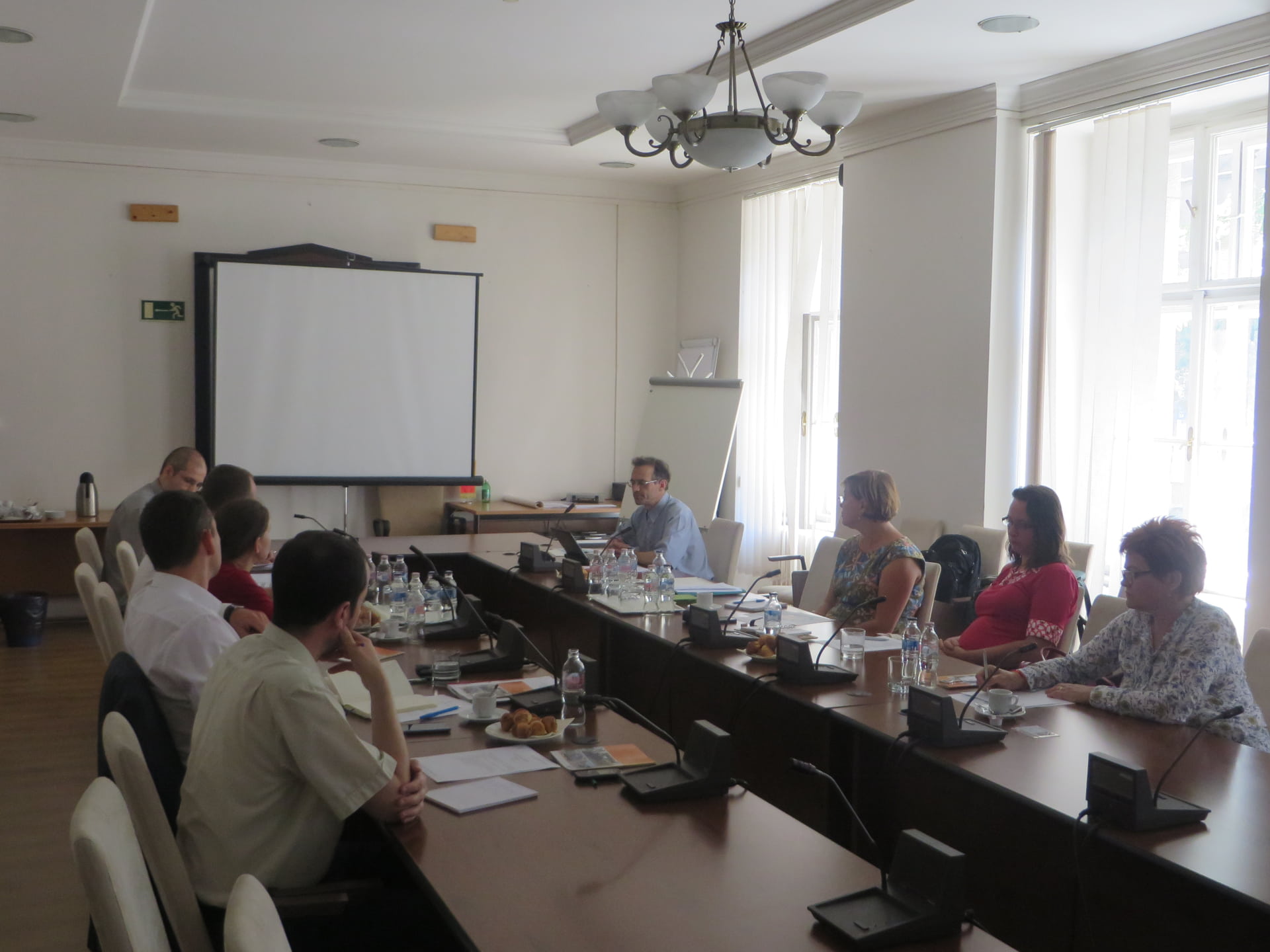 |
 |
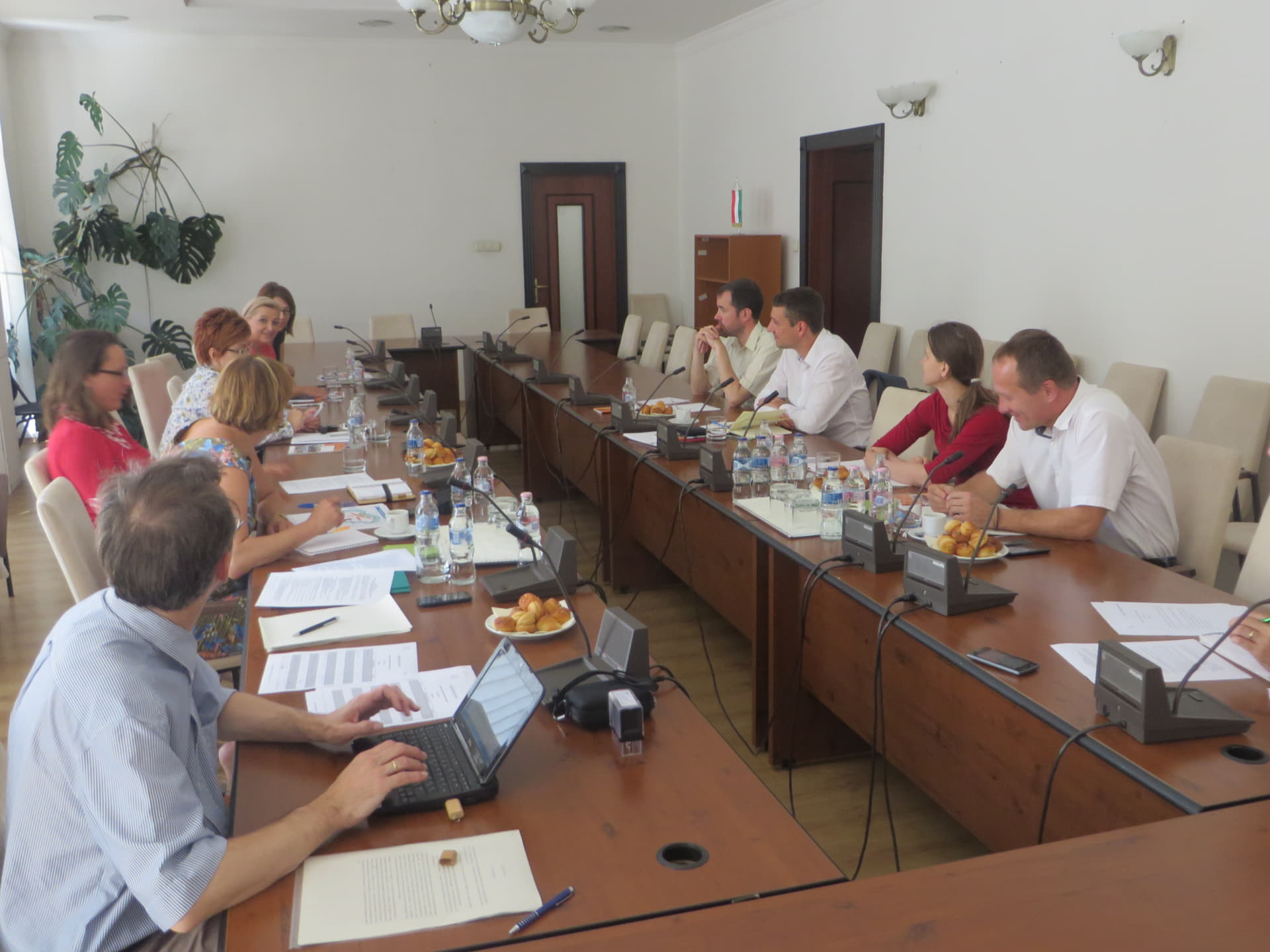 |
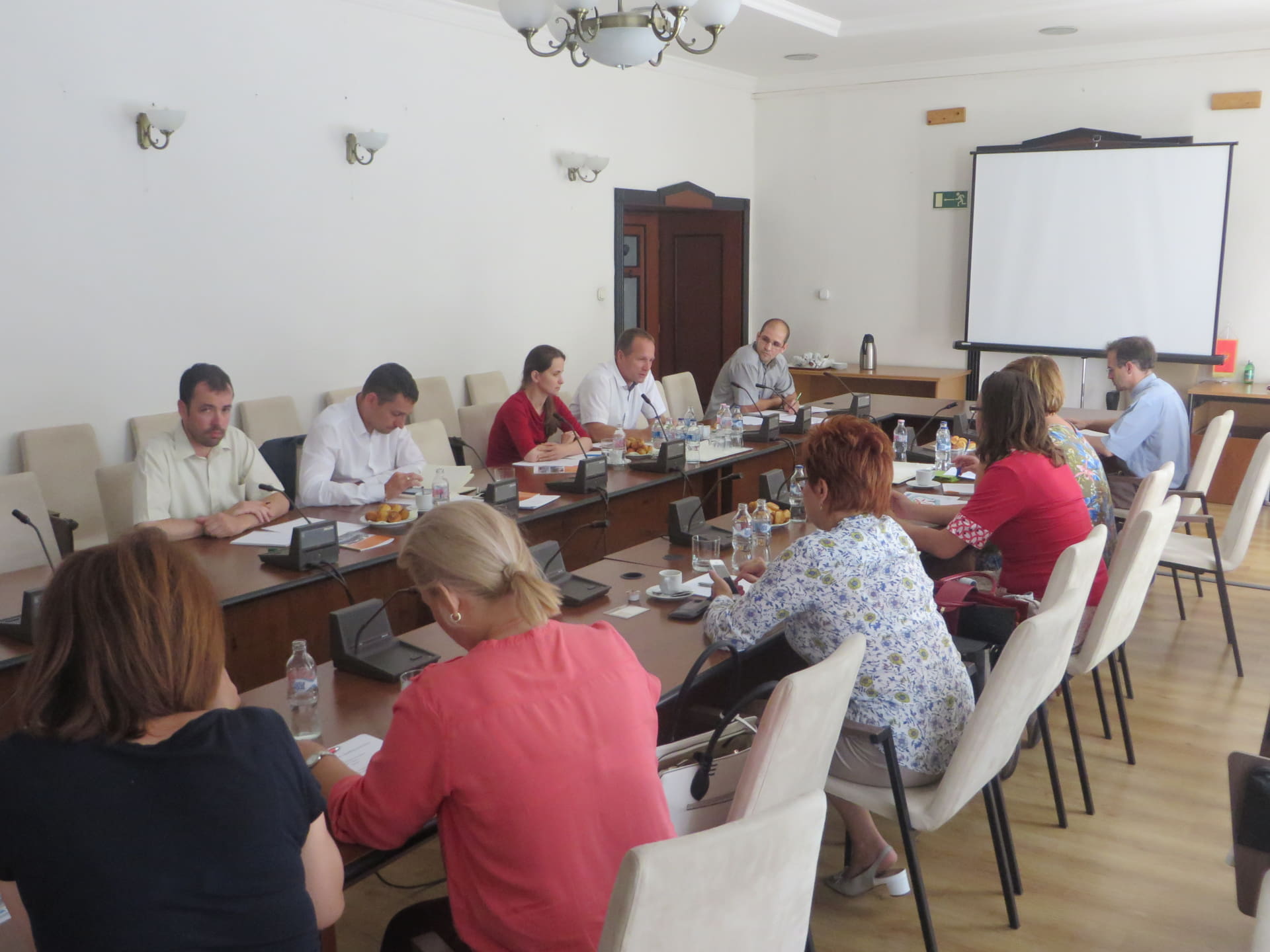 |
The following participants were present:
- dr. Ágota Balázs, Ministry of Agriculture
- Ferenc Deák, Ministry of Agriculture
- dr. Szabolcs Hancsók, Ministry of Agriculture
- dr. Norbert Jankai, CESCI
- Szilvia Kovács, Első Magyar Kert Szövetkezet (EMKSZ) and Kislépték
- Gergely Lantos, Ministry of Agriculture
- dr. Ágnes Major, lawyer
- dr. László Matus, Ministry of Agriculture
- Gyula Ocskay, CESCI
- Andrea Szabadkai, Kislépték
- Erika Székely, Hungarian Chamber of Agriculture
- Edina Szomi, Hungarian Chamber of Agriculture
3rd meeting of the local products working group (2nd of October, 2017)
Szabolcs Hancsók welcomed the participants at the beginning of the meeting on behalf of the Ministry of Agriculture, which assured space for the meeting, and he apologised that he had to leave the meeting. Then, Gyula Ocskay presented the prepared study, as well as the results of the questionnaire.
Comments on the results of the study
GENERAL NOTIONS
Each Member State has the power to determine the content of the “local and marginal” production. Food hygiene rules are equally binding for everyone, there is no difference here, but the conditions of local producer are fully based on local traditions. This will result that the process of harmonisation will be very hard with the neighbouring countries, because separate agreements will be needed with each government.
The same conditions need to be provided for the Hungarian small-scale producers in the areas beyond the border. However, production costs are not the same on both sides of the border. How can it be ensured that the Hungarian small-scale producers are not in disadvantaged position?
It is important that the analysis should not generate any impressions that we do not comply the EU rules.
Modification of the regulation on small-scale producers is not among the plans. Authors of the study propose the amendments of the local market regulation.
CONCRETE NOTIONS
Significance of the modifications: there are no problems with small-scale producers in the case of the registered enterprises. Does the cross-border trade of local products have such economic importance which is worth to undertake a complicate amendment in legislation?
Difficulties of controlling: it is impossible to compare the small quantity across the border with the quantity that is sold in Hungary, because the databases are not linked, and controls should be done on both sides. Thus, there is a risk of dumping.
FELIR-identification: selling activity can be done only by FELIR-identification. Food controlling are carried out on this basis of this, but fighting against the black economy is also an important aspect of it. Subsequently, modification of the relevant rules would not be beneficial for this reason.
Obligation of notification: food that is imported to Hungary has to be reported on the basis of its first storage place. In this case the first storage place is the market. The market organizer is responsible for reporting, the NÉBIH will penalize him, too.
Supplier’s identity: the small-scale producer cannot operate a web-shop (mail order trade), it is prohibited by law. Transport is a task that has to be made by the buyer. The small-scale producer may advertise himself in order to attract the consumers. This seems to be simpler, since there is no need to make amendments in the law: the buyer transports the good across the border – at his own risk – instead of the producer.
Question of direct supply: only the cooperation itself may be the seller and it cannot sell the goods further, because the Regulation no. 852 applies only to direct sales.
Definition difficulties: in the case of compound foods, there are also differences in the definition of ingredients between each country.
SOLUTION PROPOSALS
- Regulation no. 2/2010 could be amended with facilitation: the option to sell only low quantity; the seller from the areas beyond the border has to register himself on-line; or he may have Hungarian card of small-scale producers. The chip card system which is under development by the Hungarian Chamber of Agriculture could be an appropriate solution and it could be controlled even by a telephone.
- The Hungarian Chamber of Agriculture connects markets and farmers in a digital system. They register the producers, productions (possibly the volume, too). This system could be extended to the producers beyond the border.
- Regulation on local producer market could be amended in a way that the “small-scale” producer, under the rules that are applied there, could sell on the Hungarian side.
- The Union regulates the electronic trade which will overwrite everything and it is likely to solve also the problems that were raised by the study.
At the request of the participants, CESCI undertook that the study will be available for everybody in ‘word’ format. Deadline for submitting of the comments was 10th of November.
Comments on the questionnaire
Contradictory results have emerged: responses of the producers of two questions that concerned the exclusion of competition did not produce the same result. Did they understand the questions?
The number of responses is very low (probably due to the summer announcement), so there is no possibility to draw a real picture about the opinions of the consumers and producers. The Hungarian Chamber of Agriculture offered that they will restart the questionnaire through their county offices. They asked us to allow the option that the questionnaires can be filled in paper-form, because this is the simplest solution for many small-scale producers. The participants agreed that time frame for the questionnaire survey is extended until 10th of November. For this, CESCI reopens its on-line interface and the link is shared within its network. CESCI undertook the task to process the questionnaires that were filled by hand.
Participants of the group will be informed about the results at the meeting in November.
The following participants were present:
- Ferenc Deák, Ministry of Agriculture
- Dr. Szabolcs Hancsók, Ministry of Agriculture
- János Horváth, Kislépték
- Annamária Jakab, Ministry of Agriculture
- Dr. Norbert Jankai, CESCI
- Katalin Kujáni, Discovery Research Agency
- Gergely Lantos, Ministry of Agriculture
- Dr. Ágnes Major, lawyer
- Gyula Ocskay, CESCI
- Andrea Szabadkai, Kislépték
- Mihály Szalai, Hungarian Chamber of Agriculture
- Erika Székely, Hungarian Chamber of Agriculture
- Edina Szomi, Hungarian Chamber of Agriculture
- Orsolya Tószegi, Prime Minister’s Office
Documents relating to the meeting of the working group can be downloaded:
4th meeting of the local products working group (28th of November, 2017)
Szabolcs Hancsók welcomed the participants at the beginning of the meeting on behalf of the Ministry of Agriculture that assured space for the meeting, then Gyula Ocskay presented the results of the extended questionnaire survey. He expressed in his introduction that they accepted the filled questionnaires until 20th of November; subsequently, they finished the digitalization, and a presentation was prepared from the results of the questionnaire survey.
In comparison with the previous measurement, the extension resulted in processing of 452 consumers’ questionnaires and 341 producers’ questionnaires which is an appropriate number in order to make realistic deductions. He underlined that the final results do not significantly differ from the results of the previous limited questionnaire survey: the vast majority of the respondents is ready to accept that small-scale producers, from the areas beyond the border, might sell their products in Hungarian markets with certain conditions (especially on the basis of mutuality).
Neither question nor comments were received in relation to the questionnaire survey.
Subsequently, the topic was the study itself and only two comments were articulated. CESCI inbuilt the comments into the document – with certain analytical section. The study was published in the end of the year 2017 and it was published on the webpage of CESCI. From the notions of the conclusion of the analysis, it was emphasized that legislative changes were not initiated, because solution of the identified problems would be disproportionately hard task in comparison with the volume of the trade. Instead, the study will propose some alternative solutions.
At the end of the meeting, Gyula Ocskay thanked the joint work of participants of the working group.
The following participants were present:
- Ferenc Deák, Ministry of Agriculture
- dr. Szabolcs Hancsók, Ministry of Agriculture
- Gergely Lantos, Ministry of Agriculture
- dr. Ágnes Major, lawyer
- Gyula Ocskay, CESCI
- Mihály Szalai, Hungarian Chamber of Agriculture
Document relating to the meeting of the working group can be downloaded:
4. Evaluation and development of information systems
One of the main conclusion of the project from 2016 was that in the most cases the biggest obstacle of cooperation is the nonsufficient information of people who live in border regions. We saw in numerous cases that the mentioned problems, articulated by the stakeholders, actually did not exist. In other cases, insufficient information led to problems that hard to solve. Consequently, we consider that there should be a progress also in the domain of information.
Content of the project element:
- comprehensive examination and analysis of the existing EU, national and regional border area information;
- drawing up of a proposal in order to eliminate information gaps through integration of internet available information.
Results / Information systems (2nd milestone)
The study (Information systems) prepared in the frames of this subproject can be downloaded by clicking on the picture below (in Hungarian).
Results of the subproject were summarized in the following points. Click on the text for details.
Objective of the subproject
One of the main conclusions of the 2016 Legal Accessibility project was that in most cases insufficiency of information generates the biggest obstacle of cooperation for people living in border areas. Therefore, the first horizontal proposal of the project aims to improve information mechanisms.
Within the project in 2017, the objective of the subproject, “supporting the creation of a legal information background in order to help the everyday life of border areas”, was to review, to analyse the electronic information systems that are related to everyday cross-border life situations, and to evaluate the contemporary solutions; to articulate proposal on the basis of identified information in order to terminate the shortage within the domain of information.
The authors wanted to achieve the followings:
- to identify the main formal options of receiving information for the participants in cross-border mobility,
- to see the condition of the information systems on systematic level,
- to identify those life situation, where information gaps are relevant,
- begin to prepare the development of information opportunities for the participants in cross-border mobility.
On the one hand, the subproject fulfilled its objectives, namely it reviewed the main official information opportunities and it articulated development opportunities. At the same time, it became clear that huge number of various official online platforms were established across Europe which mainly, or with multiple purposes, aimed to inform the citizens on various levels. To find and identify these online platforms are mainly depend on fortune (do the citizens find the appropriate platform). Subsequently, this pattern embodies a risk that the prepared study could not fully review the information systems. On the other hand, it significantly complicates the orientation practice for cross-border mobility participants. At the same time, integration of information sources has been already started at the EU level which is expected to establish an integrated digital client service around 2025.
Presentation of the activities that were implemented within the frame of the subproject
The main activity within the frame of the subproject was the compilation of a study. In this study, CESCI staff analysed the Internet appearance of information which related to everyday life situations in the domain of cross-border mobility, and they made suggestions on the basis of the analysis. During the preparation of the study, various research, questionnaire, analysis, evaluation and negotiation activities were implemented.
The main findings and suggestions of the study
The study, which was prepared within the frame of the subproject, can be divided into three major parts.
In the first part, CESCI staff analysed the conditions of internet information. Actuality and relevance of the subproject is justified by the growing tendency of cross-border mobility which has generated new demands for information by the citizens. In many cases, non-locally-based information requirements can be provided by e-information within the context of e-governance. Creation and diffusion of e-governance were substantially supported by the information boom that happened in the past decades and by dramatic change of the sources of information. The study briefly reviews all three topics.

Analysis of the situation continued with an overview of the regulatory environment which included Hungarian strategic documents and legislations, besides the most important European Union strategic documents. It can be claimed on the basis of the analysis of the regulatory environment that the decision-makers clearly aim to create a user-friendly e-governance. The members of the European Union have their own strategies for developing their e-governance practices; although, the EU eGovernment Action Plan 2016-2020 contains common elements. One of these principles is the following, “enabling cross-border mobility with interoperable digital public services”. The study, prepared within the frame of the subproject, reached almost the same result as the findings of the action plan:
“Currently Single Market-related information, advice, problem-solving mechanisms, contact points and procedures do not operate as a whole but are dispersed, incomplete, not sufficiently inter-connected and not consistently user-friendly – both at EU and national level. It is therefore difficult for users to find the right information and assistance required.” [EU eGovernment Action Plan 2016-2020]
The study continued with the review of existing evaluation systems. The review starts from the conclusion that the rise of the e-governance systems went hand in hand with the self-evident need to quantify, as well as to prioritize the results. After a brief methodological introduction, four international benchmark methodologies were reviewed, with special reference to the results of Hungary. The following conclusions can be deduced for Hungary from the summary of the benchmark results:
- Hungary performs poorly in the domain of e-democracy;
- in contrast, the government outstandingly performs well in handling and resolving cross-border issues;
- cross-border information supply in Hungary is somewhat below the EU average, nevertheless, in comparison with the neighbouring countries – excepting Austria – our lagging is not serious in spite of our linguistic isolation; however, there could be and should be improvement in many ways in this area;
- in the process of creating Single Digital Gateway, lag of Hungary is not significant in comparison with the EU average; although, the situation in the sphere of information services that directly help cross-border cooperation (the aspect for which the present study was also prepared) is far worse than in the case of the neighbouring Union countries and occasionally in non-EU countries.
After investigating the regulatory environment, the existing information systems were analysed. Altogether, we analysed 16 information platforms within the study. The narrowly-focused sectoral portals were not subjects of our study. At the same time, the study deals with the official online law directory of the European Union and Hungary. Besides the European Union and domestic platforms, we also reviewed those pages that specifically aim to inform the participants who are involved within cross-border mobility, and they can be only partly identified as EU or national initiatives.

In the second part, based on the experience that was gained during the tasks of the first part, the authors evaluated the existing electronic information systems by two methods. It was common in the two evaluations that both of the methods approached the quality of information from the life situations that are relevant to cross-border mobility. The first (external) evaluation applied the so called mystery shopping. The second (internal) evaluation involved staff of the Ministry of Interior and it surveyed the official Hungarian platforms of general information. Implementation of the internal evaluation, next to the external one, was considered as important by the authors. On the basis of the learned lessons, the authors thought if the information seeker cannot find any information, it does not automatically mean that information is not formally included within the information system. Joint use of both evaluation methods allowed us to explore the language availability of specific life situation and information.
The external method of mystery shopping provides an overview about a citizen of a neighbouring country, whether he wants to engage in certain life situations in Hungary (e.g. participate in the education process, renting a flat), and the level and depth of electronic information that is available about a particular life situation in his own language. The external evaluation was implemented in the following steps:
- Task of external evaluation started by the development of the mystery shopping method. Within this frame, life situations were identified on the basis of the relating literature, on the other hand life situations were identified on the basis of the experiences of the first legal accessibility project. Steps of the mystery shopping were laid down in this phase.
- Identification of circles of mystery shopping, contacting the mystery buyers. Basis of the methodology was to search the Hungarian content from abroad. That means searches were implemented in the official language of the neighbouring countries (e.g. in Romanian or in Slovak language), as well as in the foreign language that is the most spoken and used in the region, namely in English language. Thus, implementation of the mystery shopping needed users, who use the given languages as native speakers.
- Implementation of the mystery shopping composed of the following nine linguistic domains:
- raw translation of specific life situations into the language of the search,
- entering the raw search phrase(s) into Google[1], running the search,
- clarification of search phrase(s) in case of need,
- the qualitative assessment of the “strongest” result relating to the particular life situation, whereby the following values can be given according to the page, where the relevant information on the life situation can be found in the search language:
- A = official Hungarian site
- B = official site of another country
- C = official EU site
- D = nonofficial site
- Z = the search did not resulted in any meaningful finding
- Summarization and evaluation of the results of the mystery shopping.
The main findings of the external mystery shopping were the following ones:
- based on the lessons learned from the mystery shopping, it can be expressed that most of the official information on individual life situations is available in Hungarian language;
- through internet search, official Hungarian information in English language can be found for half of the analysed life situations;
- information on official Hungarian sites in the languages of the neighbouring countries is very limited;
- on the basis of experience, the role of official information platforms is also significant in the neighbouring countries, information published by the embassies in some cases;
- in case of the EU Member States, the various EU official information platforms have important complementary role;
- there is no relevant information for third of the identified life situations in Slovenian, in Slovakian and in Romanian language, and for a quarter of life situations in Serbian language.

The internal evaluation, implemented by the operators[2], gives information about official Hungarian information platform, namely what kind of information, relating to specific life situations, can be found and language availability of information. The internal evaluation was carried out in the following steps:
- The internal evaluation started with the development of the methodology. Within the frame of this development, those life situations were identified that should be examined. On the one hand, life situations were identified on the basis of the relating literature, on the other hand they were identified on the basis of the experiences which were gained during the first legal accessibility project. Criteria of the evaluation were also laid down in this phase.
- Establishing of contacts with professional evaluators. During the consultation with professional evaluators, we decided to carry out the evaluation. CESCI submitted to the experts the preliminary list of platform for which it requested to implement internal evaluation. The list of platform, which became the object of analysis, was slightly modified by the experts.
- Internal evaluation of five platforms (1818 Governmental Hotline, Your Europe, magyarorszag.hu, SZÜF, EUGO Hungary) was implemented through the following steps:
- To identify the feature of available information on the given life situation within a given platform:
- 1: no information
- 2: the person concerned is further forwarded to the website of the competent institution
- 3: the person concerned is further forwarded to the administrator of the competent institution
- 4: the platform offers rarely updated information
- 5: the platform offers a regularly updated information
- 6: immediate answer (telephone, e-mail) is given to the interested
- 7: they give feedback to the interested party within the foreseeable time (calling back, email the person concerned).
- To identify the language features of available information on the given life situation within a given platform
- A: in Hungarian language
- B: in English language
- C: in other language
- D: in all the official languages of the European Union
- Summary, valuation of the internal evaluation results.
- To identify the feature of available information on the given life situation within a given platform:
The most important conclusions of the internal evaluation:
- a substantial lack of information can be identified in case of every five life situations; there is little available information in the case of individual life situations within the analysed platforms[3]: rental contract, tuition for public education, nursery and kindergarten fees, purchase of real estate, tolling system, foreign car license, recognition of foreign qualifications received abroad;
- in case of numerous life situation, there is no information in any language on any level: purchase of real estate, tolling system, foreign license of car, recognition of professional qualifications received abroad, voluntary activity required for graduation in Hungary, rental contract, tuition for public education, kindergarten and nursery fees;
- English information about life situation is only a few;
- multilingualism is represented with low volume, content is mainly available only in Hungarian language; a substantive exception is represented by the 1818 Governmental Hotline and Your Europe;
- information levels that are provided by each platform are heterogeneous, uncoordinated;
- information content and information roles are split between various portals.
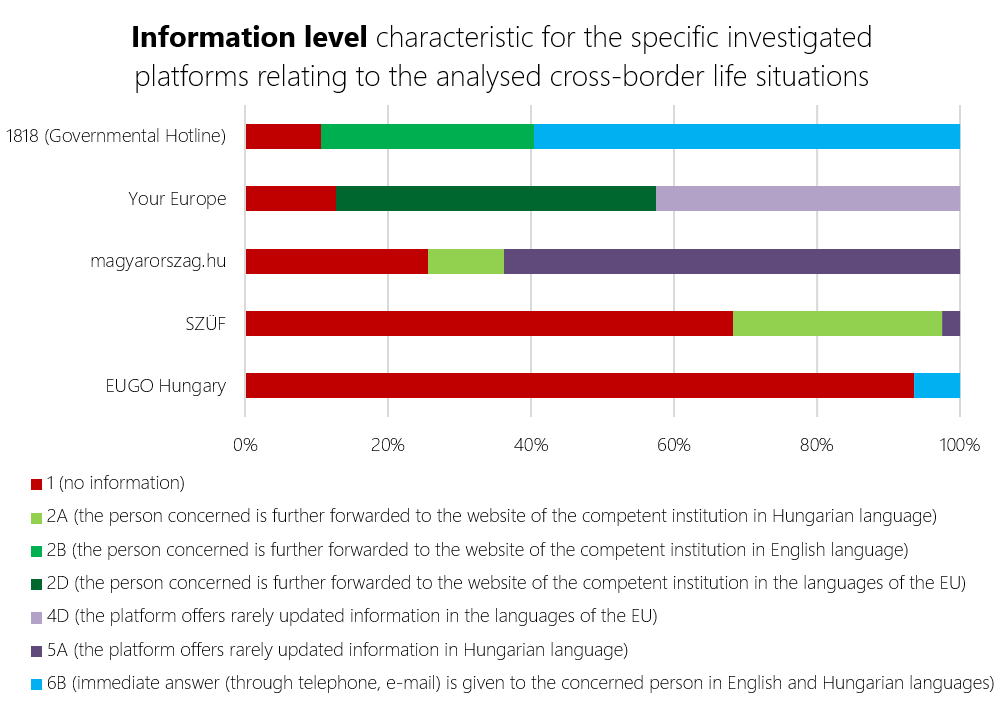
In the third part, the authors made proposals within the following themes with the aim to overcome the lack of information (detailed description of the proposals see in the “Summary of subproject results”):
- definition of the ideal cross-border information platform,
- better communication of the existing information services,
- support of the appropriate content,
- filling the information gaps that were identified on the basis of evaluations,
- cooperation with the embassies of the neighbouring countries,
- developing of a Personalized Administrative Structure.
[1] In 2017, market share of Google Search exceeded 90% in Europe. Source: http://gs.statcounter.com/search-engine-market-share/all/europe/2016
[2] The possibility of internal evaluation was identified by a consultation with the competent employees of the Deputy Secretary of State for Informatics of the Ministry of Interior, as well as with the employees of the National Infocommunications Service Company.
[3] According to the external evaluation, official information regarding toll system is also available in more languages on other platforms.
Summary of the subproject results
The most important result of the subproject was that it empirically revealed that what kind of online information gaps make difficulties in the domain of informing those participants who are involved within cross-border mobility around Hungary. The most serious obstacles, challenges were identified on the basis of evaluation and potential answers and proposals were identified, too. The relationship between the revealed challenges and proposals is summarized in the following figure by the authors:

The first group of challenges (marked with claret colour) requires the improvement, strengthening and development of content in different ways. Challenges grouped within the second groups (marked with blue colour) require methodological and practical development. It can be seen from the figure that each proposal can handle multiple challenges at one time, and solution of an obstacle can be brought by different proposals.
For example, proposals may contribute to the solution of the challenge related to major information shortage in the following ways:
- Identification of an ideal cross-border information platform: within the frame of the proposals, those life situations were identified which have relevant role from the viewpoint of cross-border mobility and which need development of information content.
- Better communication of the existing information services: this proposal has only an indirect effect in resolving this obstacle. The main question of the challenge is whether the user can find available information or not.
- Support of the appropriate content delivery: compilation of the necessary information material for life situations, identified under the first proposal, would require support for content provision. One of the main problems of the existing systems is the lack of resources. It is increasingly difficult to imagine the flow of necessary information, regular data and information change within the system without the needed dedicated staff.
- Complementing of missing information gaps on the basis of the evaluations: information materials are already available for some life situations that were identified within the frame of the first proposal. However, there is still large number of life situations without official information (or they are not available). Starting the improvement of the information material is recommended by these life situations.
- Cooperation with the embassies of the neighbouring states of Hungary: within the frame of the third proposal, there is a need to support the compilation of information materials and regular actualization of information relating to life situations, which were identified within the frame of the first proposal, by different resources. Within the framework of this fifth point, linguistic versions of the information materials could be prepared in cooperation with the embassies of the neighbouring countries. In addition, content could be easily accessible to the citizens of the neighbouring countries.
- Development of the Personalized Administrative Structure (SZÜF): the general structure of the planned content of the e-administration structure, which is expected to be launched in 2018, would be worth to complement that given information concern what kind of citizens and that information for the non-Hungarian citizens is available on which platforms. Contents of the 1st, 3rd and 5th point would be useful to integrate into the page, too.
As it is visible, individual proposals are useful on their own; however, their best influence can be achieved and expressed through their synergy. Similar logical chains can be formulated in the domains of other challenges, too.
Fulfilment of the identified indicators of the subproject
- Analysis and proposal relating to internet appearance of legal information in the domain of different life situations: 1 analysis and proposal / 1 analysis and proposal
Possibilities for continuing the subproject
On the basis of the articulated proposals and the identified difficulties, the following continuation option is conceivable.
- To conduct a similar internal assessment which was carried out in the domain of general information platforms in the framework of the project, for the sectoral information / administration websites.
- To launch a marketing campaign in order to familiarize the existing information systems.
- To establish a working group for supporting appropriate information content.
- To initiate cooperation in order to create joint information solutions with the embassies of the neighbouring states.
- Putting together concrete proposals for the planned content with minimum completion of the new e-administration structure, which is expected to be launched in 2018.
Completion of indicators (Second milestone)
Harmonization of EGTC-legislation
- Analysis of the Serbian EGTC legal environment: 1 analysis / 1 analysis
- International conference on EGTC (Serbia): 1 conference / 1 conference
- Number of participants at the EGTC conference: 60 persons / 144 persons
- Legislative proposal: 1 proposal / 1 proposal
Healthcare integration
- Ad-hoc health care working group: 1 working group / 1 working group
- Number of meetings of the health care working group: 4 meetings / 4 meetings
- Number of invited experts into the ad-hoc working group: 10 persons / 12 persons
- A regulatory and policy document on cross-border transport of patient: 1 regulatory and policy document / 1 regulatory and policy document
Local products
- Local Products Working Group: 1 working group / 1 working group
- Number of invited experts into the Local Products Working Group: 10 persons / 15 persons
- Number of meetings of the Local Products Working Group: 4 meetings / 4 meetings
- A comprehensive policy and legal recommendation that helps the cross-border integration of small producers: 1 comprehensive policy and legal recommendation / 1 comprehensive policy and legal recommendation
Information systems
- Analysis and proposal relating to internet appearance of legal information in the domain of different life situations: 1 analysis and proposal / 1 analysis and proposal
Concerning the whole project
- Final report: 1 pc / 1 pc
Recent documents (Second milestone)
The following documents were prepared within the framework of the second ‘Legal Accessibility’ project. You can download each document by clicking on its cover.
Harmonization of EGTC-legislation (in English)
Healthcare integration (in Hungarian)
Local products, short supply chains (in Hungarian)
Evaluation and development of information systems (in Hungarian)

The project was funded by the Ministry of Justice.
The project documents and the conclusions and recommendations contained therein do not necessarily reflect the official position of the Promoter.
In 2018, we continued the work in three fields:
The implementation of the third milestone of the Legal accessibility initiative took place in 2018. The aim of the project is to take the results of the previous initiatives forward based on the knowledge gained during the two former projects and the EU experiences.
The activities concern three main topics. On the one hand, we would like to complement the results of the Hungarian research concerning the cross-border movement of ambulances, with the exploration of the policy environment of the neighbouring countries. On the other hand, we will duplicate the researches of a study, developed in 2002-2003 in the light of the EU regulatory environment that has changed significantly in the meantime. The study analyses the conditions of the regional cross-border integrated patient care along the Hungarian borders, based on Western European good practices.
The third topic of the project is the summary of the experiences of the Hungarian EGTCs as part of the regulatory process related to the new EU budget cycle (2021-2027). With the study that processes the above mentioned, we would like to contribute to the review of the relevant EU EGTC regulation.
Go to the introduction of the fulfilment of the indicators.
The final report of the third milestone can be downloaded in Hungarian and English by clicking on its cover:
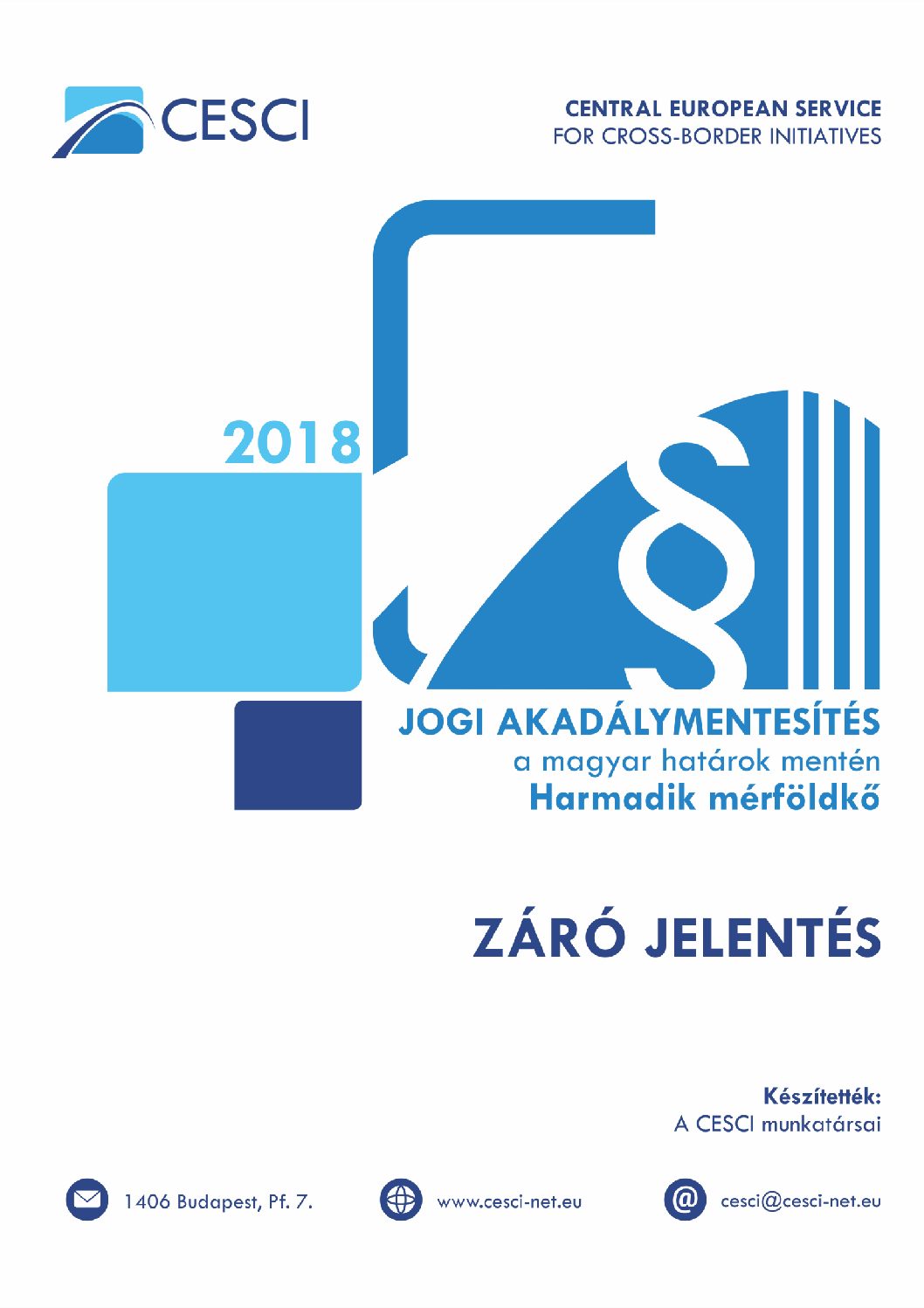 |
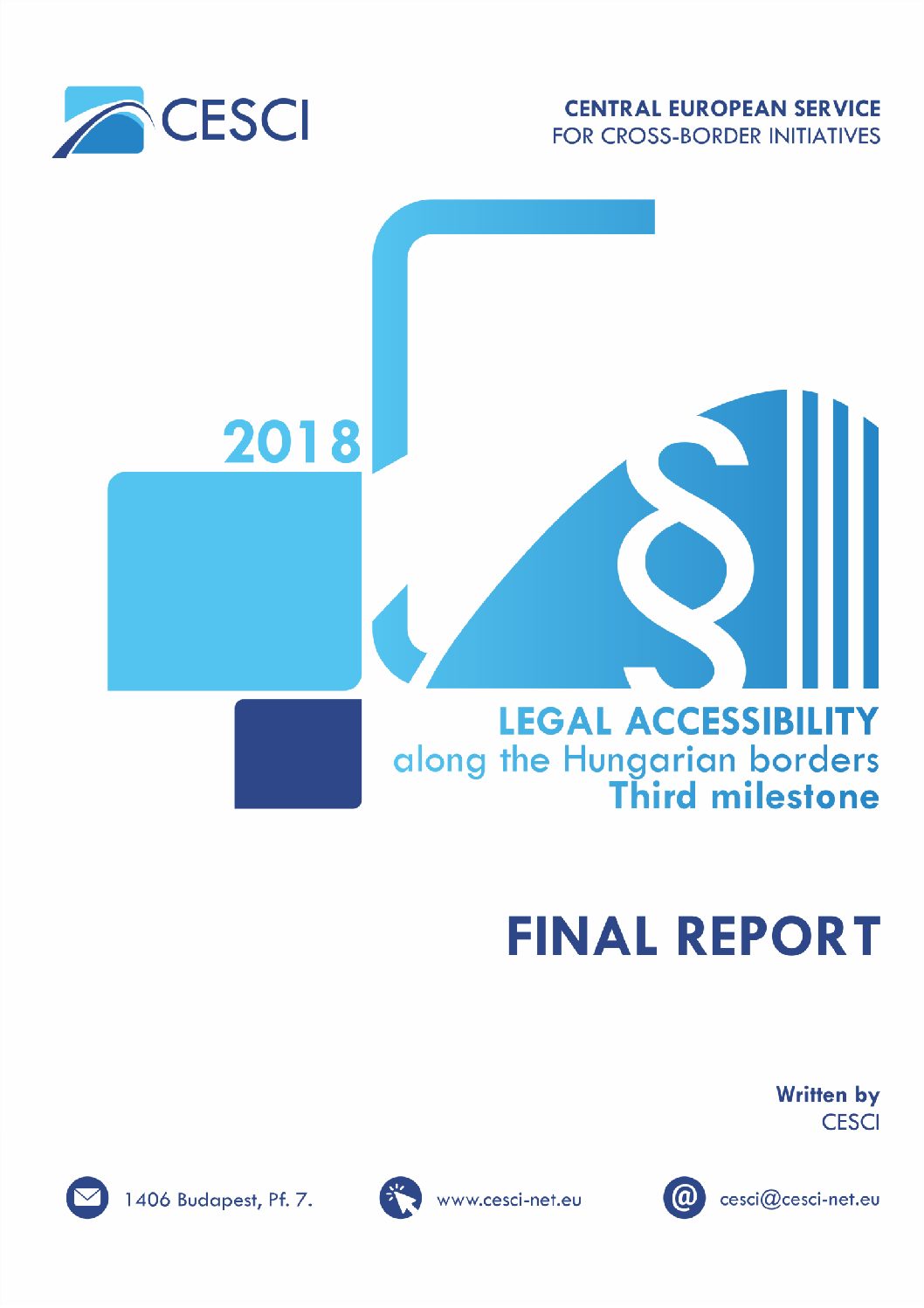 |
1. Cross-border rescue
Objective
In the framework of the subproject, we continued the work that we started during the previous two Legal accessibility projects, further facilitating the development of the cross-border rescue discourse between Hungary and the neighbouring EU Member States. While we analysed the Hungarian regulatory environment in the framework of the 2017 project, in 2018, we tried to explore the position of the authorities of neighbouring countries, and their existing policy guidelines in relation to the topic, which brings us closer to the formulation of the proposals on multilateral harmonisation of legislation.
Download
The summary report prepared in the frames of this subproject can be downloaded by clicking on its cover below.
Implemented activities
In the framework of the subproject, we contacted the relevant cross-border institutions and with the help of the interviews made with those regionally competent (seven persons) in four neighbouring countries (Austria, Croatia, Romania, Slovenia), we gathered information on the operation of the rescue and emergency service. Following the personal interviews, we organised an international, interactive, professional seminar in Budapest, on 13 November in Kossuth Klub, which aimed to establish personal contacts between those affected and to summarise the possible frameworks of the regulatory harmonisation. 28 experts participated in the seminar.
 |
 |
| The participants of the ambulance seminar in the Kossuth Klub |
While according to the interviews, comparing the rescue system of neighbouring countries became possible based on the criteria (organisational structure, financing, system of the rescue unit, time limit for arrival, order of border crossing, operating licenses, use of emergency vehicle lighting, administrative-technical conditions, emergency call centres, radio systems, language factor, openness of cooperation) defined in the previous legal accessibility project, the experts had already discussed the steps that are needed to overcome the obstacles during the seminar.
Proposals
As a result of the subproject, on the one hand, it was determined which further actors would be needed to continue the cooperation. On the other hand, operational proposals have also been formulated, such as: development of a contact mechanism; establishing an international certification system and a common certification; setting up national coordination centres; establishment of interpreting services; development and harmonisation of TETRA radio networks and equipments.
Perspectives
It is possible to continue the project on 3 levels, but in parallel, keeping in mind the synergies:
- the problems, obstacles and solutions identified within the framework of the project should also be reviewed at EU level by addressing EU institutions that are supporting legal harmonisation;
- the already ongoing professional negotiations should continue for bi- or multilateral harmonisation with the involvement of national central bodies;
- at local level, even at each border section, it would be necessary to develop and strengthen personal, professional relations.
2. The establishment of cross-border health services
Objective
Within the subproject, we continued our work that we have already begun in recent years, to prepare for the establishment of cross-border health services. In particular this subproject covered, the rights of patients provided by the European Union and national legislation, as well as the already existing Western European models. In order to study how and under what conditions cross-border service areas could be developed with the participation of Hungary and Hungarian hospitals.
Download
The study prepared in the frames of this subproject can be downloaded in Hungarian by clicking on its cover below.
Activities implemented
To improve cross-border patient mobility, we implemented the following activities:
- A questionnaire was made and sent to cross-border municipalities (53) and (55) cross-border hospitals, but unfortunately, none of the responding organizations could provide a specific example of cross-border cooperation in the field of healthcare;
- We gained relevant experience through interviews with cross-border hospitals;
- We organized a Western European study trip from 12 November to 16 November to the French-Belgian and German-Dutch border, in order to gather information and gain experience of well-functioning Western European models, and to demonstrate the benefits of sharing of services to the experts (In addition to the CESCI’s interpreter-team leader, an employee of the Hungarian Ministry of Human Resources, an employee of the National Health Insurance Fund of Hungary and an employee of the Vaszary Kolos Hospital in Esztergom also participated in the study tour, as well as experts consulted by the CESCI. On 26 November we summarized the results of this study trip within a dedicated workshop.)
- Our attempt to collect data on cross-border patient mobility was limited, but it also pointed out the need to monitor cross-border patient mobility activities;
- A senior expert consulted by the CESCI comprehensively analysed the legal basis for cross-border patient mobility.
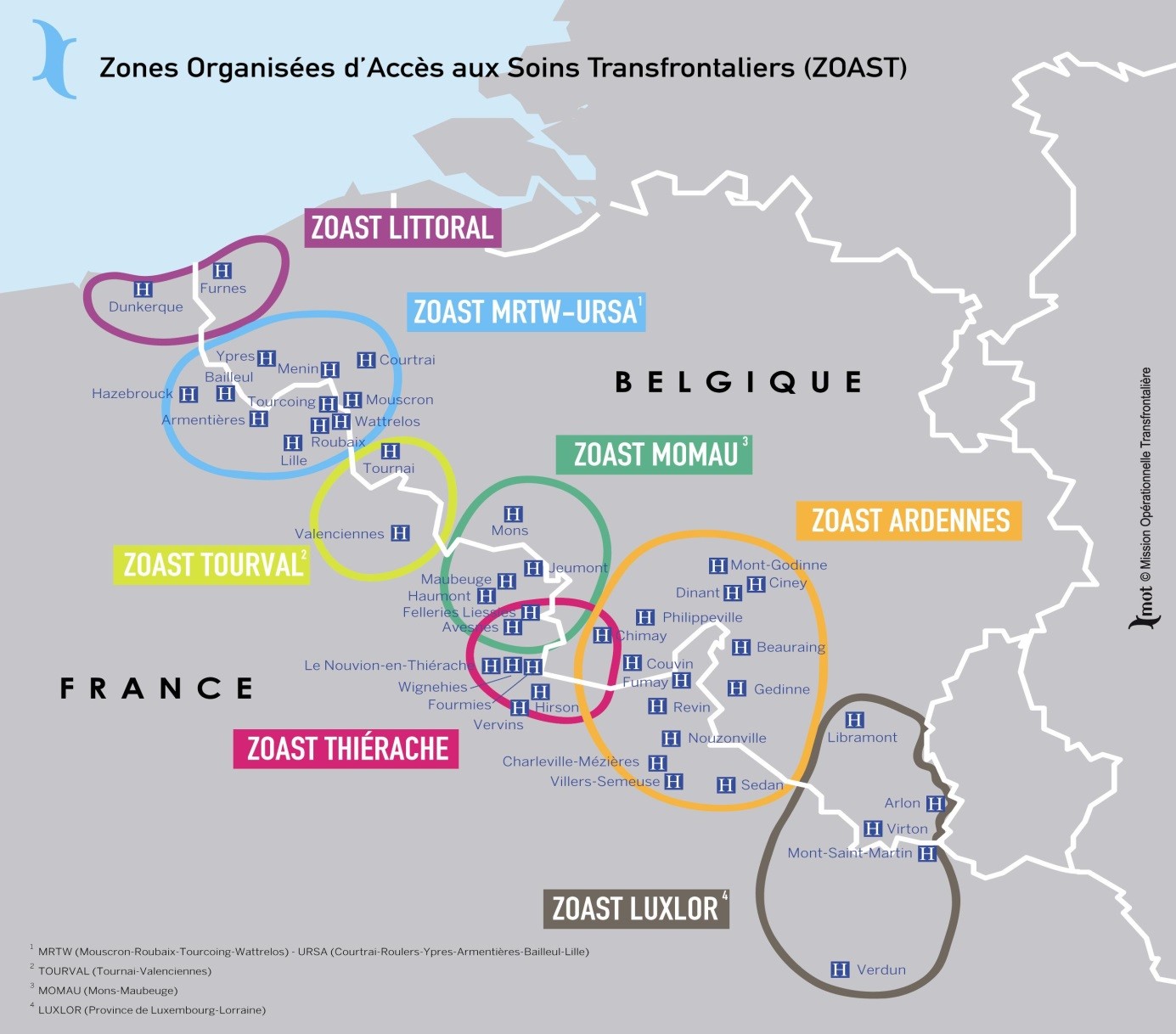
Source: https://eur-lex.europa.eu/legal-content/EN/TXT/HTML/?uri=CELEX:52017SC0307&from=HU
Proposals
According to the results of the subproject, a total of ten specific proposals were formulated concerning border crossings for health purposes, and another four for health tourism. The study presented four possible models for financing medical treatment.
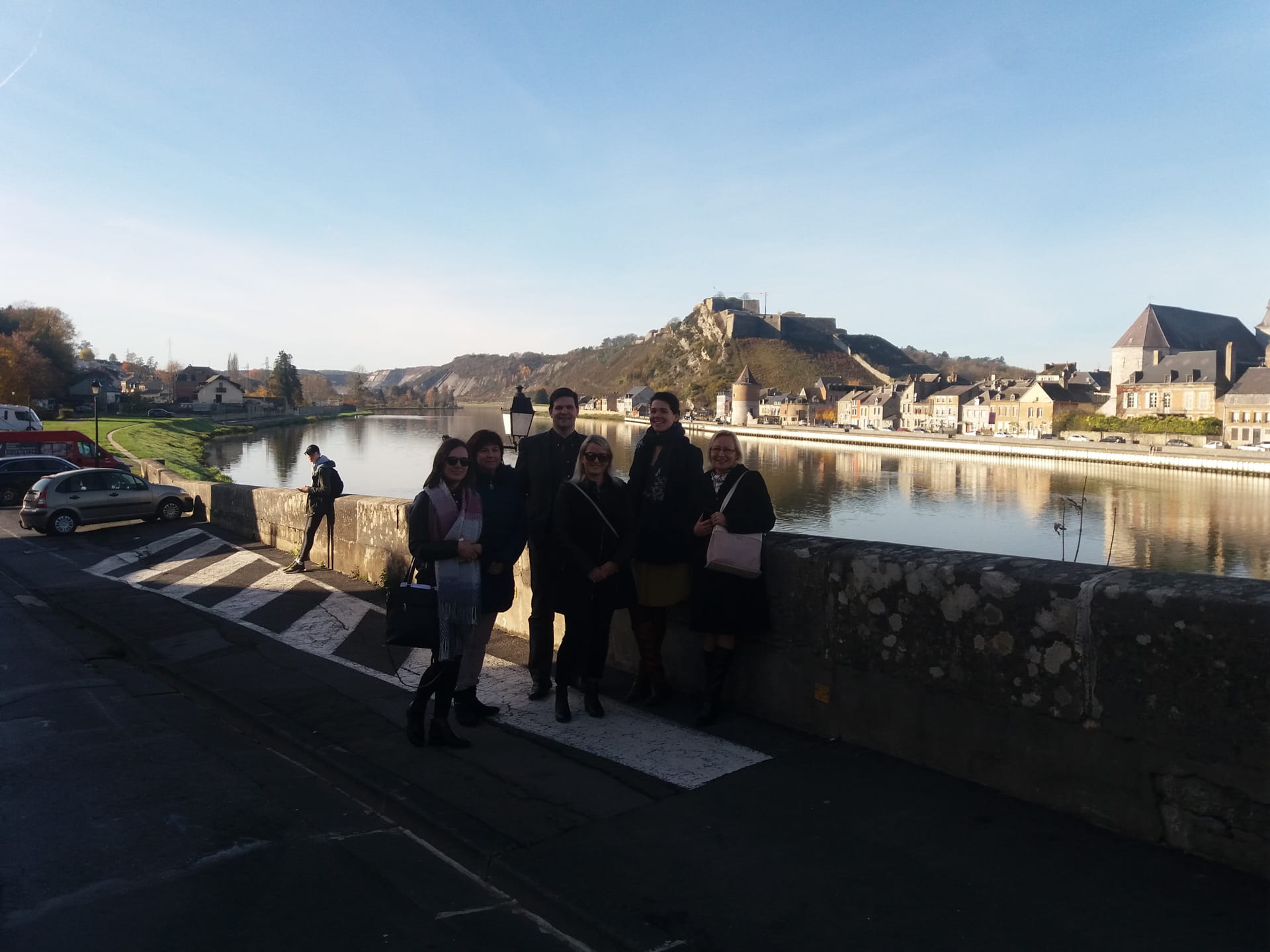
Perspectives
The European Union provides the legislative and policy framework for extending patients’ rights, ensuring the conditions for cross-border patient mobility; however, there is still a need for further action to implement them, which we are planning within the 2019 Legal Accessibility Project:
- further study of the institutional and legal environment;
- assessment of (4) specific cross-border hospitals (PILOT analyzes);
- propositions of the text of intergovernmental agreements in order to facilitate cross-border patient care;
- drawing up model contracts for the provision of cross-border services by the hospitals concerned;
- introducing a guide written in Hungarian in order to organise cross-border patient care.
3. Legal obstacles of EGTCs
Objective
The original aim of the subproject was the review of the work experience and legal obstacles related to the operation of EGTCs with Hungarian interest, in order to review the EGTC Regulation planned in connection with the EU budgetary planning process starting in 2018; and with the help of the review of the work experience and legal obstacles related to the operation of EGTCs with Hungarian interest ,to propose an amendment to the Regulation that can exclude misuse and promote exemplary models across the EU. However, the Commission Report of 17 August 2018 concluded that other types of activities were needed instead of a further amendment of the EGTC Regulation. However, we did not exclude the clarification of the situation in Hungary, and to gather information about the legal difficulties, and taking into account the current good practices
Download
The study prepared in the frames of this subproject can be downloaded by clicking on its cover below.
Implemented activities
In order to gather the operational experience of the EGTCs in Hungary, a questionnaire consisting of 19 questions was sent to EGTCs with Hungarian interest. This questionnaire was completed by 10 EGTCs.
Based on the questionnaire, a personal interview was also made with 8 EGTC representatives. The primary purpose of the interviews was to specify the problems identified during the questionnaire and to go into further details about their experience through the means of personal communication. In addition to the questionnaire and personal interviews with the EGTC representatives, office research work was also carried out within the subproject. This research focused on examining the legal environment at EU and national level for EGTCs, and on reviewing regulations related to the EGTCs’ experience. The project resulted in a study written in English, which was also sent to the EU institutions involved in EGTC policy.
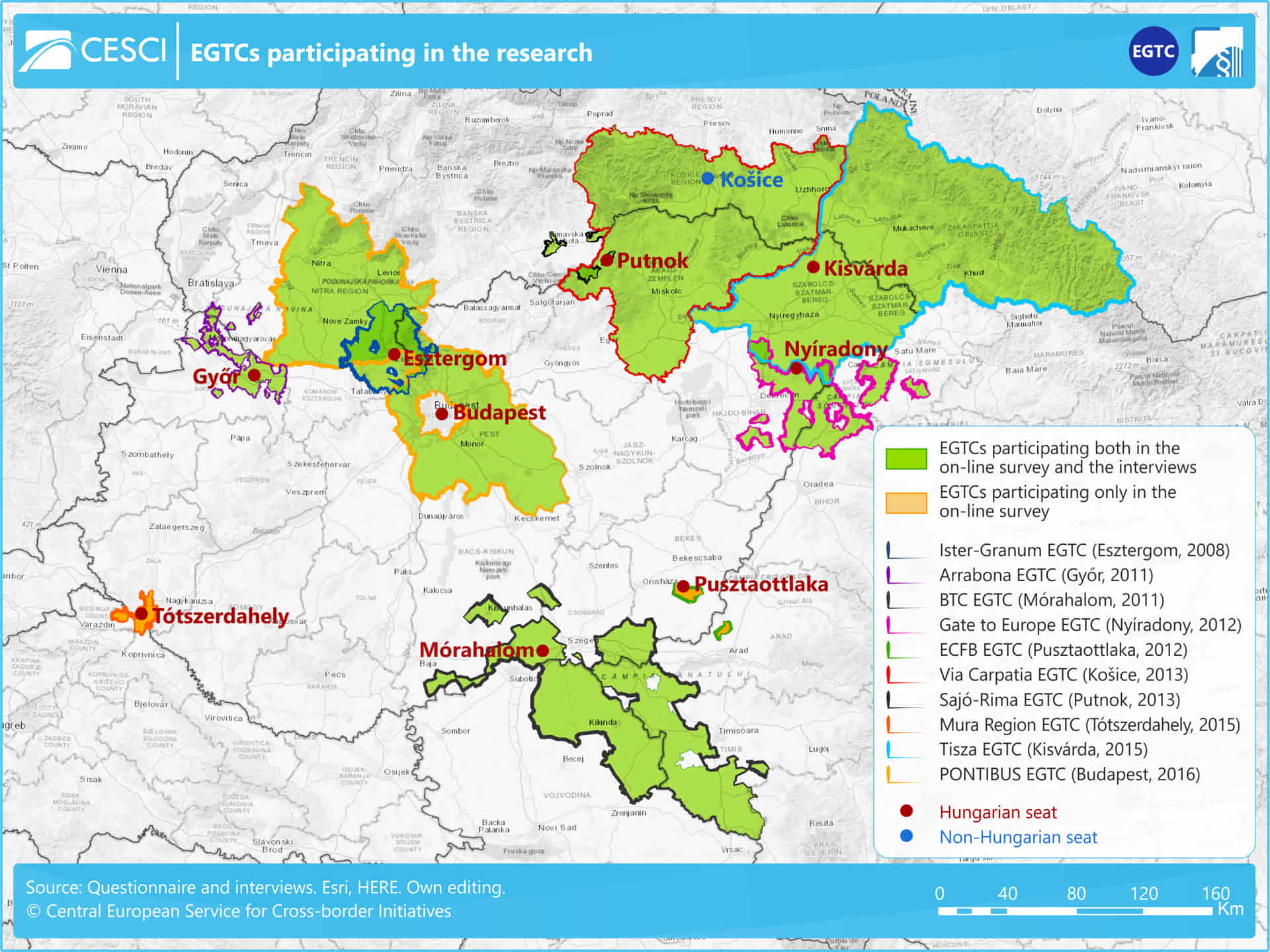
Proposals
Based on the obstacles identified during our research and the professional experience of recent years, we identified three problems and we also made suggestions for eliminating legal obstacles of the functioning of the EGTCs:
- Proposals are drafted in the context of the EGTC ‘s experience revealed in this study;
- Proposals are developed based on the experience gained through many years of professional support of the EGTCs;
- Proposals for how to use the opportunities provided by the current SGEI and EGTC regulations.
Although the first two set of proposals made recommendations based on EGTC’s experience, the third one would like to highlight a way forward with the current SGEI and EGTC regulations.
Perspectives
Based on the information unravelled in the subproject, the study came to a similar conclusion as the report of the European Commission in 2018: the main problem lies not in the legal framework, but in the unambiguous interpretation and unequivocal application of the current legislation, as well as in the lack of awareness of the concerned parties. Thus, the implementation of information events on the situation in the EGTCs is likely to be a continuation of this subproject. In that respect, CESCI launches two new initiatives:
- compiling a guide on the legal environment for cross-border developments;
- and the development of an online platform with the name of the EGTC monitor, which will provide a comprehensive picture of the Hungarian EGTCs.
Completion of indicators (Third milestone)
Cross-border rescue
- Interviews made in the neighbouring countries: 5 pc / 5 pc
- Professional seminars: 1 pc / 1 pc
- The number of EU member states participating at the seminar: 6 countries / 6 countries
- Number of participants at the seminar: 30 ps / 28 ps *
- Summary report: 1 pc / 1 pc
* The Ministry of Human Resources of Hungary had preliminary delegated one development and one legal expert who were not able to attend the event because of other duties.
The establishment of cross-border healthcare services
- Western European study tours on cross-border healthcare cooperation: 2 pc / 1 pc **
- Number of experts participating in the study tours: 6 persons / 6 persons
- Proposal for the regulation concerning the adaptation of Western European patterns: 1 pc / 1 pc
** The two study tours (to the two destinations) were arranged unified in a week due to geographical proximity, financial reasons and to make the organisation easier.
Legal obstacles of EGTCs
- Number of EGTC consultations: 8 consultations / 8 consultations
- Comprehensive policy and legal recommendation relating to the obstacles of the functioning of the EGTCs: 1 pc / 1 pc
Concerning the whole project
- Final report: 1 pc / 1 pc

The project was funded by the Ministry of Justice.
The project documents and the conclusions and recommendations contained therein do not necessarily reflect the official position of the Promoter.
The Legal Accessibility project along the Hungarian borders was launched in 2016 by the CESCI, and it will continue in two areas in 2019:
- Ensuring patient rights through cross-border patient mobility
- Exploring the legal background of cross-border developments in public procurement
The aim of the 2019 project is to continue in the footsteps of the previous initiatives and to continue the work based on the knowledge gained from the three previous Legal Accessibility Projects and the EU’s experience, and to ensure Hungarian presence in the EU discourse.
The final report on the fourth milestone can be downloaded here, by clicking on the cover.
Ensuring patient rights through cross-border patient mobility
Within the framework of the third Legal Accessibility project, we have made progress on issues that
are important for the enforcement of patients’ rights. The Hungarian healthcare system faces a number of problems, and from this point of view the importance of cross-border cooperation is negligible. However, in two aspects, the issue will soon become acute.
- On the one hand, cross-border patient mobility has started and is becoming more and more widespread. At the moment, 93.000 Hungarian workers are employed in Austria, and their health care is partly provided by the Austrian healthcare system, which has to be partly compensated by the National Health Insurance Fund of Hungary. By contrast we can observe the opposite phenomenon in the movement of patients along the Hungarian-Slovakian border: more and more Slovak patients are using the services of Hungarian hospitals, which affects the balance and plannability of the Slovak health insurance system. More and more people from the Serbian and Romanian side of the border are visiting a Hungarian private medical practice, which partly provide their services using the state infrastructure – in some cases it effects negatively persons insured by the National Health Insurance Fund of Hungary. These problems lead to serious health economic impacts, and their solution requires the creation of legal instruments.
- On the other hand, one of the great achievements of EU integration is to reduce the dividing role of borders. As a result, there is a growing need to functional border areas in these regions by increasing the availability of cross-border services. The directive 2011/24 of the EU and the European Parliament intended to facilitate this process. However, as the report published in 2018 points it out, the application of the directive at national level is seriously impeded. Nonetheless, it is a principle that no one should die because of a state border if there is a healthcare facility in the immediate vicinity of the border where they can prevent the person’s death. In fact, contesting this principle questions the essence of the European Union.
By the end of 2019, building upon the results of the 2018 project, we will develop specific legal solutions to successfully address this problem. The project includes the following activities:
- monitoring the institutional and legal environment,
- assessment of the 4 specific border hospitals,
- proposing the text of intergovernmental agreements in order to facilitate cross-border patient care (where necessary),
- proposing an initiative on the cross-border movement of ambulances
- organizing a professional seminar for the international medical rescue committee,
- preparation of model contracts for the hospitals concerned in cross-border services, involving the relevant partners;
- writing a handbook for organizing cross-border patient care.
We also want to involve external experts in the tasks mentioned above.
Events / Cross-border patient mobility (4th milestone)
Results / Cross-border patient mobility (4th milestone)
The study prepared in the frames of this subproject can be downloaded by clocking on the picture below (in Hungarian).
Results of the subproject were summarized in the following points. Click on the text for details.
Objective of the subproject
Within the framework of the third legal accessibility project, we have made a progress on issues that are important for the enforcement of patients’ rights, based on which, this year we focused on the institutional and legal environment. The subproject aimed to draft concrete, textual legal proposals for bilateral solutions and elaborate a guideline supporting their implementation in the field of ambulance services and healthcare with the involvement of the competent actors, in order to manage the increasing cross-boreder patient flow, and to improve the quality of care in the border areas lacking functions. To this end we:
- analsysed the institutional and legal environment,
- assessed the possibilities of cross-border service provision in 4 hospitals located along the border,
- made a proposal for the text of intergovernmental agreement in order to facilitate cross-border patient care,
- prepared model contracts for the hospitals concerned with cross-border service provision with the involvement of the relevant partners,
- organized the professional annual seminar of the EMS task force,
- organised an EMS study tour to Lower-Austria,
- made a proposal for the text of intergovernmental agreement on the cross-border movement of ambulances elaborated a guideline (in Hungarian) for supporting the implementation of cross-border patient care.
Presentation of the activities that were implemented within the frame of the subproject
Interviews
According to the 2018 analysis of national situation, four publicly funded Hungarian healthcare institutions, located along the border section and identified as being highly involved in cross-border cooperation, were tested within the frames of an interview method. The criteria for selecting the service providers were the following ones:
- the selected healthcare institutions should be located far from each other, preferably along four different border section of Hungary (examination of the Austrian and the Ukrainian border was omitted because of the existence of significant differences either in technical or price level of given services);
- the hospitals should represent different levels of progressivity, from the basic urban hospitals with four departments to the university clinic.
The following institutions were involved in the interviews: the Vaszary Kolos Hospital (in Hungarian-Slovak relation), the Mohácsi City Hospital (in Hungarian-Croatian relation), the Albert Szent-Györgyi Health Center of the University of Szeged, the UNI-MED Szeged Healtcare Ltd. that assures the full-range paid healthcare services (in Hungarian-Romanian and in Hungarian-Serbian relation), as well as the Zala County Szent Rafael Hospital (in Hungarian-Slovenian relation). During the interviews with the institutions, their experience with cross-border health services and the issues of resources that support their participation in cooperation were explored.
The interviews were based on a pre-developed standard set of questions based on the experience of the third milestone national survey. Two interviews were conducted at the Albert Szent-Györgyi Health Center of the University of Szeged, regarding that an economic company specially established for that purpose, UNI-MED Szeged Healtcare Ltd. assures a full-range paid outpatient and inpatient healthcare services.
The conclusion of the interviews were summarized and examined within the framework of a multi-approach benchmark, hereby giving an overall picture on the development potentials of cross-border patient mobility.
Second international EMS seminar (30 September 2019)
The second interactive seminar on cross-border ambulance services was held on 30September in Budapest, in which local experts and experts from the neighbouring EU Members States discussed the frameworks of long-term cooperation based on the Austrian-Czech good practice.
We invited to the seminar the regionally (i.e. borderlands’) competent leaders of the ambulance services and the representatives of the competent ministries and state institutions of domestic and neighbouring countries.
Participants of the seminar:
- Ács Zoltán, Operačné stredisko záchrannej zdravotnej služby (Emergency Medical Service Operations Center) (SK)
- dr. Balogh Tamás, CESCI (HU)
- dr. Csató Gábor, Országos Mentőszolgálat (National Ambulance Service of Hungary) (HU)
- dr. Engelbrecht Imre, Országos Mentőszolgálat (National Ambulance Service of Hungary) (HU)
- dr. Juca Dacian, SMURD (Emergency Situations Department) (RO)
- dr. Gencsi László, Ambulanta Bihor (Bihor County Ambulance Service) (RO)
- dr. Golopencza Pál, Országos Mentőszolgálat (National Ambulance Service of Hungary) (HU)
- dr. Gyenes Kata, Állami Egészségügyi Ellátóközpont (National Healthcare Services Center) (HU)
- dr. Jova Anett, Országos Mentőszolgálat (National Ambulance Service of Hungary) (HU)
- Oec. Mirjana Hanžeković, Zavoda za hitnu medicinu koprivničko-križevačke županije (Institute for Emergency Medicine of Koprivnica-Križevci County (HR)
- Juraj Hrehorcak, Operačné stredisko záchrannej zdravotnej služby (Emergency Medical Service Operations Center) (SK)
- Hüse-Nyerges Enikő, CESCI (HU)
- Vladimira Križaj-Grabant, Zavod Za hitnu medicinu međimurske županije (Institute for Emergency Medicine of Medjimurje County) (HR)
- Christian Legler, Notruf NÖ (Notruf Lower-Austria) (AT)
- dr. Lórántfy Mária, Országos Mentőszolgálat (National Ambulance Service of Hungary) (HU)
- Lucia Mesárošová, Operačné stredisko záchrannej zdravotnej služby (SK)
- Ocskay Gyula, CESCI (HU)
- dr. Susanne Ottendorfer, Notruf NÖ (Notruf Lower-Austria) (AT)
- Július Pavčo, Operačné stredisko záchrannej zdravotnej služby (Emergency Medical Service Operations Center) (SK)
- dr. Licniu Venter, Ambulanta Bihor (Bihor County Ambulance Service) (RO)
- Siegfried Weinert MSc, Notruf NÖ (Notruf Lower-Austria) (AT)
- dr. Zágori Szilvia, Emberi Erőforrások Minisztériuma (Ministry of Human Capacities of Hungary) (HU)
Study tour to Lower Austria (9-10 December 2019)
In order to gather experiences about the well-functioning Austrian-Czech practice and to demonstrate the advantages of service sharing to professional representatives, a two-day long study tour to Lower Austria was organised. Participants travelled by minibus to St. Pölten where they visited the coordination centre of Notruf 144 Niederösterreich, the University Hospital of St. Pölten, as well as the ambulance station and disaster management centre of the Red Cross and interviewed the local professionals. In addition, they met with the experts of NÖGUS, responsible for coordinating local and cross-border cooperation.
Participants:
- dr. Bathó János, Országos Mentőszolgálat (National Ambulance Service of Hungary) (HU)
- MUDr Jan Ciernik, Zdravotnická záchranná služba Jihomoravského kraje (Emergency medical service of the South Moravian Region) (CZ)
- dr. Gencsi László, Ambulanta Bihor (Bihor County Ambulance Service) (RO)
- dr. Golopencza Pál, Országos Mentőszolgálat (National Ambulance Service of Hungary) (HU)
- Alexander Heller, Landessicherheitszentrale Burgenland (Security Center of Burgenland) (AT)
- Juraj Hrehorcak, Operačné stredisko záchrannej zdravotnej služby (Emergency Medical Service Operations Center) (SK)
- Hüse-Nyerges Enikő, CESCI (HU)
- dr. Jova Anett, Országos Mentőszolgálat (National Ambulance Service of Hungary) (HU)
- dr. Juca Dacian, SMURD (Emergency Situations Department) (RO)
- Christian Legler, Notruf NÖ (Notruf Lower-Austria) (AT)
- dr. Lórántfy Mária, Országos Mentőszolgálat (National Ambulance Service of Hungary) (HU)
- Christine Philipp, Burgenland Province (AT)
- Siegfried Weinert, MSc, Notruf NÖ (Notruf Lower-Austria) (AT)
- dr. Zágori Szilvia, Emberi Erőforrások Minisztériuma (Ministry of Human Capacities of Hungary) (HU)
Analysis and recommendation
A senior expert invited by CESCI thoroughly analysed the institutional and legal background of cross-border patient care then, reviewed and introduced the mechanisms of publicly financed patient care, which are theoretically appropriate for financing cross-border healthcare cooperation, as well as the reality of their application in light of the recent Gov. Decision No. 1798/2019. (XII. 23.).
Considering the related international, bilateral and national legistlative environment of healthcare and regional development, a proposal was made for an interstate agreement enhancing cross-border patient care; as well as for cross-border movements of ambulance, capitalizing also the experiences of seminar and the study tour.
Finally, a guide was made for the organisation of cross-border patient mobility based on the practical handbook of the Institute of International Sociology of Gorizia.
Summary of the subproject results
Main findings of the interviews and aptitude assessment
- In spite of the fact that only one of the four hospitals (Esztergom) of the five explored border regions has formalized cooperation (at least partially) next to the cost of public funding, but all hospitals regularly provide care for persons insured abroad. Thus, there is a claim for cross-border healthcare, but Hungary does not exploit, consciously, the potential possibilities in it, because it has not established the favourable regulatory framework of this cooperation.
- Regional/interregional cooperation for spatial development and professional (e.g. Zalaegerszeg-Muraszombat) cooperation has an incentive effect on cross-border healthcare provision in certain frontier areas. However, there is a lack of nationally determined development intention, namely forward-looking, systematic thinking and a regulatory environment capable of ensuring long-term cooperation.
- From the institutional side, cross-border healthcare provision is typically motivated by the desire to increase institutional revenues and the intent to increase the capacity utilization. Simply, it is motivated by profit maximization. Although, cross-border healthcare cooperation is primarily motivated by the principles of humanity and solidarity.
- It is an unusual approach (e.g. in the case of the institution in Szeged) in which contractual relationships, established with foreign business insurers outside of the social security, are not considered as cross-border healthcare cooperation for Hungarian healthcare.
- There is a particular mixture within the institutional thinking regarding the institutional conditions for participating in cross-border cooperation. Szeged and Zalaegerszeg clearly approach the possibility of participating in such cooperation through logic of free institutional capacities; although, they consider it necessary that institutional care remains below the performance-volume threshold. However, this approach ignores the mandatory rules of the European patient care regime which is compulsory in Hungary, too.
- The language barriers typically do not constitute a barrier to cross-border healthcare cooperation in the reflected institutions, the required language skills are adequately available everywhere.
- A real claim has developed for cross-border ambulance services on the Hungarian-Slovakian border.
Main findings of the seminar
The seminar was opened by Dr. Gábor Csató, Director General of the National Ambulance Service of Hungary who highlighted the importance of cross-border cooperation. Then Gyula Ocskay, Secretary General of CESCI presented the Legal Accessibility initiative giving the framework of this project. After him, Enikő Hüse-Nyerges, project manager, and dr Tamás Balogh, expert of CESCI, introduced the past and recent activities and results of the sub-project on ambulance services. They spoke about the overall study and proposals on the Hungarian legal and administrative framework of cross-border EMS elaborated in 2017 and about the legislative proposal for cross-border movement of ambulances which is elaborated by now.
Following the introduction of the participants, Susanne Ottendorfer and Siegfried Weinert, representatives of the “Notruf NÖ”, presented the cooperation model between Lower Austria and the Czech Republic. They spoke about the history, the legal and administrative frames, and the practical details of the cooperation. The states, which have a cooperation agreement for mass disasters since 2000, signed a state treaty in 2016 in order to improve the availability of emergency healthcare in the border regions. The basic principle is that the patient should be transferred as fast as possible to the closest and adequate healthcare institution independently from their nationality, the EMS unit and the location of the hospital. Based on the state treaty, cooperation agreements were elaborated and signed which clarify the details of the cooperation including the language use, the communication and cooperation protocols or the transfer of drugs across the border.
Regarding the practical side of the cooperation, the speakers introduced the core element: a web application providing information exchange and communication between the coordinating centres. On the one hand, the application is able to localise each active EMS units around the place of deployment and makes it possible to ask for intervention from the other side of the border through only a couple of clicks. On the other hand, real-time communication is provided through the internal chat function. The application itself is quite simple, it was developed with a minimal budget and it is transferable within a reasonable time to other border regions.
At the end, the speakers pointed out the fact that the launch of the cross-border cooperation has resulted in an improved quality of life and cost efficiency in the border regions. They also drew the attention to the fact that it is enough to mutually approve each other’s national regulation: there is no need for legal derogation (simalrly as in case of the ECBM). At the end of the section, the participants had the opportunity to ask questions from the speakers, like questions about solving of practical problems, financing and institutional agreements.
After lunch break, the representatives of participating countries were able to share their opinions on the different aspects of potential cooperation during the interactive section in the afternoon:
- There was an agreement among the participants concerning the actors to be involved in the cooperation, which are the competent ministries, dispatcher services and emergency services. Siegfried Weinert added that based on their experiences, sometimes less is more, which means that the less institution were involved in the agreement process, the faster a possible solution would be found.
- Considering communication issues, only the question of data protection seems to be problematic. Each country has different solutions for the admission, management and storage of patient data. The possibilities of sharing these pieces of data across the border should be examined individually in light of the national and the EU GDPR regulations.
- In case of financing, participants agreed that an extra budget would not possibly be needed to the implementation of cross-border tasks, because the compensation of cross-border case numbers and related costs are most likely to occur.
Besides, in case of Slovakia, it was emerged that they regularly make analysis about the optimisation of the number and location of ambulance stations, the next one of which could also be made by considering the capacities on the Hungarian side.
In the end of the seminar, in order to enhance cooperation Gyula Ocskay offered the help of CESCI in organising bilateral professional meetings and a study tour to Lower Austria with the aim that the participants may understand the Austrian-Czech good practice.
Main findings of the study tour
The first agenda item of the study tour was the visit of the coordination centre of the Notruf 144 Niederösterreich. The Chief Executive Officer of the organization, Christof Constantin Chwojka, greeted the delegation and gave his support for the cooperation in the future. After that, Siegfried Weinert and Christian Legler staff members for planning, preparing and managing the cross-border cooperation initiatives took the floor. They introduced the details of the structure and operation of the Notruf 144, including the coordination mechanisms concerning the EMS and further healthcare services, as well as, the background infrastructure together with the applied technical solutions. The participants had the opportunity to get an insight into the routine of the dispatchers; in addition, the participants could see the practice of cross-border cooperation through simulation of the on-line application for dispatchers in operation.
The application automates and formalises cross-border assistance with the help of a data sheet. The system offers three possibilities to determine the subject of assistance from the Czech point of view:
- rescue operation in the Czecz Republic, request for the support from the Austrian EMS;
- rescue operation in Austria, the Czech EMS takes over the operation;
- rescue operation in Austria, which is handed over to the Austrian emergency operation centre.
After that, the dispatcher should choose the professional classification of the case from a list (respiratory arrest, allergy, etc.), however the groups of diseases/types of services are different on the two sides of the border. The parties decided to keep their own (national) classifications, and adding their groups to the jointly developed, more comprehensive categories instead of harmonisation. Introduction about this is provided to all the dispatchers. Apart from the dropdown menu, the dispatcher can add a more detailed description of the case. Beside that, the location of the case must be added on the data sheet.
After filling in all the required fields of the data sheet, a list of nearby Austrian and Czech rescue units appear with their types (ALS, BLS), and their distance from the case, both in kilometres and in times. The dispatcher chooses the most competent rescue unit(s) – according to his/her opinion – and sends the request for cooperation.
The application sends the request to the receiver in the filler’s language, which is translated with the help of Google Translate. The receiver can accept or deny the request with a click (one by one in a case of requesting more rescue units). If the request is accepted, the chat function opens which provides real-time communication between the dispatchers of both sides. The application automatically translates the text to the receiver’s language with the help of Google Translate.
On the Austrian side, these are the dispatchers and the supervisor who are allowed to ask for cross-border assistance if an adequate number of national rescue unit is not available on the Austrian side.
In the case of cross-border assistance, the rescue unit is always in contact with its own coordination centre via radio (the Austrian network reaches to Brno) or mobile phone. The dispatchers of the two sides continuously communicate with each other on chat. The rescue unit determines if the patient should be taken to hospital according to its inner protocol, while the two dispatchers choose the nearest suitable hospital together.
In case of cross-border action, each rescue unit works according to its national regulation (medical license, usage of distinguishing signs, etc.) and professional protocol, which is mutually respected by the parties. In practice, it means that a Czech doctor does not need a chamber membership and permission or the driver and the vehicle also do not need any extra permission to use the distinctive signs on the other side of the border.
The participants raised several technical questions, as a result of which the previously indistinct aspects were clarified.
The second day started in the University Clinic of St. Pölten, where Mag. Dr. Bernhard Kadlec commercial director shortly introduced the hospital, then he showed the emergency and supporting departments to the participants. The university hospital offers high quality care, especially in the field of cardiology and neurology. They accept 500 000 out-patient per year in 18 departments. In addition, they operate their own, digitally-based logistic centre which provides several hospitals in the region with equipment and medication on a daily basis.
In the remaining part of the morning, Elke Ledl, Head of the Lower-Austrian Healthacross Initiative aiming to enhance cross-border cooperation in the field of healthcare introduced their first INTERREG-V project implemented with the participation of Gmünd and České Velenice, which grounded the current widespread cooperation of the Lower-Austrian and the Czech provinces as a result of a 13-year long cooperation. Finally, she spoke about the initiatives launched together with Slovakia and Hungary. She highlighted that beside the political will to cooperate, the information of citizens are also crucial in order to eliminate the mental border which exists in their daily routine.
As last agenda items, the group visited the Red Cross EMS station in St. Pölten, then the disaster and logistic centre in Münchendorf, where Michael Sartori held a short briefing on their activity of the group, the relating infrastructure and tools. In Austria, 90% of the emergency medical services are provided by the Red Cross.
As an overall conclusion, it was conceived, that the Austrian healthcare institutional system is substantially more decentralised than the Hungarian one, in which the institutions have a significant freedom of decision within the well-based provincial framework. This might limit the applicability of the model in Hungary.
Based on the presented hospital and ambulance station, the applied healthcare devices and equipment, treatments and protocols are highly similar to the Hungarian ones. However, there are substantial differences in technologies applied in the case of supporting functions, and in the employee- and patient-friendliness, as well as cost- and time-effective organisation of services. In this regard, the Austrian system can certainly be considered as a good example.
The Austrian-Czech cooperation is exemplary, concerning both of its aims, as well the simplicity and transparency of its operation. Of course, there are questions to be clarified on bilateral level, but it can be said that it would worth adapting this model in Hungary and the neighbouring states.
Main findings of the analysis and proposals
Considering the available legal and institutional frames, the most favourable and most advantageous tool for cross-border healthcare cooperation in Hungary is the health card to be introduced based on bilateral cooperation agreements, according to the rules of the EU patient care regime which is limited to the geograpfic territory and service providers of the cooperation. Its functionality conforms to the functionality of the form E112 in every other respect.
The interest articulation and aims of the current Hungarian governmental health policy do not generally consider the advantages that may be come from cross-border healthcare cooperation, as a result of which the exploitation of these advantages are realistically not expected.
Bodies responsible for the planning of healthcare system have not collected regular, automatically structured data on cross-border healthcare services since 14 years. Thus, it would be crucial to display the cross-border aspects in the data collection to ground the structure change imposed by Gov. Decision 1798/2019. (XII. 23.). The National Health Insurance of Hungary (NEAK) is already capable of producing some part of the necessary data. However, these set of data are currently not produced on a regular basis, but based on individual, ad hoc requests, which require significant amounts of extra work. It causes workload that can be reduced if these types of data processing become the default functions of NEAK’s database.
Cross-border healthcare cooperation lies in the competency of minimum two large sectors: regional development and healthcare (foreign affairs and transportation are also attached to this). Thus, any successful cooperation and action can only be established with the close cooperation of at least these two sectors. In light of this, interstate agreements should be made according to the following legislations:
- XXI/1996 on regional development and area management,
- LXXV/2014 on European Territorial Cooperation,
- CLIV/1997 on healthcare,
- and No. LXXXIII/1997 on compulsory health insurance services.
Valid Hungarian healthcare acts are familiar with the term of cross-border healthcare service but these attach a meaning to it which is irrelevant in respect of regional (real cross-border) cooperation. Even with this, we don’t find it necessary to modify the concept of cross-border healthcare services according to paragraph 5/B. of legislation No. LXXXIII/1997. Instead, the introduction of the concept of “service offered in the framework of cross-border healthcare cooperation” with an adequate content would be an appropriate solution.
Goals of cooperation of the involved parties, within the frames of healthcare, as well as rescue/ambulance segment of cross-border cooperation can be effectively achieved if the framework of their harmonised action is as little spontaneous as possible. In this field, significant achievements can be reached by long-term commitments. Within the field of cross-border cooperation, typical instruments for this are the framework agreements and the administrative/implementing agreements – with framework filling character – concluded on the basis thereof, as well as (in the case of legal relationships which are not covered by social security schemes) service contracts between healthcare institutions and their patients. Within the frame of the project, the following suggestions were prepared in this regard:
- a framework convention sample for bilateral agreements on cross-border healthcare cooperation;
- a framework convention sample on intergovernmental regulation of cross-border rescue that was elaborated by utilising the Austrian-Czech treaty, the experiences of the related study tour and the comprehensive study prepared within the framework of this initiative in 2017;
- an agreement sample on the implementation of cross-border healthcare cooperation framework convention;
- a model form of a contract to provide services in order to regulate the relationship between healthcare providers and their non-insured (cost of the care is self-funded) clients.
In order to create cooperation between cross-border healthcare services and healthcare providers practical questions should be clarified:
- which partners (who?),
- in which areas, in regard of which actions/services (what?),
- in which geographical area (where?),
want to create/develop cooperation, furthermore:
- from what community resources [EU] they want to launch cooperation,
- and from what resources [own or national] they want to provide the operation (from what resource?).
This requires the consideration of the following circumstances in any cases:
- Organisers and participants of future cooperation should know each other’s relations accurately. The large number of partners, the same or similar interests without the proper harmonisation, would rather counteract than strengthen each other. Considering this, in favour of successful cooperation, the mapping of all cross-border structures and local actors is fundamental during the preparation of cooperation. Participants should also answer the question that how their aims suit the system of objectives of the cooperation intended to be established between healthcare service providers and how to integrate them into the new cooperation – if possible.
- In light of paragraph 27 (9) of legislation LXXXIII/1997 on compulsory health insurance services the National Healthcare Services Center (ÁEEK) and The National Health Insurance of Hungary (NEAK) should be involved in the preparation of agreements that establish cooperation between cross-border healthcare service providers even whether targeting publicly or privately funded patient care.
- The interoperability of borders is the basic condition of efficiency and sustainability of cross-border cooperation. In light of this, it is important to recognise that the development of cooperation between cross-border healthcare service providers requires close consultation not only among future cooperating partners, but also among those, who are responsible for other sectoral development (e.g. transportation).
In favour of smooth cooperation, contacting with governmental partners and planners of the neighbouring states in cross-border healthcare cooperation is nearly as important as the other factors mentioned above.
Fulfilment of the identified indicators of the subproject
- International professional seminar: 1 pc / 1 pc
- EU member states participating at the seminar: 5 countries / 4 countries*
- Aptitude assessment: 4 pc / 4 pc
- Draft proposal for interstate agreement: 1 pc / 1 pc
- Legislative proposal for cross-border movement of ambulances: 1 pc / 1 pc
- PILOT-agreement of regional patient care: 4 pc / 1 pc**
- Guide for organising cross-border patient mobility: 1 pc / 1 pc
* The Slovenian participants were unable to attend the seminar due to time conflict.
** On the basis of the results of the aptitude test, one contract template sample, possible to use widely, was developed instead of 4 institution-specific contracts.
Possibilities for continuing the subproject
In this case, the scope of healthcare cooperation can be divided into two major areas.
In case of ambulance services, it would be necessary to continue the discussions, launched within the frame of the project, at bi- and/or multilateral level. As a result of the previous events, the next professional meeting, which is expected to take place in February of 2020, is being organized by the Healthcare State Secretary of the Ministry of Human Capacities, the Ministry of Foreign Affairs and Trade, and by the National Ambulance Service (NAS) with the competent authorities of two neighbouring countries, Austria and Slovakia. The meeting will focus on a potential state treaty based on the Austrian-Czech best practice, which is under revision by the legal staff of the National Ambulance Service. To the invitation of the Ministry of Human Capacities and the NAS, CESCI takes part in the further work as facilitatator of the discussions.
However, it would also worth countinuing to maintain and to strengthen the relationships with the other neighbouring EU member states. This could be implemented by bilateral meetings and/or multilateral consultations, similar to previous ones (e.g. seminar).
Regarding patient mobility across the Hungarian borders, cooperation is currently less advanced, because of the complexity of the topic and the structural problems of the sector in Hungary.
However, within the framework of the project, preparation of the cooperation on a professional level was carried out, which might be continued by reviewing the cross-border aspects of the policy area, as well as launching consultations with the neighbouring countries by the competent actors, mainly on national level. With the appropriate intentions, a suitable framework could be provided by the upcoming transformation process to be implemented according to the Government Decree 1798/2019. (XII. 23.).
Last, but not least, it is important to maintain and to strengthen both topics in the cross-border cooperation discourse also at the level of the European Union. Among others, the DG REGIO initiatives or platforms, such as the EUREGHA forum, bringing together local and regional stakeholders of the cross-border healthcare cooperation, offer possibilities for it.
Exploring the legal background of cross-border developments in public procurement
One of the most frequently mentioned problems in the EGTCs consultation during the 2018 project was the conduct of public procurement procedures related to cross-border projects.
- On the one hand, the relevant EU regulation is contradicted by Hungarian national law when it excludes a Hungarian-based EGTC from announcing a call under the public procurement law of a neighbouring country.
- On the other hand, it is not clear how to procure the individual elements for integrated projects. This is particularly problematic for integrated developments that have investment implications on both sides of the border.
In order to solve these issues, we will analyse the current legal framework within the 2019 Legal Accessibility Project, make a textual recommendation in order to eliminate the lack of legal harmonization, and compile a handbook on public procurement procedures for cross-border projects.
Results / Cross-border public procurement (4th milestone)
The study prepared in the frames of this subproject can be downloaded by clicking on the picture below (in Hungarian).
Results of the subproject were summarized in the following points. Click on the text for details.
Objective of the subproject
In the course of project 2018, one of the recurring topics during consultations with EGTCs was the complex implementation of public procurement procedure connected to cross-border projects. First, it was problematic that a Hungarian based EGTC could publish a call according to the public procurement law of the neighbouring country. Second, it was emerged that how each item should have purchased in case of integrated projects. It mainly caused problems in developments, which needed investments on both sides of the border.
Concerning the complexity of this topic, first, general legal framework was analysed on a basic level in the course of the current project, to settle raising questions. A proposal was formulated to eliminate the lack of harmonisation of law, and a guide was made to help the public procurement procedure of cross-border projects.
Presentation of the activities that were implemented within the frame of the subproject
No special conciliations and conferences were held in the topic of the subproject yet. It was only processed by a legal expert on the mentioned basic level, who rated the available legislations of member countries that could come into question and of third countries, as well. The expert prepared a formulation of amendments and a guide, too.
During the work, in favour of transparency, we analysed the related provisions of all countries that could come into question, even if large leeways could be noticed in the regulation system of certain countries (see third countries), mainly because they were lacking of the EU membership.
We divided the professional work into the following subtasks:
- Review the EU and certain national public procurement regimes:
- Review the public procurement regime of the European Union;
- Review the public procurement regime of Hungary;
- Main differences in the neighbouring member states’ and third countries’ public procurement regime from the Hungarian one (if interpretable).
- Public procurement regulations related to the implementation of cross-border projects (integrated projects);
- In the relation of member state-member state;
- In the relation of member state-third country (if interpretable).
- Proposals on harmonisation of law and legislation in favour of clarifying, simplifying and improving cross-border (public) procurement of EGTC.
- Guide on cross-border public procurements for EGTCs (including the whole procedure from the preparation to the closing of delivery).
Summary of the subproject results
Exploration of differences in harmonisation of law
During the harmonisation of law, one starting point of the policy of the European Union was to establish real internal market on public markets to provide equal opportunity, equal and non-discrimination treatment, fair competition and transparency for economic operators. Although, at the latest modernisation review of directives in 2014, the better usage of public procurements to support common economic and social (strategic, sustainability, innovative) aims, the increase of the efficiency of public expenditure, as well as to promote small and medium-sized enterprises to take part in public procurements were already an important aspect.
However, the development of the new directives’ contents were affected by the previously effective Directive 2004/18/EK that implicitly allowed common cross-border public procurement, there is still a significant legal and practical problem for contracting authorities to buy from central purchasing bodies of other member states or award public procurement contracts together. Because of this, new regulations on common cross-border public procurement were established, which facilitated cooperation between contracting authorities, the conditions of cross-border requisition of central purchasing bodies was named and a public procurement law applicable in cases of common cross-border procedures was made including regulation applicable in cases of legal remedy for the contracting authorities of different member states, furthermore, it was made possible to establish common organisations based on national or EU law.
In relation to the analytical methodology of the study, it should be noted, that the regulation of Directive (Classic Directive) 2014/24/EU and Directive (Public Service Directive) 2014/25/EU on public procurement are basically the same, therefore, they both can be applied to all public procurement contracting authorities, thus in the followings, only the provisions of classic directive were examined. Finally, public procurement regulations were not included in Concession Directive 2014/23/EU, which doesn’t mean that – in light of the evolution of directive – there is no place for such procurements and for their directive regulation below in the case of concession procurement objects.
Requirements formulated by directives were adapted into public procurement norms through member state laws and implementing legislations. It is worth mentioning that not all member states meet the deadline of 18 April 2016, thus in December 2017 the European Commission initiated an infringement procedure against four member states. Among them, Austria fulfilled its obligation in 2018 and Slovenia in 2019.
The transposition of directive regulations can cause different solutions in each member state in some cases, with the feeling of overregulation (e.g. the Hungarian public procurement regulation is a considerably complex, multilevel and detailed standard with a stronger approach to centralisation and control.) However, new directives from 2014 can be considered as gap fillers and they generally promoted the cases of cross-border cooperation and joint developments of member countries from the perspective of procurement.
In this final report we don’t discuss the public procurement rights of third countries more thoroughly. It is enough to mention, that these regulations are understandably did not or just partly harmonised with the EU law in respect of their guiding principles towards joint procurements with other countries are not discuss cross-border aspects.
The defining source of domestic public procurement law is statutory, which currently effective and repeatedly modified code is Legislation CXLIII/2015 (henceforward: PPA), which is the fourth PPA since the regime change. The implementing regulations (and other joint legislations) of PPA regulate details and specific rules of public procurements.
The Second Part of PPA is valid for public procurements and public procurement procedures that reach the EU limit, while the Third Part includes public procurement regulations that are below the EU limit but reach or exceed national limits.
National limits are determined annually in PPA.
Transposition of the directive rules into the procurement rules of the EU member states, neighbouring with Hungary, shows that these member states generally followed the normative text of the directive, i.e. they typically did not create new rules. Particular provision of the Slovak law deserves a highlight which allows “contracting authorities” to take advantage of these cross-border procurements if the applicable legislation is in accordance with the legally binding acts of the EU. In our view, a similar approach could be followed by the relevant third countries in their “approximating legislation”, i.e. harmonising their public procurement rules with the members state rules, hence the relevant EU law could be designated as the applicable law.
Proposals for legislative amendments in order to correct the revealed differences
- The foundation of the common organisation (see EGTC), should not necessarily be tended to the implementation of public procurements, especially not for the implementation of “defined” public procurement(s). According to our opinion, this exposure in the current regulation is unduly restrictive, especially that even in the case of the European Grouping for Territorial Cooperation (EGTC) mentioned in the directive, the main activity is usually not tended to the implementation of joint public procurement.
- It probably came as a result of the previously mentioned approach that paragraph 30 (6) of Public Procurement Act refers the regulation – that related to temporality and in some cases, connected to the implementation of sporadic joint public procurement – to the establishment of joint organisation and not to the contractor agreement although, the directive contains the latter.
- It is also worth underlining that the directive provides the inclusion of the Public Procurement Law’s applicable agreement into the constitutional document of joint organisation only if the agreement is for an undetermined period of time and does not require it otherwise. Valid Hungarian provisions contradict this, which eventuates an unnecessary, restrictive interpretation, which also excludes the sporadic right of disposal of the EGTC’s main body to decide in such cases.
- Furthermore, it is also a difference that the applicable law, designated by agreement according to directives, can not only be applied to the negotiation of the Public Procurement Procedure, but more widely than that, to the given national public procurement regulation, as well (based on the preambulum of directive it includes e.g. legal remedy and according to our observations the mandatory public procurement legislations, which are applicable to the conclusion of contracts based on the procedure).
- The determination of applicable law is a fundamental question in cases of public procurement nevertheless, the directive entrusts the joint organisation that “has jurisdiction” with this decision, while the public procurement law only names the main body. Since it is possible to have manouverability inside the organisation to divide competencies based on regulation, which refers to the organisations (e.g. in the case of the EGTC, as well), it is questionable, whether domestic regulation should interfere with this question, because the expected agreement among “underlying” contracting authorities is also a guarantee itself (it’s undeniable that in most cases, the main body becomes the competent one). Furthermore, the relationship between the agreement of the contracting authorities and the content of the decision of the Assembly should also be specified, since the agreement should not happen according to the decision of the Assembly, but the agreement should be “integrated” within the act of the appropriate body of the organisation.
In light of the above, we suggest a quick revision of the substantive differences that are unnecessary and interfere with or complicate the appropriate emergence of directive regulation.
Due to the complexity and codification nature of the proposed amendments, the study – because of the nature of its basic principle – is limited to indicate the regulatory anomalies. We recommend the implementation of a separate project for drafting textual legislative proposals.
Preparation of a practical guide for EGTCs
The aim of this guide is twofold: on one hand, it provides a comprehensible, practical assistance to public procurement procedures; on the other hand, it maps the most important topics and cross-border cases that does not create an obvious situation, which makes cross-border cooperation harder and where current regulatory situations are incomplete. Whithin this, the guide gives an overview on the related provisions of the Hungarian Public Procurement Law to the investigative steps of procurement needs, by taking into consideration the most important questions of preparing and conducting public procurement procedure, as well as the phase of contracting and fulfilment of the agreement.
The key principles identified by the study, which need to be taken into particular account during the public procurement procedure in the case of the EGTCs established by Hungarian participants, are the following ones:
- in the case of a joint procurement, an agreement on the law that are applicable to public procurement is mandatory, or its incorporation in the articles, or by the decision of the competent body of the EGTC (decision of the general assembly);
- it is a conceptual question, whether the agreement on the applicable law should be permanent or rather on ad hoc basis, or a delimitation in space or time on the basis of the subject of public procurement and according to the type of contract to be concluded;
- contracting authorities cannot circumvent their own mandatory public rules by choosing the applicable national law;
- when a third country entity is a member of the EGTC and the activity is implemented in the third country, the public procurement rules of the third country need to be aligned with the relevant EU law;
- in case of choosing a law, there is a need to clarify the scope of the applicable law; then it arises, whether a contract resulting from the public procurement procedure is necessarily regulated by the law of the member state under whose the public procurement law was conducted;
- it is worth to examine the applicable public procurement rules (not only procedural type) and for example “alignment” of public procurement law in another country, where the investment is made;
- market analysis to identify acquisition needs is indispensable on both sides of the border;
- “competition” of public procurement rules, i.e. selecting of the law can be interpreted in a way that the more competitive regulation is more preferable by the contracting authorities, as well as by the tenderers; nevertheless, this requires further analysis.
Fulfilment of the identified indicators of the subproject
- Legal analysis: 1 pc / 1 pc
- Legal proposal of public procurement procedures related to the EGTCs: 1 pc / 1 pc
- Guide: 1 pc / 1 pc
Possibilities for continuing the subproject
A “problem map” was formulated during the investigation of the legal environment of public procurement procedures related to cross-border projects of the EGTCs, which have raised the need for
- further analysis, in case of conflictions and rules that relate to public procurement “public agreement” and legal remedy,
- on the other hand, case study/studies on the basis of already implemented cross-border public procurements, which can be used to develop further regulatory proposals (both on the EU and national level) and to set precedents to be promoted as good practices (including the level of the EGTC agreement and if applicable, the level of international underlying agreements, as well).
Completion of indicators (Fourth milestone)
Cross-border patient mobility
- International professional seminar: 1 pc / 1 pc
- EU member states participating at the seminar: 5 countries / 4 countries*
- Aptitude assessment: 4 pc / 4 pc
- Draft proposal for interstate agreement: 1 pc / 1 pc
- Legislative proposal for cross-border movement of ambulances: 1 pc / 1 pc
- PILOT-agreement of regional patient care: 4 pc / 1 pc**
- Guide for organising cross-border patient mobility: 1 pc / 1 pc
* The Slovenian participants were unable to attend the seminar due to time conflict.
** On the basis of the results of the aptitude test, one contract template sample, possible to use widely, was developed instead of 4 institution-specific contracts.
Cross-border public procurement
- Legal analysis: 1 pc / 1 pc
- Legal proposal of public procurement procedures related to the EGTCs: 1 pc / 1 pc
- Guide: 1 pc / 1 pc
Concerning the whole project
- Final report: 1 pc / 1 pc

The project was funded by the Ministry of Justice.
The project documents and the conclusions and recommendations contained therein do not necessarily reflect the official position of the Promoter.
In 2020, the 5th milestone of the Legal accessibility initiative was designed to focus on two topics:
- The European Grouping of Territorial Cooperation as an EU tool
- The cross-border cooperation of ambulance services.
Regarding the two topics, we planned to realise three activities in 2020:
- 15 years of the EGTCs (collection of studies)
- European Grouping of Territorial Cooperation: innovation of European Law and territorial integration (professional event in Brussels)
- 3rd seminar of Central European National Ambulance Services.
Coronavirus pandemic overrode our original plans: we cannot organise the Brussels event in person. What is more, we were not able to hold the ambulances’ seminar even in online format due to the overload of the health care capacities. We had to modify the project: we postponed its closing deadline and made content-wise amendments, too. As a new activity, we included the analysis of the impacts of the pandemic on border regime.
More detailed description of the separate activities are available at the links below:
The European Grouping of Territorial Cooperation (EGTC) as an EU legal tool
The draft regulation on EGTC was drafted in 2004. The Regulation itself was adopted in 2006 with the assistance of a Hungarian member of the European Parliament, István Pálfi who passed away in a tragically young age in 2006. Not only he actively participated in the preparation of the regulation but he also informed the Hungarian border municipalities on the coming act. By doing this, he actively contributed to the fact that today Hungary is the country hosting the highest number of EGTCs and that nearly one third of all registered groupings have Hungarian members. Therefore, the experiences of the application of this legal tool are valuable for the whole European Union.
The legal instrument created by the EC Regulation No 1082/2006 brought about radical novelty compared to every earlier form of cooperation in that the EGTC has a full legal capacity in each of its members’ countries – within the confines of their competencies. This mere fact has offered earlier unknown perspectives in terms of the realisation of integrated cross-border cooperation and development: EGTCs are allowed to hire staff, to establish institutions and public undertakings on either side of the border and to define the tariffs of the services thereof.
Hungary was among the first ones to adopt the domestic EGTC legislation and the Regulation amended in 2013. The EGTC program coordinated by the Ministry of Foreign Affairs and Trade is an exemplary model in the EU which includes the professional and financial support of the groupings operating in Hungary. Mostly thanks to this support, since 2008, 24 Hungarian EGTCs have been implementing projects amounting to approximately EUR 100 million, employing more than 60 persons and involving 426 local and regional authorities as members.
15 years of EGTCs (collection of studies)
In 2020, within the framework of the Legal accessibility initiative, we wanted to provide a kind of summary of the 15-year old EU tool in a volume. The studies give a comprehensive picture on the EGTC tool and its application.
Ocskay, Gy (ed) (2020):
15 years of the EGTCs. Lessons learnt and future perspectives.
Central European Service for Cross-border Initiatives (CESCI), Budapest.
ISBN 978-615-81265-1-9.
 |
We invited those professionals from all over Europe being experts of the topic who contributed to the volume with the following chapters:
- Judit Varga, Minister of Justice (Hungary): Foreword
- Marcin Krzymuski, City administration of Frankfurt (Oder) (Germany): The EGTC as a legal solution of institutionalisation of cross-border cooperation
- Gyula Ocskay, secretary-general, Central European Service for Cross-Border Initiatives (Hungary): Changing interpretation of the EGTC tool
- James W. Scott, scientific advisor, Karelian Institute (Finland): The European Groupings of Territorial Cooperation as a Process of Europeanisation
- Sara Svensson, senior lecturer, Halmstad University (Sweden): Challenges to further up-take of the EGTC tool – a policy science approach to the critical moment of creation
- Frédéric Durand and Antoine Decoville, researchers, Luxembourg Institute of Socio-Economic Research (Luxembourg): The EGTC as a tool for Cross-border Integration?
- Mátyás Jaschitz, director of planning, Central European Service for Cross-Border Initiatives (Hungary): The role of the EGTC in cross-border spatial planning
- Eduardo Medeiros, senior research fellow, Instituto Universitário de Lisboa (Portugal): The EGTC as a tool for cross-border multi-level governance
- Peter Ulrich, senior research fellow, European University Viadrina (Poland-Germany): The EGTC, transformative and innovative governance and national boundaries
- Alice Engl, senior research fellow, European Academy Research, Bolzano (Italy): Europe’s culturally diverse borderscapes: The EGTC from the perspective of minority studies
- Jean Peyrony, Director General of Mission Opérationnelle Transfrontalière (France): Should EGTCs have competences, and not only tasks? Underlying visions of cross-border integration
- Estelle Evrard, postdoctoral researcher, University of Luxembourg (Luxembourg): A tool for fostering spatial justice in EUropean borderlands
The book was published in English, in 250 copies. Redaction was made by CESCI. The volume is also available online.
Cross-border cooperation of ambulance services
Since 2017 cross-border rescue is one of the prioritised topics of the Legal accessibility initiative. Accordingly, in 2019 we organised the second meeting of the ambulance services of Hungary and neighbouring countries. Thanks to our initiative, the experts have been increasing their professional exchanges and further ideas of cooperation took shape between Hungarian, Austrian and Slovak ambulance services. In order to keep the processes alive we organised a series of bilateral meetings and a study tour for the interested parties.
The summary report of these activities can be downloaded by clicking on the cover below.
Impacts of the COVID-19 pandemic on Hungarian border regime
First wave of coronavirus pandemic generally caused border closures in the world – in most of the cases even without informing beforehand the neighbouring countries. These measures then caused serious problems to health service provision and economic performance of the given countries. During the second wave, there were rarely any examples of total sealing but the governments still made difficult the free movement by adopting diverse provisions. This phenomenon was challenging especially in the EU where cross-border integration has remarkably progressed, based on the principle of the four freedoms. The objective of our study is to document and analyse the changes along the Hungarian borders – with special emphasis on potential long-term impacts.
The study (in Hungarian) can be read after clicking on the cover below:
The Mission Opérationnelle Transfrontalière (MOT) carried out a study on behalf of DG Regio and in collaboration of CESCI and AEBR on the effects of the restrictions imposed by governments in the first wave of the pandemic (March-June 2020) on the inhabitants of border regions.
The study, entitled “The effects of COVID-19 induced border closures on cross-border regions” comprises two volumes, the first focusing on mapping of the measures taken on national borders both during the lockdown phase and the easing of the lockdowns; an analysis of the very concrete impacts of these measures on the daily lives of the inhabitants of border regions in several areas; an analysis of the role of cross-border structures and agreements during the pandemic; and lessons to be learned from this crisis that has penalised border territories, and recommendations for the future. The second volume consists of a collection of 20 case studies on 20 different borders. Particular attention is given to citizens’ acceptance of the restrictions.
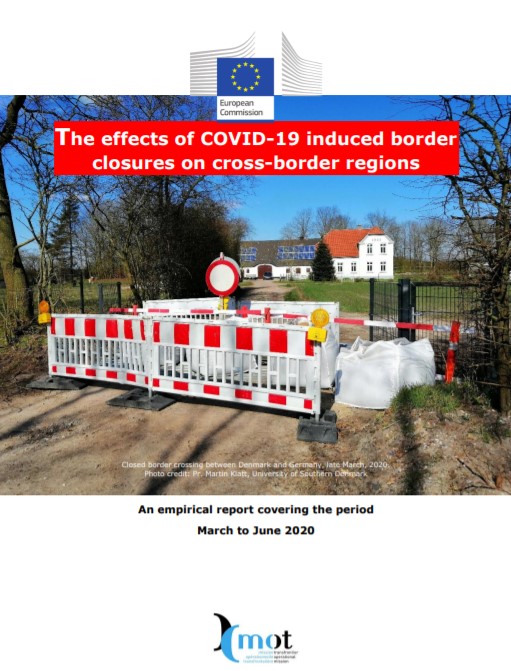 |
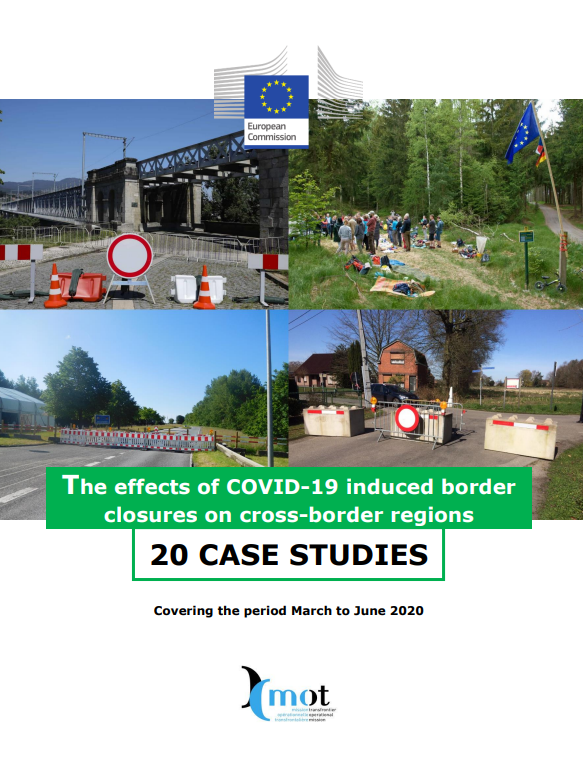 |

The project was funded by the Ministry of Justice.
The project documents and the conclusions and recommendations contained therein do not necessarily reflect the official position of the Promoter.
The 6th milestone of the Legal accessibility initiative (in 2021) includes three activities related to two topics:
- legal solution for the institutionalisation of urban agglomeration areas – comprehensive analysis
- legal accessibility among the Visegrad Countries – forum and conference
- compilation of the final report – in Hungarian and English.
The analysis of the first topic is justified by the fact that in parallel with the EU integration process, the borders become more and more permeable and, as a result, the services provided by nearly 100 urban centres located on both sides of the Hungarian borders are used by more and more people on both sides. This process has an impact not only on the service providers but also on the governance and funding schemes of the particular border area.
In 2019, with the involvement of the experts of the four countries, CESCI wrote a proposal on a legal accessibility mechanism to be set at Visegrad Four level. The negotiations on the initiative started at the beginning of 2020 at diplomatic level but have been interrupted by the coronavirus pandemic. In the second half of 2021 Hungary takes the rotating presidency of the V4 cooperation and CESCI intends to use this occasion for the popularisation and preparation of the mechanism.
Output indicators of the project
- Analysis of the existing French municipality-level solutions (in French and Hungarian) (1 study)
- Legal assessment of the adaptability of the French solutions to Hungary (1 study)
- Recommendations on the regulating background for the establishment of cross-border agglomerations (1 document)
- Recommendation on bilateral agreements on cross-border agglomerations (1 document)
- Total length of the analyses (100 pages)
- Conference on legal accessibility (1 event)
- Number of participants of the conference (60 persons)
- Professional summary of the forum and the conference in English (1 document)
- Final report of the project in Hungarian (1 document)
- Final report of the project in English (1 document)
More information on the planned activities are available at the following links:
- legal solution for the institutionalisation of urban agglomeration areas – comprehensive analysis
- legal accessibility among the Visegrad Countries – forum and conference
Legal solution for the institutionalisation of urban agglomeration areas
As part of the 6th milestone of the Legal accessibility project, a study involving French experts was carried out to take stock of the situation and governance models of cross-border conurbations in France, showing their modalities and legal frameworks and the underlying territorial dynamics.This study is significant as – although the structure of border settlements in France differs from those in Hungary – the experience gained there since the 1990s can be extremely useful for the development of the nearly 40 large, medium and small towns in Hungary that found themselves at the border as a result of Trianon, which has a perceptible negative impact on the development of these settlements and their catchment area.The study also provides benchmarks that can help strengthen the role of local actors – in cooperation with the relevant Hungarian authorities – in the governance model of cross-border agglomerations, so that they can have a greater impact on the development of their settlements and the surrounding areas.
The study can be downloaded in Hungarian and French by clicking on the covers below:
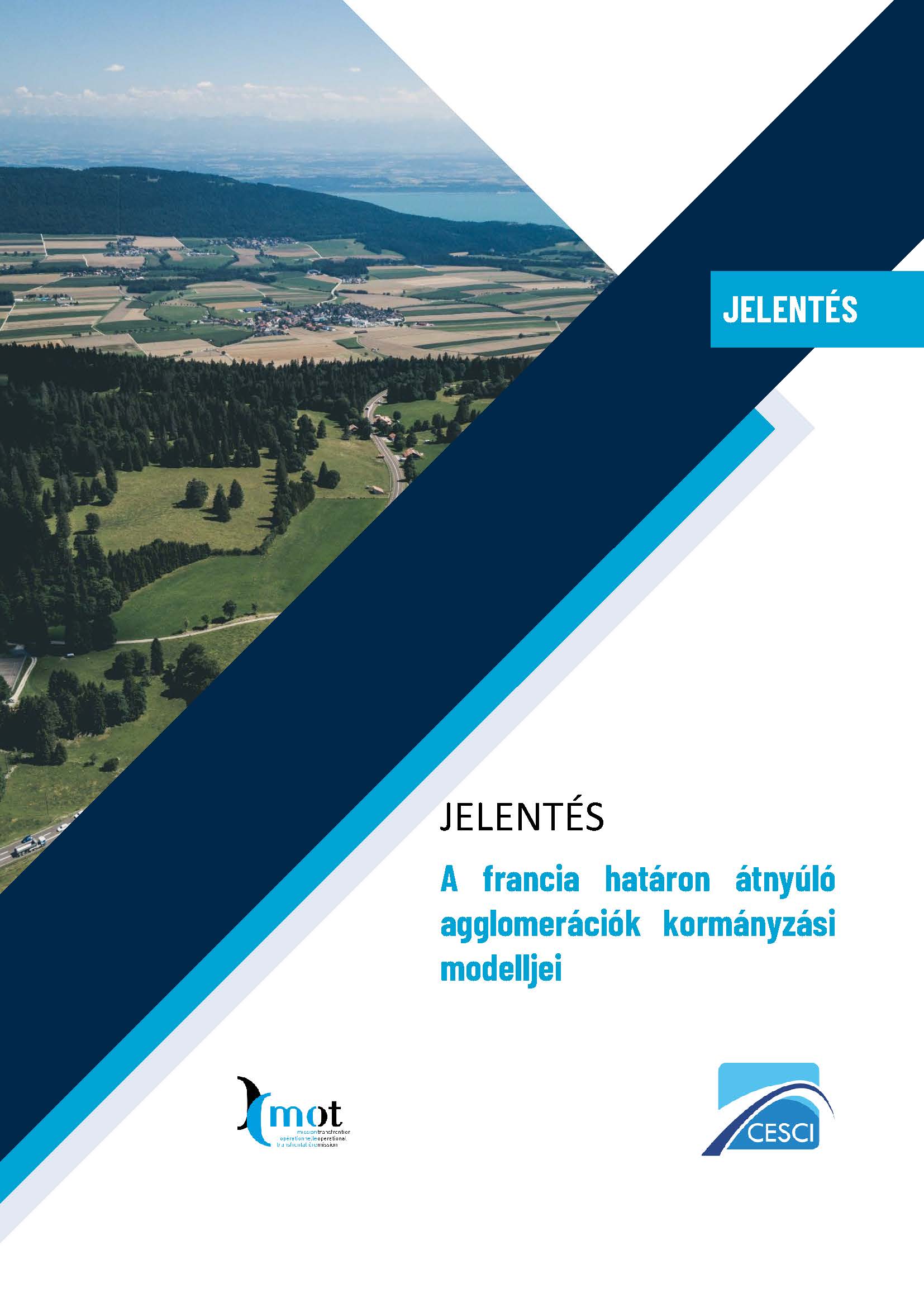 |
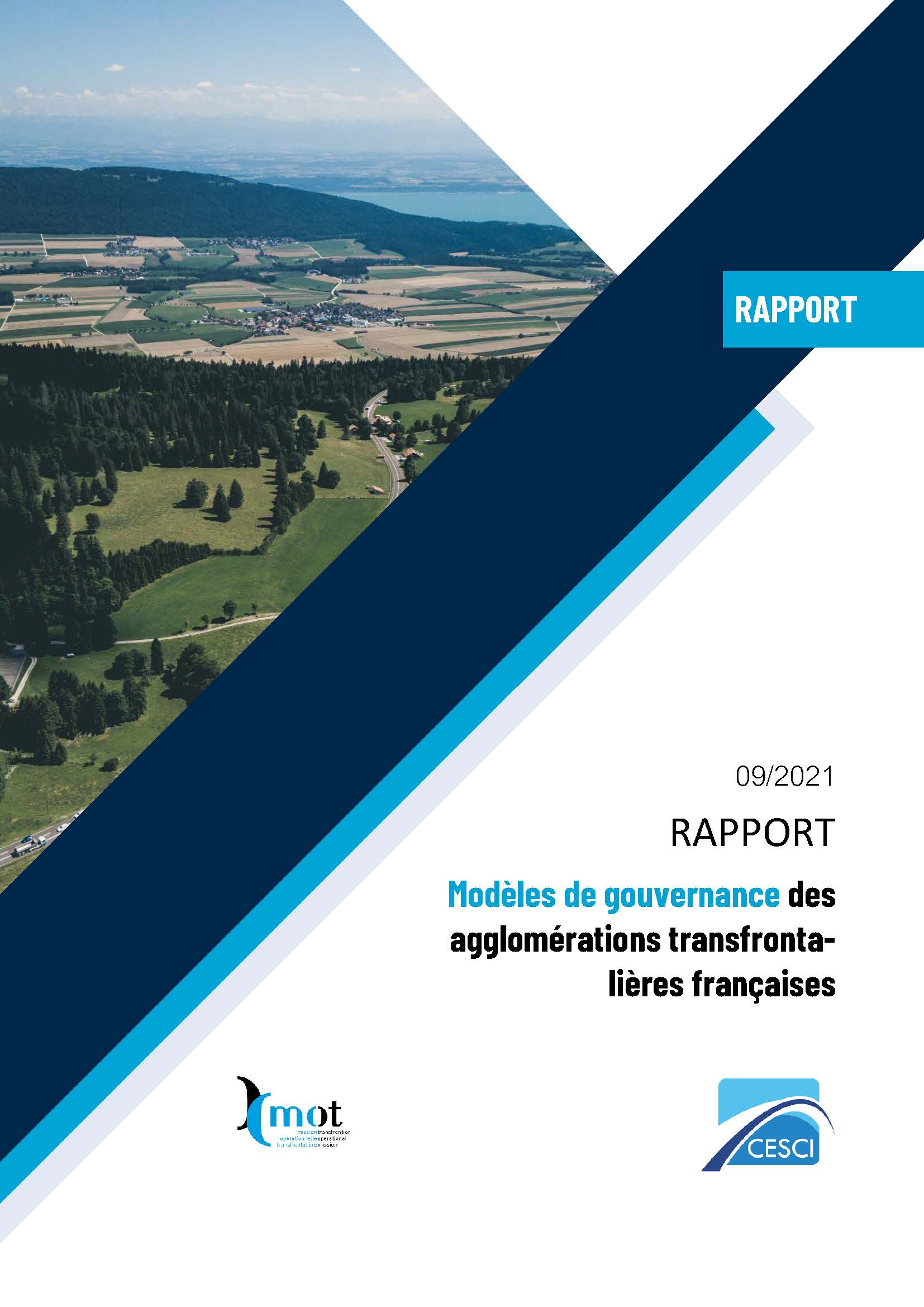 |
As part of the project, building on the French experience, an analysis with three chapters was also carried out. The aim of the studies is to provide ammunition for the institutionalisation of French-style urban cooperation along the Hungarian borders adapted to the Hungarian reality. The vast majority of border towns, despite the EU’s open internal borders, are in a peripheral position, as their organic influencing area and the administrative grid ensured by the national administrative system do not coincide. As they are not able to perform their spatial development functions in a 360 ° circle without hindrance, the operation of the local institutions cannot be ensured economically or they can be provided only within the administrative system of the given country, which is a foreseeable guarantee for gradual decline.
The analysis (in Hungarian) can be downloaded by clicking on the cover.
Legal accessibility among the Visegrad Countries
In 2020 CESCI informed firstly Mr Tibor Bial, the Ambassador of the Czech Republic to Budapest on the proposal regarding the legal accessibility mechanism of the Visegrad Countries. He welcomed the idea and he organised a meeting of the ambassadors of the three countries and the Hungarian Ministry of Foreign Affairs and Trade. Due to the pandemic, the meeting could not take place, it had to be postponed.
Within the framework of the current project, CESCI wanted to promote the process through the organisation of a forum and a conference. The two events obtain timely relevance by the adoption of the ECBM Regulation, and the closure of the B-Solutions project, both designed to take place in the second part of 2021, during the Slovenian presidency. The latter one gives an opportunity to withdraw a kind of balance, but it can also provide important lessons for the functioning of the mechanism to be established between the Visegrad countries.
The forum (in a form of a round-table discussion) is to be held with the participation of the three ambassadors and the representatives of the Hungarian Ministry of Justice and the Ministry of Foreign Affairs and Trade. The invited speakers of the conference are the participants of the European Commission (ECBM Regulation), the Association of European Border Regions (B-Solutions) and the regional actors implementing B-Solutions case studies. The main mission of the conference is to provide ammunition for the development of the Visegrad Four level mechanism.
The results of the event will be summarised in a professional document to be handed to the ministries of justice and foreign affairs and the relevant parliamentary committees of the four countries.
More information on the event’s website
The report on the event can be read here
The report prepared for the European Commission can be downloaded by clicking on the cover page:
Final report
The final report of the activities of the sixth milestone of the Legal Accessibility project can be reviewed by clicking on the cover page below:
The project is co-financed by the Governments of Czechia, Hungary, Poland and Slovakia through Visegrad Grants from International Visegrad Fund. The mission of the fund is to advance ideas for sustainable regional cooperation in Central Europe.
For more information please visit: www.visegradfund.org.
Legal accessibility among the V4 countries
Since its establishment in 1991 and mainly during the last few years, V4 became a regional brand known world-wide. At the same time, regardless of the efforts made by the V4 Fund, the cooperation hardly influences the population’s daily life: it is not simpler to work, to live, to study, to do business, to get married, etc. in other V4 countries.
During recent years, several initiatives have been taken in Europe with a view to diminishing or even eliminating the legal-administrative barriers still existing among the European countries. In this respect, the major project was the Cross-Border Review implemented by the DG Regio in 2015-2016. The project ended with a Communication of the European Commission (titled: Boosting Growth and Cohesion in EU Border Regions) published in September 2017 which will give a new impetus to the efforts in this field, where good examples exist at regional level, too. The most advanced regional cooperation can be detected at the Benelux cooperation and the Nordic Council. At the same time, at Visegrad Group no similar initiatives exist while internal mobility and cohesion should be strengthened.
The Nordic States set up the Free Movement Council in 2014 which every year identifies several legal obstacles hampering internal cohesion and selects some of them to be eliminated by the member countries, systematically. This model does not only strengthen regional cohesion by easing the regional mobility of workers, students, entrepreneurs and goods but, in parallel, provides concrete content for regional identity and regional brand building.
Similarly to the Benelux and Nordic cooperation, the project partners aim at laying the basis for permanent intergovernmental mechanisms enabling V4 governments to detect and eliminate those legal-administrative barriers hampering or making difficult to work, to study, to do business, to get married, to purchase goods, etc. in either countries of the V4 cooperation.
For this purpose, the partners will elaborate a study on the model of the Nordic Council (based on a study visit in Copenhagen and the available documents and literature), a proposal on the V4 Mobility Council (methodological, structural and operational factors) and an information and cooperation handbook (a guide on the set up of the proposed V4 level platform). The project objectives and results will be popularised through two conferences, an on-line campaign and a printed brochure. The European decision makers will be informed on the new initiative by an English summary of the project.
Project partners:
- Central European Service for Cross-border Initiatives (LP, Hungary),
- University of Szeged (HU),
- Central European Service for Cross-border Initiatives Carpathia (SK)
- Masaryk University Faculty of Science – Department of Geography (CZ),
- University of Warsaw – Centre for European Regional and Local Studies (PL).
Time frames
from 1st February, 2018 to 31st July, 2019
Indicators
- Study-tour to Copenhagen, to the secretariat of the Nordic Council (5 persons)
- Study on the obstacle removal system of the Nordic Council (1 study)
- Proposal on the obstacle removal system of the Visegrad countries: the V4 Mobility Council (1 study)
- Information and cooperation handbook on the creation of the V4 Mobility Council (1 handbook)
- English summary on the project (1 short study)
- Kick-off conference (1 conference, 40 participants)
- Closing conference (1 conference, 40 participants)
- Partners’ technical meetings (2 meetings)
- Project website
- Social media campaign
Project budget
| Share of the budget | CESCI | University of Szeged | CESCI Carpathia | Masaryk University | EUROREG | Total |
| TOTAL V4 contribution | 5 341 € | 5 141 € | 8 596 € | 1 829 € | 4 209 € | 25 115 € |
| TOTAL project cost | 8 241 € | 5 141 € | 8 596 € | 1 829 € | 5 209 € | 29 015 € |
V4 Documents
The detailed report on the study tour to the Nordic Council’s Secretariat is now available. You can download it by clicking on its cover.
Information and cooperation handbook (in English)
Proposal on the V4 Mobility Council (in English)
Study tour report (in Hungarian)
Analysis of the nordic model (angol nyelven)
The project is co-financed by the Governments of Czechia, Hungary, Poland and Slovakia through Visegrad Grants from International Visegrad Fund. The mission of the fund is to advance ideas for sustainable regional cooperation in Central Europe.

